
Home » Café Blog » Businessplan Café: was muss alles rein und wie du ihn erfolgreich schreibst [mit Vorlage]

Businessplan Café: was muss alles rein und wie du ihn erfolgreich schreibst [mit Vorlage]
Das Thema Businessplan Café ist für viele ein Angstgegner. Dabei hilft er dir mit Struktur als gutes Tool bei Deiner Café Gründung.
- von Thomas Kloppenborg

Teile den Artikel
Das Thema Businessplan Café ist gerade für die Gründung Deines eigenen Geschäfts ein ganz wesentliches Instrument. Leider ist die Erstellung eines Café Business Plan für viele aber auch eine Aufgabe, vor der sie Angst haben. Und das, obwohl das mit den richtigen Tipps und Tricks gar nicht so schwer ist. Die Angst können wir Dir also nehmen. Natürlich sollte der Businessplan für Cafés ordentlich und gewissenhaft erstellt werden, aber das ist mit einem guten Beispiel und einer Vorlage kein Problem. Und die Erstellung kann sogar Spaß machen. Zudem hilft dir dein Businessplan tatsächlich super während der Gründung. Wie genau Du einen schreibst und was alles rein sollte, damit Dein Businessplan erfolgreich und hilfreich ist, erfährst Du hier.
Inhaltsverzeichnis
Businessplan café: warum, was und wie.
Wir haben uns in den vorherigen Artikeln ausgiebig mit dem Thema „ Café Eröffnung “ beschäftigt. Gedankliches Pingpong exerziert, Worst- und Best-Case-Szenarien abgespult und wir könnten noch länger um den heißen Brei scharwenzeln, aber das ist absolut unbefriedigend!
Skippen wir also zu dem Teil und stellen uns dem Businessplan für eine Café Gründung. Auch wenn es sich anfühlt wie ein verfrühter Endgegner, ist aber diese erste Hürde überwunden, dann ist ein großer Stein schon mal in Wallung geraten. Also, los geht’s!
Falls Du doch mehr lesen willst:
- Die Checkliste zum Café eröffnen als Schritt für Schritt Anleitung
- Worauf du achten solltest, wenn du ohne Erfahrung ein eigenes Café aufmachen willst
1. Warum solltest Du einen Café Businessplan schreiben?
Fangen wir erst einmal bei Dir selbst an: Du hast eben diese Idee, Vorstellung, Traum … diese mutieren schnell zu Illusionen, Luftschlössern und Utopien, die mehr frustrieren als motivieren. Genau hier fängt es an – schaffe Dir einen Überblick von dem, was Dir wichtig ist. Sortier Deine Gedanken und Ideen. Was macht DEIN Café besonders? Wie viel Geld gedenkst Du zu verdienen? Und vor allem: stell Dir vor, Du musst Dein Vorhaben einem Kleinkind erzählen. Halte es einfach und nachvollziehbar. Genau das ist die Aufgabe eines Businessplan für Cafés. Damit erreichst Du dann auch alle anderen …
2. Für wen genau schreibst du Deinen Café Businessplan?
Der Investor/Geldgeber will wissen, worin investiert/finanziert wird. Es geht hier um Sicherheit. Der Makler/Verpächter will ebenfalls eine Sicherheit, ob Dein Café Konzept zum Gebäude und der Lage passt. Die Handwerker/Ladenbauer müssen einen Plan aufsetzen, wie die Einrichtung und die Räumlichkeiten zur Unternehmung passen. Die Lieferanten müssen ebenfalls gebrieft sein, damit die Zutaten/Produkte auch zu Deinem Angebot passen. Schlussendlich müssen Du und Dein zukünftiges Team wissen, was gemacht werden soll und vor allem wie. Ganz schön viele Fragen … hier haben wir aber alles schon sortiert und strukturiert aufgesetzt.
3. Wie solltest Du den Café Businessplan schreiben?
Ein Businessplan ist wie eine Geschichte oder ein Buch, das einen direkt „mitnehmen“ soll. Würdest Du Dir etwas anschauen oder Dich mit etwas befassen, was Dich nicht anspricht oder Dein Interesse weckt? Warum sollte es demjenigen anders gehen, der Dich bei Deinem Vorhaben unterstützen soll? Gut strukturiert lässt es sich leichter für Dich „aufbauen“ und schlussendlich für Dein Gegenüber nachvollziehen, was genau Deine Café Idee ist. Denn genau das ist der Inhalt des Businessplans. Welche Detail rein gehören, erfährst Du weiter unten.
4. Was ist der Unterschied zwischen einem Café Konzept und einem Business Plan?
Der Businessplan für ein Café wird gerne auch mit dem Café Konzept verwechselt. Beide sind eng miteinander verwandt, werden aber durchaus unterschiedlich genutzt. Ein gutes Café Konzept und auch ein starker Businessplan legen die Grundlage für Deinen Erfolg. Das Konzept für Dein Café beschreibt auf kreative Art und Weise, was Du Dir für Dein eigenes Café vorstellst. Deine Vision, Atmosphäre, Identität, Zielgruppe usw. Das Konzeptpapier gibt Dir selbst Halt und Struktur. Der Businessplan zum Café gründen beinhaltet über das Konzept hinaus auch noch finanzielle Kennzahlen, Ziele, Risiken, Marktinformationen und Gewinnprognosen. Der Businessplan ist insbesondere dafür gedacht, Investoren von Deiner Café Idee zu überzeugen. Ganz simpel der Plan für Dein Café Business.
Wie der Café Businessplan konkret aussieht
Der Businessplan für eine Café Gründung ist ein strukturiertes Dokument, das mehrere Themen beinhaltet, um Dein Vorhaben klar und deutlich zu beschreiben. Zum Einen formulierst Du klar Deine Café Idee, damit sie andere verstehen. Zum Anderen beschreibst Du das Marktumfeld und wie Du Deine Idee umsetzen willst. Im Prinzip geht es darum, Deine Idee nachvollziehbar zu formulieren. Deshalb kommt alles in Deinen Businessplan, was dafür notwendig ist und Dir hilft, die wichtigsten Personen, wie Geldgeber, von Deinem Vorhaben zu überzeugen. Hier haben wir Dir eine mögliche inhaltliche Struktur aufgebaut.

TEIL 1: Struktur und Aufbau des Café Business Plan
sieht gut aus und macht einen ordentlichen Eindruck | Es ist wie ein passendes Outfit, mit dem DU DICH wohl fühlst und repräsentierst
INHALTSVERZEICHNIS
gibt eine Übersicht und hilft Dir, die Punkte aufzubereiten | und es gibt Deinem Vorhaben eine Struktur
Formalität, die Dich identifiziert | Name, Anschrift, Kontakt
Kurz und Knapp: Gründer, Vorhaben, Standort, Firmenname & Rechtsform, Start, Kapitalbedarf (Investitionssumme), Finanzierung (Eigen- & Fremdkapital), Umsatz- und Rentabilitätsvorschau*
TEIL 2: Businesspoints in Deinem Plan
Unternehmen.
Beschreibe Dein Vorhaben (Café, Cafébar, Bistro etc. / Produkte, USP, Service, Zielgruppe / Ziele)
ANTRIEB/PROFIL
Warum willst Du Dich verwirklichen (Idee, Antrieb, Perspektive, Qualifikation, Erfahrungen)
UNTERNEHMENSFORM
welche Rechtsform soll es werden. Bist Du alleine oder in einer „Gesellschaft“ mit definierten Verantwortungsbereichen? Gibt es Aufgabenbereiche, die genau bestimmt sind? Diese Punkte sollten im Vorfeld definiert sein, damit es später nicht zu ungewollten Missverständnissen kommt.
MARKTANALYSE UND UMFELD
Schätze das Segment ein, Mitbewerber/Wettbewerb, Zielgruppen-Analyse (abhängig von Standort und Angeboten), Trends, Entwicklung und Bedürfnisse
MARKETING / VERTRIEB
definiere die Preis- und Produktrange (High-, Mid- oder Lowcost Segment), Aufgreifen der Idee und des Konzept um zielgerichtet Strategien auszuarbeiten (Print, Social Media, Instore), Entwicklung der persönlichen Kommunikation (Aufbau CI & CD)
PRODUKTE / ANGEBOT
abhängig vom Angebot und der Warengruppe wird die Produktion und Etablierung der Produkte definiert
braucht Dein Café viel Platz? Oder eine gut frequentierte Lage? Laden-/Raumgröße, Stell-Lagerflächen und/oder Produktionsflächen, Aussenbereiche … vorhandene Gerätebasierende Infrastruktur (Abluft, Abwasser, Fettabscheider etc.). benötigst Du speziell Anforderung an den Bebauungsplan oder das Nutzungsrecht der Immobilie?
BETRIEBSFÜHRUNG / PROZESSE
Öffnungszeiten und Geschäftsablauf
PRODUKTION / WARENBEZUG
ebenso hat das Produktangebot direkten Einfluss auf die Gerätschaften (Küche, Lager, etc.). Wird selbst hergestellt oder braucht es Kapazitäten für Convenience …?
RISIKOANALYE
Markenrechte sichern, Haftungsausschlüsse, Personalmangel …
Bedarfsanalyse, Planung und Personalmanagement, Schulungsmaßnahmen …
FINANZWIRTSCHAFTLICHE PLANUNG
im ersten Teil hast Du schon eine grobe Kalkulation bzw. eine Umsatz-Prognose erstellt. Diese wird an dieser Stelle detaillierter ausfallen. … TIP: Mache diese Kalkulation zuerst und setze dann die „Endsummen“ Prognose aus der Berechnung in den Teil „STRUKTUR & AUFBAU”*
*Der Punkt mit der Finanzierung und Umsatzprognose (Rentabilitätsvorschau) ist tatsächlich etwas kniffliger. Aber auch das ist kein Hexenwerk. Versuche eine mögliche Umsatzentwicklung Deines Vorhabens aufzustellen, damit Du einen Anhaltspunkt hast, mit dem Du und Dein Finanzberater/Bänker/Investor im späteren Verlauf kalkulieren könnt.
TEIL 3: Der Anhang zu Deinem Business Plan fürs Café
In den Anhang kommen weitere wichtige Unterlagen, wie Bauzeichnungen, detaillierte Berechnungen und alles, was eventuell noch wertvoll in einer Diskussion mit interessierten Personengruppen ist. Auch Bilder, Rezepte und was auch immer Du denkst, dass Du sinnvoll zum Businessplan für Dein Café beilegen solltest.

Was Dir auch noch helfen kann:
- Welche verkaufsfördernden Maßnahmen in der Gastro gerne eingesetzt werden
- Café Franchise als Möglichkeit ein eigenes Café zu eröffnen
Welchen Umfang sollte Dein Café Business Plan haben?
Eines Vorweg: Es muss kein Café Gründung Businessplan Roman werden! Auf den ersten Blick mag der Umfang viel aussehen. Das Wichtigste ist, dass Du die Themen und Kapitel angehst und die wichtigsten Inhalte rein schreibst. 10 Seiten können schon vollkommen ausreichen, um die Inhalte ausreichend zu beschreiben. Außerdem kannst Du auch mit Bildern und Zeichnungen arbeiten. Die geben Deinem Businessplan durchaus das gewisse Etwas. Und lass gerne mal jemanden gegenlesen, ob den Personen was fehlt oder ob Fragen aufkommen. Falls Du Fragen hast, oder Unterstützung in Form einer Gastro Beratung möchtest, kannst Du uns auch gerne über den Button unten eine Anfrage schicken. Wir helfen Dir gerne weiter.
Café Businessplan Vorlage von mamfito
Wir haben Dir hier eine Businessplan Cafe Vorlage hinterlegt, die Dir hilft diese Punkte einfach zu erfassen. Damit bekommst Du auch gleichzeitig ein Beispiel, wie ein Businessplan Muster aussehen sollte. Es liegt jetzt an Dir, Deinen persönlichen Startpunkt für Deine Café Gründung zu setzen! An sich gibt’s jetzt keine Ausreden mehr …
FAZIT: Der Businessplan für ein Café ist kein schwerer Endgegner, sondern ein super Tool, das Dir Struktur gibt
Der Businessplan für Dein Café ist für viele in der Tat erstmal der Endgegner, der Angst macht. Am Ende ist der Businessplan aber auch nur eine kleine weitere Aufgabe, auf Deinem Weg zum eigenen Café. Und tatsächlich hilft Dir die Übung, Deine Gedanken und Ideen zu strukturieren und professionell aufzubereiten. Insbesondere auch, um damit dann später mögliche Investoren von Deiner Café Idee zu überzeugen. Und auch, um mit anderen wichtigen Personengruppen und Lieferanten in Gespräche zu gehen, während Du Dein Café aufbaust. Du wächst mit der Aufgabe und ehrlich gesagt, ist es am Ende eigentlich auch nur ein Runterschreiben der Punkte, die Du ohnehin bearbeiten musst, um ein Café erfolgreich zu eröffnen. Wenn Du möchtest, kannst du auch gerne unsere Café Businessplan Vorlage nutzen.
Was auch interessant für Dich sein könnte:
- Wie gute Gastronomie Werbung geht
- Online Marketing in der Gastronomie: was es alles zu wissen gibt
- Digitalisierung in der Gastronomie
Weitere Infos und Links zum Thema
Alles weitere Rund um die Gastronomie findest du auf unserem Gastronomie Blog .
Vergiss nicht den Artikel zu teilen!

Café eröffnen Kosten: Womit du rechnen musst und wie du dein Startkapital kalkulierst
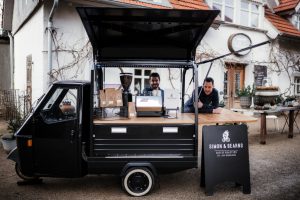
Ein eigenes Café eröffnen: Erfahrungen und Tipps von einem erfolgreichen Gründer
Verpass keine infos.
Schreib Dich in unseren Newsletter ein und erfahre als erstes, wenn es neue Artikel und Informationen zum Thema Gastronomie gibt.
- Businessplan
Businessplan Café: Wie du einen guten Plan erstellst
Mit einem gut sortierten Businessplan ein gemütliches und trendiges Café auf die Beine stellen, ist der beste Weg zu zufriedenen Gästen, Umsatz und Erfolg. Nicht nur die Wahl des Kaffee und der leckeren Kuchen oder Snacks steht dabei auf dem Programm. Auch Ambiente, Küchentechnik, Personal, Marketing und die Finanzen gilt es klar zu strukturieren.
Du suchst Businessplan Vorlagen und Muster?
Was ist ein businessplan und für wen brauche ich in der gastronomie einen businessplan.
Gastronomie ist harte Arbeit, auch wenn dein geplantes Café sehr klein ist. Umso wichtiger ist es, dass du dich vor der Existenzgründung eines Cafés mit allen relevanten Punkten beschäftigst, um später nicht überrascht zu werden.
In der Planungsphase ist daher ein Businessplan für dein neues Café hilfreich. Während der Erstellung hast du die Chance, dich mit allen Themen, angefangen von der Finanzierung bis hin zum konkreten Konzept für dein Lokal zu beschäftigen. Dafür geben wir dir hiermit ein Businessplan Muster an die Hand.
Ein fertiger Businessplan kann auch sehr nützlich zur Vorlage gegenüber potentiellen Geschäftspartnern sein:
- zur Beantragung von Finanzierungen oder Fördermitteln bei Banken,
- Kooperationen und Kredite von Getränkelieferanten,
- zur Beantragung des Gründungszuschusses bei der Arbeitsagentur,
- bei Übernahme eines bestehenden Cafés.
Inhalte eines Businessplans für ein Café
Ein Businessplan hat diverse formelle und inhaltliche Anforderungen, die unabhängig davon gelten, ob du ein Café, einen Friseursalon oder einen Kiosk eröffnest. Wichtig ist deshalb vor allem, die einzelnen Punkte sehr individuell zu beleuchten und dein Konzept entsprechend der Branche klar zu beschreiben.
1. Zusammenfassung deines Café-Konzeptes
Dieser Teil des Businessplans ist eine Zusammenfassung aller Informationen zu dir als Gründer und deinem geplanten Café-Konzept. Am einfachsten lässt sich dieser Abschnitt formulieren, wenn der übrige Businessplan schon steht. So stellst du sicher, dass du keine wichtigen Informationen vergisst.
2. Gründerprofil
Gerade in der Gastronomie gibt es einige behördliche Voraussetzungen, die bei der Planung zu beachten sind. Die Kenntnis über behördliche Voraussetzungen ist aber nur die Basis. In diesem Kapitel musst du vor allem dafür sorgen, dass der Leser von dir als Gründer und zukünftigem Café-Betreiber überzeugt wird.
Berichte in diesem Abschnitt von deinen Stärken, die du mitbringst, um deinen Plan erfolgreich umzusetzen und ein gut laufendes Café zu betreiben. Verschweige aber nicht eventuelle Schwächen, sondern beschreibe, wie du planst diese für dein Geschäft zu beseitigen, etwa durch Weiterbildungen, Personal oder Berater.
3. Geschäftsidee und Zielgruppe
In diesem Kapitel des Geschäftsplans geht es nun endlich um deine konkrete Geschäftsidee. Stelle dabei deine Zielgruppe in den Mittelpunkt. Wen willst du mit deinem Café-Konzept insbesondere ansprechen?.
Beschreibe, wie das Konzept für dein Café ausehen soll. Welche Speisen willst du anbieten? Welche Besonderheiten wird es geben, wie etwa vegane Angebote, zuckerfreie Kuchen etc.?
Hast du schon eine Kaffeerösterei als Partner in Planung oder wirst du den Kaffee sogar selbst rösten? Beschreibe hier auch, welche saisonalen Unterschiede es bei Getränken und Speisen geben soll.
Erkläre hier auch gern schon besondere Abläufe, etwa wo der Kuchen bezogen werden soll, wie die Ausstattung und das Ambiente in deinem Café aussehen soll, sprich, was dich konkret vom Wettbewerb abhebt.
Hast du keine Idee, wie du das mit deinem eigenen Café angehen sollst, dann lohnt es sich bei den Franchisegebern mal umszuschauen. Hier gibt es ganz viele verschiedene Franchisekonzepte, welche du umsetzen kannst. Der Vorteil bei einem Franchising ist, dass du auf ein erprobtes Geschäftsmodell umsetzen kannst und dabei aktive Hilfe bekommst.
4. Markt und Wettbewerb
Der Markt des Gaststättengewerbes ist riesig. Laut dem DEHOGA Bundesverband gab es im Jahr 2019 rund 11.761 Cafés in Deutschland.
Deshalb ist es wichtig, dass du dich detailiert mit deinem geplanten Standort und dem dort vorhandenen Wettbewerb befasst. Nutze die Chance, sich genaue Gedanken dazu zu machen, wie der Wettbewerb rund um deinen Standort aussieht und wie du dich mit deinem Konzept davon abheben willst. Ist noch Bedarf in dem lokalen Markt oder gilt es bestehende Player mit einem besseren Konzept zu verdrängen, bzw. ihnen Marktanteile abzujagen.
5. Marketing und Vertrieb
Dieser Bereich ist besonders wichtig im Businessplan, schließlich nützt das schönste Café nichts, wenn es niemand kennt und dich zu wenig Gäste besuchen.
Überlege an dieser Stelle also genau, wie du es schaffen kannst, durch clevere Kooperationen und Werbemassnahmen auf dich aufmerksam zu machen. Zum Marketing gehört aber auch immer eine zur Zielgruppe und zum Wettbewerb passende Preisstrategie.
Beachte in deinem Marketing Konzept die wichtigsten Faktoren (4 P´s):
- Produkt ( P roduct)
- Preis ( P rice)
- Standort ( P lace)
- Werbung ( P romotion)
Beschreibe in dem Kapitel, wie du planst, auf dich aufmerksam zu machen, etwa mittels Social Media Aktionen wie einem eigenen Instagram Profil für das Café oder PR in lokalen Medien welche deine Zielgruppe konsumiert.
6. Unternehmensorganisation
Plane in diesem Teil deines Unternehmenskonzepts voraus, wie dein Café zukünftig organisiert werden soll. Wie viele Mitarbeiter wirst du in welcher Anstellungsart benötigen? Welche Aufgaben übernimmst du selbst und welche Produkte werden geliefert? Wie sollen deine Öffnungszeiten aussehen?
Zur Unternehmensorganisation gehört im Gastronomiebereich auch das Thema Recht. Für nahezu alle Existenzgründer im Gastrobereich gilt das Gaststättengesetz. Eine Konzession/ Gaststättenerlaubnis ist im Allgemeinen immer dann zwingend notwendig, wenn Alkohol ausgeschenkt, Essen zubereitet und am gleichen Ort verzehrt wird. Wird im Café kein Alkohol ausgeschenkt, ist je nach Bundesland zwar keine Konzession nötig, das Café gilt aber trotzdem als Gaststätte und unterliegt dann der Anzeigepflicht laut Gewerbeordnung. Auch bei solchen ggf. erlaubnisfreien Gaststätten gelten dann nach wie vor die Verordnungen des Gaststättengesetzes. Prüfe im Vorfeld also genau die Auflagen deines Bundeslandes und ob du eine Konzession benötigst.
Unabhängig von der Notwendigkeit einer Konzession sind weitere Vorschriften zu beachten, die zum Teil vom Veterinär- und Lebensmittelaufsichtsamt geprüft werden:
- Unterweisung durch das Gesundheitsamt und Belehrung der Mitarbeiter nach dem Infektionsschutzgesetz (IfSG)
- Räumlichkeiten inkl. Küche und Lager müssen den Anforderungen der EU-Verordnung zur Lebensmittelhygiene entsprechen. Mitarbeiter müssen zudem nach dieser EU-Verordnung geschult werden.
- Verbrauchsfristen und Regeln zur Warenpflege (Lagerung, Kühlung) sind einzuhalten
- Korrekte Abfallentsorgung
- Verordnung zur Regelung von Preisangaben (Einhalten von Regeln zur Preiskalkulation der im Café angebotenen Produkte und transparente Kommunikation der Preise gegenüber dem Gast)
Zeige hier auf, dass du dich mit dem Thema im Detail auseinandergesetzt hast. Du solltest genau wissen, welche rechtlichen Vorschriften auf dich zukommen und wie du planst, diese in deinem Café umzusetzen.
7. SWOT Analyse
In diesem Kapitel liegt der Fokus auf der Bewertung der Stärken, Schwächen, Chancen und Risiken (auf englisch SWOT) deines Unternehmens. Zeige hier vor allem auch auf, wie du mit Hilfe deiner Stärken die Risiken mildern und die Chancen optimal nutzen willst.
8. Finanzierung
Neben dem Konzept für dein Café ist die finanzielle Planung einer der wichtigsten Businessplan Inhalte . In diesem Zahlenteil des Businessplans kannst du die finanzielle Entwicklung deines Cafés, von der kostenintensiven Startphase bis hin zum Verlauf der nächsten Jahre planen.
Falls du für den Start deines Cafés Fremdkapital benötigst, prüfe vorab auch, ob ein Bankkredit die einzige Möglichkeit für dich ist oder ob du Kredite/ Kommisionen auch durch Verträge mit Getränkelieferanten erhalten kannst. Werde kreativ. Teilweise verwenden Cafés auch Designermöbel zur Ausstattung, die vom Label selbst gestellt werden und dann auch in deinem Lokal direkt gekauft werden können.
Du musst du unbedingt prüfen, ob du staatliche Zuschüsse oder Fördermittel beantragen kannst. Schliesslich solltest du bei der Planung alle relevanten Investitionen und laufenden Kosten bedenken.
Dabei sollten sowohl einmalige Gründungskosten als auch laufende Kosten bedacht werden. Einige Beispiele zu planender Kosten:
Einmalige Ausgaben
- Ausstattung des Gästebereichs im Café (Bestuhlung, Tische, Dekoration)
- Ggf. Renovierungskosten
- Ausstattung der Theke, inkl. Geräte wie Kaffeemaschine etc.
- Kücheneinrichtung
- Ausstattung für Service (Teller, Besteck, Gläser)
- Erstellung einer Webseite sowie weitere Marketingmaßnahmen
- Design eines Logos und der Speisekarten
- Gebühren für Genehmigungen
Laufende Ausgaben
- Miete für die Räumlichkeiten des Cafés
- Gehälter
- Wareneinkauf
- Gebühren (z.B. GEMA)
- Dein eigenes Gehalt und anfallende Kosten wie Kranken- und Pflegeversicherung
- Versicherungen
- Ausgaben für Werbung
Dank unserem Businessplantool schneller ans Ziel
Aus den vielen Businessplan Beispielen können Sie sich händig einen Businessplan für Ihr Café erstellen. Noch einfacher geht es über unser Businessplan Tool. Darin finden Sie zahlreiche Textbausteine, die schon fertig sind und nur darauf warten, individuell auf Ihr Konzept angepasst zu werden. Im Ergebnis erhalten Sie einen fertig formatierten, umfassenden Businessplan. Und das kostenlos.
Zu unserem Businessplan-Tool
Das könnte sie auch interessieren.
Businessplan Muster kostenfrei, für alle Branchen
Ein Businessplan Muster spart dir Zeit und Unannehmlichkeiten bei der Erstellung deines individuellen Businessplans für deine eigene Geschäftsidee. Was gehört in meinen Businessplan? Was muss ich bei den einzelnen Abschnitten beachten? Wie ist die Anordnung? All diese Fragen bekommst du einfach durch unsere Businessplan Muster beantwortet.
Businessplan kostenfrei erstellen
Ein Businessplan ist Muss für jeden Gründer und Unternehmer, denn er legt den Grundstein sowie die Richtschnur für das eigene Unternehmen. Dabei gilt es ihn ständig anzupassen. Zusätzlich wird er für die Beantragung von Finanzhilfen und anderen Massnahmen benötigt. Schritt für Schritt begleiten wir dich auf dem Weg zu deinem eigenen Businessplan.
Businessplan kostenfrei erstellen: Beispiele, Muster, Vorlagen
Businessplan Vorlagen, Muster, Beispiele für die erfolgreiche und schnelle Erstellung deines individuellen Businessplans, Geschäftsplans, bzw. Unternehmenskonzeptes. Wir stellen dir hier erprobte Businessplan Muster, Businessplan Vorlagen und Businessplan Beispiele vor. Entsprechend deines Vorhabens präsentieren wir dir Aufbau und spezielle Inhalte.
René Wendler
René hat die letzten 20 Jahre erfolgreich Geschäftsmodelle zur Betreuung von Gründern und Unternehmern aufgebaut. Damals wie heute adressiert er gemeinsam mit seinem Team Solo-Selbstständige und Unternehmen mit weniger als 10 Mitarbeitern, welche weder die mediale noch politische Aufmerksamkeit haben, obwohl sie 95% aller Unternehmen in Deutschland stellen und 60% aller Arbeitsplätze absichern. Daraus entstanden ist auch unternehmenswelt.de, die mittlerweile größte Anlaufstelle für Gründer und Unternehmer in der D/A/CH Region mit über 500.000 Mitgliedern.
How to write a business plan for a café?
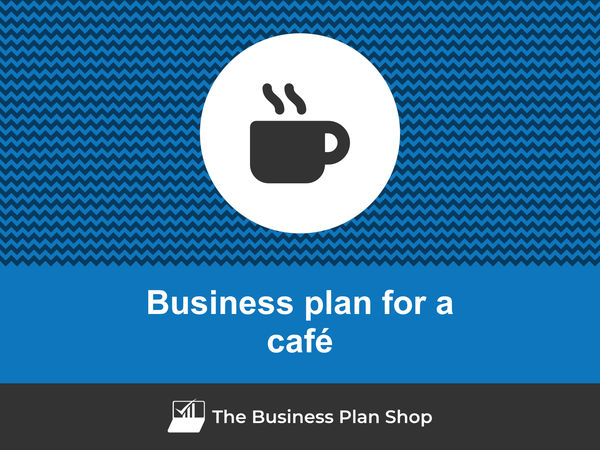
Putting together a business plan for a café can be daunting - especially if you're creating a business for the first time - but with this comprehensive guide, you'll have the necessary tools to do it confidently.
We will explore why writing one is so important in both starting up and growing an existing café, as well as what should go into making an effective plan - from its structure to content - and what tools can be used to streamline the process and avoid errors.
Without further ado, let us begin!
In this guide:
Why write a business plan for a café?
- What information is needed to create a business plan for a café?
- How do I build a financial forecast for a café?
The written part of a café business plan
- What tool should I use to write my café business plan?
Having a clear understanding of why you want to write a business plan for your café will make it simpler for you to grasp the rationale behind its structure and content. So before delving into the plan's actual details, let's take a moment to remind ourselves of the primary reasons why you'd want to create a café business plan.
To have a clear roadmap to grow the business
Small businesses rarely experience a constant and predictable environment. Economic cycles go up and down, while the business landscape is mutating constantly with new regulations, technologies, competitors, and consumer behaviours emerging when we least expect it.
In this dynamic context, it's essential to have a clear roadmap for your café. Otherwise, you are navigating in the dark which is dangerous given that - as a business owner - your capital is at risk.
That's why crafting a well-thought-out business plan is crucial to ensure the long-term success and sustainability of your venture.
To create an effective business plan, you'll need to take a step-by-step approach. First, you'll have to assess your current position (if you're already in business), and then identify where you'd like your café to be in the next three to five years.
Once you have a clear destination for your café, you'll focus on three key areas:
- Resources: you'll determine the human, equipment, and capital resources needed to reach your goals successfully.
- Speed: you'll establish the optimal pace at which your business needs to grow if it is to meet its objectives within the desired timeframe.
- Risks: you'll identify and address potential risks you might encounter along the way.
By going through this process regularly, you'll be able to make informed decisions about resource allocation, paving the way for the long-term success of your business.
To anticipate future cash flows
Regularly comparing your actual financial performance to the projections in the financial forecast of your café's business plan gives you the ability to monitor your business's financial health and make necessary adjustments as needed.
This practice allows you to detect potential financial issues, such as unexpected cash shortfalls before they escalate into major problems. Giving you time to find additional financing or put in place corrective measures.
Additionally, it helps you identify growth opportunities, like excess cash flow that could be allocated to launch new products and services or expand into new markets.
Staying on track with these regular comparisons enables you to make well-informed decisions about the amount of financing your business might require, or the excess cash flow you can expect to generate from your main business activities.
To secure financing
Crafting a comprehensive business plan for your café, whether you're starting up or already established, is paramount when you're seeking financing from banks or investors.
Given how fragile small businesses are, financiers will want to ensure that you have a clear roadmap in place as well as command and control of your future cash flows before entertaining the idea of funding you.
For banks, the information in your business plan will be used to assess your borrowing capacity - which is defined as the maximum amount of debt your business can afford alongside your ability to repay the loan. This evaluation helps them decide whether to extend credit to your business and under what terms (interest rate, duration, repayment options, collateral, etc.).
Similarly, investors will thoroughly review your plan to determine if their investment can yield an attractive return. They'll be looking for evidence that your café has the potential for healthy growth, profitability, and consistent cash flow generation over time.
Now that you understand the importance of creating a business plan for your café, let's delve into the necessary information needed to craft an effective plan.
Need a convincing business plan?
The Business Plan Shop makes it easy to create a financial forecast to assess the potential profitability of your projects, and write a business plan that’ll wow investors.

Information needed to create a business plan for a café
You need the right data in order to project sales, investments and costs accurately in the financial forecast of your café business plan.
Below, we'll cover three key pieces of information you should gather before drafting your business plan.
Carrying out market research for a café
Before you begin writing your business plan for a café, conducting market research is a critical step in ensuring precise and realistic financial projections.
Market research grants you valuable insights into your target customer base, competitors, pricing strategies, and other crucial factors that can impact the success of your business.
In the course of this research, you may stumble upon trends that could impact your café.
You might discover that customers may be interested in a wider range of specialty drinks, such as smoothies or milkshakes. Additionally, market research could reveal that customers may prefer healthier snack options, like salads or fruit bowls.
Such market trends play a pivotal role in revenue forecasting, as they provide essential data regarding potential customers' spending habits and preferences.
By integrating these findings into your financial projections, you can provide investors with more accurate information, enabling them to make well-informed decisions about investing in your café.
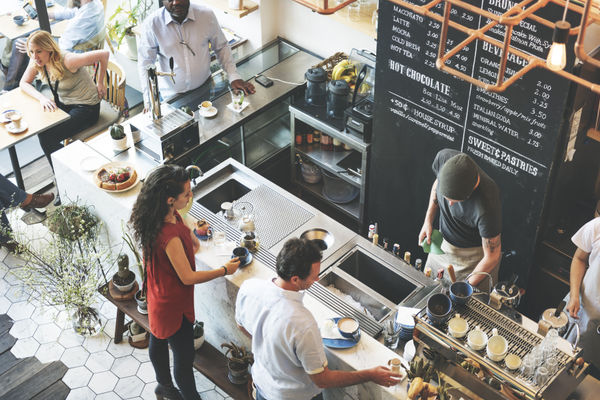
Developing the sales and marketing plan for a café
As you embark on creating your café business plan, it is crucial to budget sales and marketing expenses beforehand.
A well-defined sales and marketing plan should include precise projections of the actions required to acquire and retain customers. It will also outline the necessary workforce to execute these initiatives and the budget required for promotions, advertising, and other marketing efforts.
This approach ensures that the appropriate amount of resources is allocated to these activities, aligning with the sales and growth objectives outlined in your business plan.
The staffing and equipment needs of a café
Whether you are at the beginning stages of your café or expanding its horizons, having a clear plan for recruitment and capital expenditures (investment in equipment and real estate) is vital to ensure your business's success.
To achieve this, both the recruitment and investment plans must align coherently with the projected timing and level of growth in your forecast. It is essential to secure appropriate funding for these plans.
Staffing costs for a cafe might include wages for baristas, cooks, and cashiers, as well as insurance for the staff. Equipment costs could include items such as an espresso machine, refrigerators, ovens, and other necessary kitchen appliances. Additionally, costs for furniture and fixtures, such as tables, chairs, and displays, may be incurred.
To create a financial forecast that accurately represents your business's outlook, remember to factor in other day-to-day operating expenses.
Now that you have all the necessary information, it's time to dive in and start creating your business plan and developing the financial forecast for your café.
What goes into your café's financial forecast?
The objective of the financial forecast of your café's business plan is to show the growth, profitability, funding requirements, and cash generation potential of your business over the next 3 to 5 years.
The four key outputs of a financial forecast for a café are:
- The profit and loss (P&L) statement ,
- The projected balance sheet ,
- The cash flow forecast ,
- And the sources and uses table .
Let's look at each of these in a bit more detail.
The projected P&L statement
The projected P&L statement for a café shows how much revenue and profit your business is expected to make in the future.
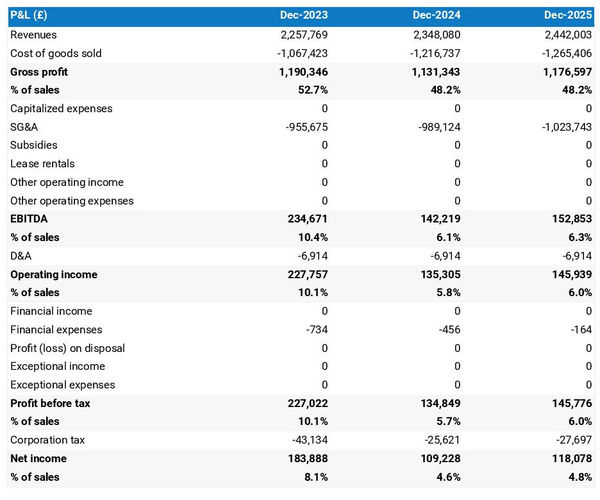
A healthy café's P&L statement should show:
- Sales growing at (minimum) or above (better) inflation
- Stable (minimum) or expanding (better) profit margins
- A healthy level of net profitability
This will of course depend on the stage of your business: numbers for a startup will look different than for an established café.
The projected balance sheet of your café
Your café's forecasted balance sheet enables the reader of your plan to assess your financial structure, working capital, and investment policy.
It is composed of three types of elements: assets, liabilities and equity:
- Assets: represent what the business owns and uses to produce cash flows. It includes resources such as cash, equipment, and accounts receivable (money owed by clients).
- Liabilities: represent funds advanced to the business by lenders and other creditors. It includes items such as accounts payable (money owed to suppliers), taxes due and loans.
- Equity: is the combination of what has been invested by the business owners and the cumulative profits and losses generated by the business to date (which are called retained earnings). Equity is a proxy for the value of the owner's stake in the business.

Your café's balance sheet will usually be analyzed in conjunction with the other financial statements included in your forecast.
Two key points of focus will be:
- Your café's liquidity: does your business have sufficient cash and short-term assets to pay what it owes over the next 12 months?
- And its solvency: does your business have the capacity to repay its debt over the medium-term?
The cash flow forecast
As we've seen earlier in this guide, monitoring future cash flows is the key to success and the only way of ensuring that your café has enough cash to operate.
As you can expect showing future cash flows is the main role of the cash flow forecast in your café business plan.

It is best practice to organise the cash flow statement by nature in order to show the cash impact of the following areas:
- Cash flow generated from operations: the operating cash flow shows how much cash is generated or consumed by the business's commercial activities
- Cash flow from investing activities: the investing cash flow shows how much cash is being invested in capital expenditure (equipment, real estate, etc.) either to maintain the business's equipment or to expand its capabilities
- Cash flow from financing activities: the financing cash flow shows how much cash is raised or distributed to financiers
Looking at the cash flow forecast helps you to make sure that your business has enough cash to keep running, and can help you anticipate potential cash shortfalls.
Your café business plan will normally include both yearly and monthly cash flow forecasts so that the readers can view the impact of seasonality on your business cash position and generation.
The initial financing plan
The sources and uses table or initial financing plan is a key component of your business plan when starting a café.
It shows where the capital needed to set up the business will come from (sources) and how it will be spent (uses).

This table helps size the investment required to set up the café, and understand how risks will be distributed between the business owners, and the financiers.
The sources and uses table also highlights what the starting cash position will be. This is key for startups as the business needs to have sufficient funding to sustain operations until the break-even point is reached.
Now that you have a clear understanding of what will go into the financial forecast of your café business plan, let's have a look at the written part of the plan.
Need inspiration for your business plan?
The Business Plan Shop has dozens of business plan templates that you can use to get a clear idea of what a complete business plan looks like.

The written part of a café business plan is composed of 7 main sections:
- The executive summary
- The presentation of the company
- The products and services
- The market analysis
- The strategy
- The operations
- The financial plan
Throughout these sections, you will seek to provide the reader with the details and context needed for them to form a view on whether or not your business plan is achievable and your forecast a realistic possibility.
Let's go through the content of each section in more detail!
1. The executive summary
The executive summary, the first section of your café's business plan, serves as an inviting snapshot of your entire plan, leaving readers eager to know more about your business.
To compose an effective executive summary, start with a concise introduction of your business, covering its name, concept, location, history, and unique aspects. Share insights about the services or products you intend to offer and your target customer base.
Subsequently, provide an overview of your café's addressable market, highlighting current trends and potential growth opportunities.
Then, present a summary of critical financial figures, such as projected revenues, profits, and cash flows.
You should then include a summary of your key financial figures such as projected revenues, profits, and cash flows.
Lastly, address any funding needs in the "ask" section of your executive summary.
2. The presentation of the company
The second section in your café's business plan should focus on the structure and ownership, location, and management team of the company.
The structure and ownership part provides an overview of the legal structure of the business, who the owners are and how much each has invested and owns. If you are seeking financing it is important that the reader gets a clear picture of which legal entity is receiving the funds, and who controls the business.
The location part should give an overview of the premises from which the company is operating, and why that location is of particular interest (catchment area, accessibility, amenities nearby, etc.).
When describing the location of your cafe, you may want to emphasize its potential for success. You could point out that the area has a large population and a strong market for cafés, suggesting that your business could do well in the area. You might also point out that the area is easily accessible by public transportation and has plenty of parking, making it convenient for customers to visit. You could also mention that the area has a vibrant, diverse population, making it a great place to attract a wide range of customers. All of these factors could make your café an attractive investment opportunity.
Finally, you should introduce the management team. Explain each member's role, background, and experience.
It is also important to emphasize any past successes that the members of the management team have achieved, and how long they've been working together, as this will help potential lenders or investors understand why they should trust in their leadership.
3. The products and services section
The products and services section of your business plan should include a detailed description of what your company offers, who are the target customers, and what distribution channels are part of your go-to-market.
For example, your cafe could offer freshly-made coffee, tea, and pastries to its customers who could enjoy these items made with quality ingredients and sit in the cafe and work or socialize with friends. Your cafe could also offer to-go orders and catering services for special occasions. These options would give customers the flexibility to enjoy the cafe's offerings no matter the time or place.
4. The market analysis
When you present your market analysis in your café business plan, it's crucial to include detailed information about customers' demographics and segmentation, target market, competition, barriers to entry, and any relevant regulations.
The main objective of this section is to help the reader understand the size and attractiveness of the market while demonstrating your solid understanding of the industry.
Begin with the demographics and segmentation subsection, providing an overview of the addressable market for your café, the key trends in the marketplace, and introducing different customer segments along with their preferences in terms of purchasing habits and budgets.
Next, focus on your target market, zooming in on the specific customer segments your café aims to serve and explaining how your products and services fulfil their distinct needs.
For example, your target market might include young professionals. They have the money to buy coffee and pastries as a quick snack and desire a convenient, yet sophisticated atmosphere to work or socialize. They often prefer to purchase higher quality, specialty coffee or tea drinks and appreciate a café that offers a variety of options and a pleasant atmosphere.
Then proceed to the competition subsection, where you introduce your main competitors and highlight what sets you apart from them.
Finally, conclude your market analysis with an overview of the key regulations applicable to your café.
5. The strategy section
When crafting the strategy section of your business plan for your café, it's important to cover several key aspects, including your competitive edge, pricing strategy, sales & marketing plan, milestones, and risks and mitigants.
In the competitive edge subsection, clearly explain what sets your company apart from competitors. This is particularly critical if you're a startup, as you'll be trying to establish your presence in the marketplace among entrenched players.
The pricing strategy subsection should demonstrate how you aim to maintain profitability while offering competitive prices to your customers.
For the sales & marketing plan, outline how you plan to reach and acquire new customers, as well as retain existing ones through loyalty programs or special offers.
In the milestones subsection, detail what your company has achieved thus far and outline your primary objectives for the coming years by including specific dates for expected progress. This ensures everyone involved has clear expectations.
Lastly, in the risks and mitigants subsection, list the main risks that could potentially impact the execution of your plan. Explain the measures you've taken to minimize these risks. This is vital for investors or lenders to feel confident in supporting your venture - try to proactively address any objection they might have.
Your cafe may face the risk of theft or robbery. With the amount of cash on hand, it could make it an attractive target to criminals. Additionally, your cafe may be exposed to health risks, such as foodborne illnesses. Poor food hygiene practices and inadequate food safety procedures might lead to health risks for customers.
6. The operations section
In your business plan, it's also essential to provide a detailed overview of the operations of your café.
Start by covering your team, highlighting key roles and your recruitment plan to support the expected growth. Outline the qualifications and experience required for each role and your intended recruitment methods, whether through job boards, referrals, or headhunters.
Next, clearly state your café's operating hours, allowing the reader to assess staffing levels adequately. Additionally, mention any plans for varying opening times during peak seasons and how you'll handle customer queries outside normal operating hours.
Then, shift your focus to the key assets and intellectual property (IP) necessary for your business. If you rely on licenses, trademarks, physical structures like equipment or property, or lease agreements, make sure to include them in this section.
You might have key assets such as your cafe's brand name and logo, as well as the recipes for your signature dishes. These could be protected as intellectual property and could be the basis for your cafe's identity. Additionally, the interior design of your cafe, in particular the furniture, could be an important asset that contributes to the overall atmosphere and ambiance.
Lastly, include a list of suppliers you plan to work with, detailing their services and main commercial terms, such as price, payment terms, and contract duration. Investors are interested in understanding why you've chosen specific suppliers, which may be due to higher-quality products or established relationships from previous ventures.
7. The presentation of the financial plan
The financial plan section is where we will include the financial forecast we talked about earlier in this guide.
Now that you have a clear idea of the content of a café business plan, let's look at some of the tools you can use to create yours.
What tool should I use to write my café's business plan?
In this section, we will be reviewing the two main options for writing a café business plan efficiently:
- Using specialized software,
- Outsourcing the drafting to the business plan writer.
Using an online business plan software for your café's business plan
The modern and most efficient way to write a café business plan is to use business plan software .
There are several advantages to using specialized software:
- You can easily create your financial forecast by letting the software take care of the financial calculations for you without errors
- You are guided through the writing process by detailed instructions and examples for each part of the plan
- You can access a library of dozens of complete business plan samples and templates for inspiration
- You get a professional business plan, formatted and ready to be sent to your bank or investors
- You can easily track your actual financial performance against your financial forecast
- You can create scenarios to stress test your forecast's main assumptions
- You can easily update your forecast as time goes by to maintain visibility on future cash flows
- You have a friendly support team on standby to assist you when you are stuck
If you're interested in using this type of solution, you can try The Business Plan Shop for free by signing up here .
Need a solid financial forecast?
The Business Plan Shop does the maths for you. Simply enter your revenues, costs and investments. Click save and our online tool builds a three-way forecast for you instantly.

Hiring a business plan writer to write your café's business plan
Outsourcing your café business plan to a business plan writer can also be a viable option.
These writers possess valuable experience in crafting business plans and creating accurate financial forecasts. Additionally, enlisting their services can save you precious time, enabling you to concentrate on the day-to-day operations of your business.
It's important to be mindful, though, that hiring business plan writers comes with a cost. You'll be paying not just for their time but also for the software they use, and their profit margin.
Based on experience, a complete business plan usually requires a budget of at least £1.5k ($2.0k) excluding tax, and more if revisions are needed after initial meetings with lenders or investors - changes often arise following these discussions.
When seeking investment, be cautious about spending too much on consulting fees. Investors prefer their funds to contribute directly to business growth. Thus, the amount you spend on business plan writing services and other consulting services should be negligible compared to the amount you raise.
Another aspect to consider is that while you'll receive the output of the business plan, you usually won't own the actual document. It will be saved in the consultant's business plan software, which will make updating the plan challenging without retaining the consultant on a retainer.
Given these factors, it's essential to carefully weigh the pros and cons of outsourcing your café business plan to a business plan writer and decide what best suits your business's unique needs.
Why not create your café's business plan using Word or Excel?
Using Microsoft Excel and Word (or their Google, Apple, or open-source equivalents) to write a café business plan is not advisable. Allow me to explain the reasons.
Firstly, creating an accurate and error-free financial forecast on Excel or any spreadsheet demands technical expertise in accounting principles and financial modelling. Without a degree in finance and accounting and significant financial modelling experience, it's unlikely that the reader will fully trust your numbers.
Secondly, relying on spreadsheets is inefficient. While it may have been the go-to option in the past, technology has evolved, and software now performs such tasks much faster and more accurately.
The second reason is that it is inefficient. Building forecasts on spreadsheets was the only option in the early 2000s, nowadays technology has advanced and software can do it much faster and much more accurately.
And with the rise of AI, software is also becoming smarter at helping us detect mistakes in our forecasts and helping us analyse the numbers to make better decisions.
Moreover, software offers ease in comparing actuals versus forecasts and maintaining up-to-date forecasts for clear visibility on future cash flows, as we discussed earlier in this guide. Such tasks are cumbersome when using spreadsheets.
Now, let's address the written part of your café business plan. While it may be less prone to errors, using software can significantly boost productivity. Word processors lack instructions and examples for each section of your business plan. They also won't automatically update your numbers when changes occur in your forecast, and they lack automated formatting capabilities.
In summary, while some entrepreneurs may consider Word or Excel for their business plan, it's far from the best or most efficient solution when compared to specialized software.
- Having an up-to-date business plan is key to maintaining visibility on your future cash flows.
- A business plan has 2 parts: a financial forecast highlighting the expected growth, profitability and cash generation of the business; and a written part which provides the context needed to interpret and assess the quality of the forecast.
- Using business plan software is the modern way of writing and maintaining business plans.
We hope that this guide helped you to better understand how to write the business plan for a café. If you still have questions, do not hesitate to contact us.
Also on The Business Plan Shop
- How to write a 5 years business plan
- Business plan myths
Know someone who owns or wants to start a café? Share this article with them!

Founder & CEO at The Business Plan Shop Ltd
Guillaume Le Brouster is a seasoned entrepreneur and financier.
Guillaume has been an entrepreneur for more than a decade and has first-hand experience of starting, running, and growing a successful business.
Prior to being a business owner, Guillaume worked in investment banking and private equity, where he spent most of his time creating complex financial forecasts, writing business plans, and analysing financial statements to make financing and investment decisions.
Guillaume holds a Master's Degree in Finance from ESCP Business School and a Bachelor of Science in Business & Management from Paris Dauphine University.
Create a convincing business plan
Assess the profitability of your business idea and create a persuasive business plan to pitch to investors

500,000+ entrepreneurs have already tried our solution - why not join them?
Not ready to try our on-line tool ? Learn more about our solution here
Need some inspiration for your business plan?
Subscribe to The Business Plan Shop and gain access to our business plan template library.

Need a professional business plan? Discover our solution
Write your business plan with ease!

It's easy to create a professional business plan with The Business Plan Shop
Want to find out more before you try? Learn more about our solution here
Businessplan Café eröffnen: Süß & Sündig
Erfülle dir deinen Traum vom eigenen Café, einer Eisdiele oder als Barista mit mobilem Coffee-Bike! Im Businessplan Muster erfährst du alles Wichtige für deine Gründung rund um das beliebte Heißgetränk.
/app/public/previews/preview-183-62ff4785f1d1d-cafe-preview.jpg)
Businessplan Café
Hol dir praktische Tipps für einen soliden Geschäftsplan. Lass uns gleich loslegen!
Was dich im Businessplan Muster erwartet:
- Leitfaden zur Erstellung eines Businessplans für Gründer/-innen im Gastgewerbe
- Unterstützung bei der Gründungsplanung von Geschäftsidee bis Finanzierung
- Hinweise zu Besonderheiten in der Gastronomie (Genehmigungen, Gesundheitszeugnis etc.)
Diese Businessplan Vorlage ist geeignet für:
- Businessplan Beispiel Café
- Businessplan Coffee Shop
- Businessplan Coffee Bike
- Businessplan Eis-Café
- Businessplan Eisdiele
Deine Vorteile im Überblick:
Es ist kostenfrei: Warum? Weil wir an Gründer glauben und du es uns einfach wert bist.
Es ist kinderleicht: Schritt-für-Schritt erklärt – So kommst du schneller an dein Ziel.
Es ist bequem: Zum Ausdrucken oder vielleicht doch lieber auf deinem digitalen Tablet?
Keine Lust zu lesen? Dann versuch es mit unserem Businessplan-Webinar:
Erfahre im Businessplan-Webinar (ca. 60 Min), was einen überzeugenden Geschäftsplan auszeichnet und welche Fehler du besser vermeiden solltest. Es erwarten dich spannende Impulse, viele Praxis-Tipps und die Möglichkeit, unseren Experten persönliche Fragen zu stellen.
➔ Jetzt weiter zum ZANDURA Businessplan-Webinar
Das könnte dich interessieren
5 Tipps für einen Finanzplan, der Banken überzeugt
Achim-Frederik Weigelt ist Gründer und Geschäftsführer von QFP Qualifizierte Förderprogramme und seit über 30 Jahren erfolgreich als Führungskraft und Coach in der Finanzdienstleistungsbranche tätig. Im Gastbeitrag gibt der Fördermittel-Experte fünf Tipps für einen Finanzplan, der Banken überzeugt.
Die wichtigsten Fördermittel für Existenzgründer
Auf der Suche nach der passenden Förderung? Finde jetzt heraus, welche Finanzierungsform für dich am besten passt – in unserem kostenfreien Finanzierungsfinder.
Dauerhaft 7 Prozent Umsatzsteuer in der Gastronomie?
Noch bis Ende 2022 gilt der reduzierte Steuersatz von 7 Prozent auf Speisen in der Gastronomie. Bundesfinanzminister Christian Lindner (FDP) plädiert jetzt für eine dauerhafte Entfristung der Mehrwertsteuersenkung ab 2023. Alles was du wissen musst.
Bild-Urheber: iStock.com/alvarez
Cafe Business Plan Template
Written by Dave Lavinsky
Cafe Business Plan
You’ve come to the right place to create your Cafe business plan.
We have helped over 1,000 entrepreneurs and business owners create business plans and many have used them to start or grow their Cafes.
Below is a template to help you create each section of your Cafe business plan.
Executive Summary
Business overview.
The Countryside Cafe is a startup cafe founded by Cheryl Nelson and Tammy Overton in Tulsa, Oklahoma. Together they have over twenty years of experience in managing and operating cafes and they are highly skilled in the creation of menu items customers love, exemplary service to customers, and in their honed expertise in running efficient and profitable restaurants. Cheryl is the former manager of a family-owned restaurant, where she had oversight of the employees, ordering, systems and financial record-keeping for the restaurant. Tammy was the head staff person of a chain restaurant who managed the scheduling, training and day-to-day operations of the restaurant. Together, they have decided to bring a family friendly environment and classic menu items to Tulsa.
Product Offering
The following are the products and services that Countryside Cafe will provide:
- Exemplary service for customers
- Honest, reliable relationships with vendors and suppliers
- Restaurant services 24/7 hours to accommodate all residents of the area
- Discounted menu pricing and expedited service for first responders
- Family-friendly menu items that everyone can enjoy
- Day to day management
Customer Focus
The Countryside Cafe will target customers throughout the Tulsa region who enjoy eating comfort foods, such as they may have grown up eating. Secondary target customers will be those who enjoy the hometown-feel of a small cafe rather than a large or more modern establishment. Those individuals who occupy nearby businesses or government offices will also be targeted by the Countryside Cafe, as well as those who own farms or ranches in the region.
Management Team
The Countryside Cafe will be owned by Cheryl Nelson and Tammy Overton. Together they have over 20 years of experience in managing and operating a regional cafe and they are highly skilled in the creation of menu items customers love, exemplary service to customers, and in their honed expertise in running efficient and profitable organizations. Cheryl is the former manager of a family-owned restaurant and Tammy was the head staff person of a chain restaurant. Together, they have decided to bring a family friendly environment and homestyle, fresh foods to Tulsa. The menu will include breakfast, lunch and dinner meals, as well as popular favorites such as ice cream sundaes and homemade pies any time of day.
Success Factors
Countryside Cafe will be able to achieve success by offering the following competitive advantages:
- Friendly, knowledgeable, and highly-qualified team of Countryside Cafe
- Comprehensive menu of meals for any time of day, including snacks, such as French fries and desserts, along with soda fountain favorites such as sundaes, malts and milkshakes.
- Countryside Cafe will offer special discounted pricing for first-responders in Tulsa.
- Countryside Cafe will offer a child menu and a play area for children while their parents enjoy their meal.
- First-time visitors to the Countryside Cafe will receive a free dessert of their choice.
- Countryside Cafe offers the best pricing in town. Their pricing structure is the most cost effective compared to the competition.
Financial Highlights
Countryside Cafe is seeking $200,000 in debt financing to launch its cafe business. The funding will be dedicated toward securing the restaurant space and purchasing office equipment and supplies. Funding will also be dedicated toward three months of overhead costs to include payroll of the staff, rent, and marketing costs for the print ads and marketing costs. The breakout of the funding is below:
- Restaurant space build-out: $20,000
- Office equipment, supplies, and materials: $10,000
- Three months of overhead expenses (payroll, rent, utilities): $150,000
- Marketing costs: $10,000
- Working capital: $10,000
The following graph outlines the financial projections for Countryside Cafe.
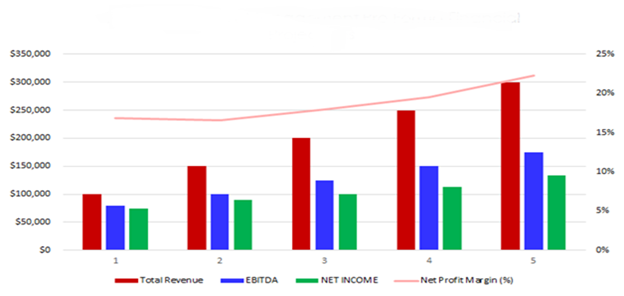
Company Overview
Who is countryside cafe.
Countryside Cafe is a newly established, full-service homestyle cafe in Tulsa, Oklahoma. Countryside Cafe will be the most reliable, cost-effective, and efficient choice for individuals and families, as well as businesspeople in Tulsa and the surrounding communities. Countryside Cafe will provide a comprehensive menu of favorite meals, snacks and desserts for any diner to utilize. Their full-service approach includes a comprehensive menu and seating options to suit each family, including small children.
Countryside Cafe will be able to serve over fifty people at one time. The team of owners and staff members are highly qualified and experienced in preparing, making and serving favorite family meals and snacks. Countryside Cafe removes all headaches and issues of finding easy, friendly and moderately-priced meals in Tulsa and ensures all appetites are satisfied while delivering the best customer service.
Countryside Cafe Management History
The Countryside Cafe consists of two experienced restaurateurs with distinctive areas of expertise: Cheryl Nelson and Tammy Overton have over twenty years of experience together in managing and operating a regional cafe and they are highly skilled in the creation of menu items customers love, exemplary service to customers, and in their honed expertise in running efficient and profitable organizations.
Cheryl Nelson is the former manager of a family-owned restaurant, where she had oversight of the employees, ordering, systems and financial record-keeping for the restaurant. Tammy was the head staff person of a chain restaurant who managed the scheduling, training and day-to-day operations of the restaurant. Together, they have decided to bring a family friendly environment and honest, favorite foods to Tulsa.
Since incorporation, Countryside Cafe has achieved the following milestones:
- Registered Countryside Cafe, LLC to transact business in the state of Oklahoma.
- Have a contract in place for a 20,000 square foot restaurant space in a family-friendly retail area
- Reached out to numerous contacts to visit the Countryside Cafe upon launch and regularly after the launch.
- Began recruiting a staff of eight servers and four office personnel to work at the Countryside Cafe.
Countryside Cafe Services
The following will be the services Countryside Cafe will provide:
Industry Analysis
The cafe and small restaurant industry is expected to grow over the next five years to almost $500 million. The growth will be driven by consumers who seek favorite foods they’ve always enjoyed. Consumers also want to be served in small, more intimate settings which are relaxing and comfortable. Customers with children will help grow the cafe industry because, as families, they are more relaxed in the informal “down home” comfort of a small cafe versus a large, more formal restaurant.
Costs will likely be reduced as cafes continue to expand and modify their menus to seek out the best, most desirable menu items for consumers rather than spending widely on menu choices that may not be well-received. Costs will also continue to go down due to lower prices on produce and beef within the Oklahoma area. As fresh fruit is more in demand, juices and smoothies will cost less to produce than in the past, as well.
Customer Analysis
Demographic profile of target market, customer segmentation.
Countryside Cafe will primarily target the following customer profiles:
- Individuals and families within the region
- Small business owners and employees within the region
- City officials and those who work in the business of Tulsa
- Farmers and ranchers in the greater Tulsa regions
Competitive Analysis
Direct and indirect competitors.
Countryside Cafe will face competition from other companies with similar business profiles. A description of each competitor company is below.
Mama’s Kitchen
Mama’s Kitchen was started in 1998 by Candy and Jamie Swanson. Originally intended as a truck stop, Mama’s Kitchen grew to include a larger restaurant area in 2005 and has served breakfast and lunch to travelers from that time to the present. Located on the main highway through the city of Tulsa, the restaurant receives many travelers who opt to stop for a meal.
Mama’s Kitchen is twenty-three miles away from the Countryside Cafe. There are a few similarities to the menus served by both restaurants, as homestyle fare is offered. The differences between the two restaurant businesses is found in the family-friendly dining-booth atmosphere of the Countryside Cafe, while Mama’s Kitchen has countertops and bar stools throughout. This makes seating for a family difficult and children are not able to reach the countertops on stools at Mama’s Kitchen, which creates discomfort for children.
Buddy’s Bar & Grill
Owned by Robert “Buddy” Gorman, Buddy’s Bar & Grill is a full-service bar with a small dining room attached. The restaurant is located six miles from the Countryside Cafe. Meals are served at Buddy’s Bar & Grill during lunch and dinner; however, the restaurant is not open for breakfast. Meals are geared toward grilled hamburgers, steaks and fried fish, while the bar menu is laden with appetizer choices served during happy hour each Tuesday afternoon. Robert Gorman is assisted by his sister, Babs, who acts as the lone server in the grill and is known for her fast service and quick wit, which customers find charming. Children are not allowed in the bar, but they can be served in the grill side of the restaurant. The children’s menu is limited to hamburgers or cheese sandwiches served with fries.
Howard’s Family Restaurant
Howard’s Family Restaurant serves breakfast, lunch and dinner in a small dining room attached to the golf country club on the outskirts of Tulsa. It is located ten miles from the Countryside Cafe. Most patrons of Howard’s Family Restaurant are golfers who want to enjoy a meal before or after playing golf. The restaurant is one of a chain of restaurants and, while the prices are higher than those of the other cafes and small restaurants in Tulsa, the restaurant is known by the national marketing of the parent company. Children are served a special kids’ play and dine menu and families are highlighted as the primary target of the chain.
Competitive Advantage
Countryside Cafe will be able to offer the following advantages over their competition:
- Friendly, knowledgeable, and highly-qualified team of the Countryside Cafe.
Marketing Plan
Brand & value proposition.
Countryside Cafe will offer the unique value proposition to its clientele:
- Highly-qualified team of skilled employees who are able to provide a delicious meal in a pleasant surrounding for the entire family.
- Countryside Cafe will offer special discounted pricing for first-responders in Tulsa, including police, fire and hospital staff. Doctors and nurses are also included.
- First-time visitors to the Countryside Cafe will receive a free dessert of their choice, which helps guests feel welcome and comfortable.
- Unbeatable pricing to its clients; they will offer the lowest pricing in the city.
Promotions Strategy
The promotions strategy for Countryside Cafe is as follows:
Word of Mouth/Referrals
Countryside Cafe has built up an extensive list of contacts over the years by providing exceptional service and expertise to their clients, including guests of all ages. The personal contacts and business associates will follow the new owners to the new cafe and help spread the word of Countryside Cafe.
Professional Associations and Networking
The new owners of the Countryside Cafe, Cheryl and Tammy, will join the civic organizations and trade networks to help build their cafe to its potential. They will become active in the committees for city celebrations, as well, to help build visibility of their cafe and raise awareness of their specialty menu items.
Print Advertising
The Countryside Cafe will send a direct mail flyer to each home and business in Tulsa in the two weeks prior to the launch of the restaurant. The flyer will invite everyone to participate in special discounted offers during the first month of business and offer a free dessert for each person who stops by to check out the area’s newest cafe.
Countryside Cafe will fully utilize their website. The website will be well organized, informative, and list all the services that Countryside Cafe provides. The website will also list their contact information and list their menu and pricing, along with delivery options. The website will engage in SEO marketing tactics so that anytime someone types in the Google or Bing search engine “homestyle cafe” or “cafe near me,” Countryside Cafe will be listed at the top of the search results.
The pricing of Countryside Cafe will be moderate and below or on par with competitors so customers feel they receive excellent value when purchasing their products and services. Certain items, such as the childrens’ menu items, will be priced at a reduced profit margin in order to facilitate larger families that want to visit and can afford to do so with the reduced prices.
Operations Plan
The following will be the operations plan for Countryside Cafe. Operation Functions:
- Cheryl Nelson will be the co-owner and president of the company. She will oversee all business development and manage client relations.
- Tammy Overton will be the co-owner and vice president of the company. She will manage the operations and oversee all staff members.
- Tyler Grant will be the Office Manager who will manage the office administration, client files, and accounts payable.
- Tommy Tucker will be the maintenance employee who will provide all maintenance and repairs at the property.
Milestones:
Countryside Cafe will have the following milestones completed in the next six months.
- 5/1/202X – Finalize contract to lease restaurant space
- 5/15/202X – Finalize personnel and staff employment contracts for the Countryside Cafe
- 6/1/202X – Finalize contracts for Countryside Cafe vendors and wholesale accounts
- 6/15/202X – Begin networking at industry events
- 6/22/202X – Begin moving into Countryside Cafe restaurant
- 7/1/202X – Countryside Cafe opens its doors for business
The Countryside Cafe will be owned by Cheryl Nelson and Tammy Overton. Together they have over twenty years of experience in managing and operating a regional cafe and they are highly skilled in the creation of menu items customers love, exemplary service to customers, and in their honed expertise in running efficient and profitable organizations.
Cheryl Nelson is the former manager of a family-owned restaurant and Tammy was the head staff person of a chain restaurant.Together, they have decided to bring a family friendly environment and homestyle, fresh foods to Tulsa. The menu will include breakfast, lunch and dinner meals, as well as popular favorites such as ice cream sundaes and homemade pies any time of day.
Financial Plan
Key revenue & costs.
The revenue drivers for Countryside Cafe are the fees they will charge to customers for their products and services.
The cost drivers will be the overhead costs required in order to staff Countryside Cafe. The expenses will be the payroll cost, rent, utilities, inventory, office supplies, and marketing materials.
Key Assumptions
The following outlines the key assumptions required in order to achieve the revenue and cost numbers in the financials and in order to pay off the startup business loan.
- Number of restaurant customers per Month: 1,000
- Average revenue per Month: $25,000
- Office Lease per Year: $100,000
Financial Projections
Income statement, balance sheet, cash flow statement, cafe business plan faqs, what is a cafe business plan.
A cafe business plan is a plan to start and/or grow your cafe business. Among other things, it outlines your business concept, identifies your target customers, presents your marketing plan and details your financial projections.
You can easily complete your Cafe business plan using our Cafe Business Plan Template here .
What are the Main Types of Cafe?
There are a number of different kinds of cafe businesses , some examples include: Take-Out Cafe, Restaurant Cafe, Casual cafe, and Coffee Shop.
How Do You Get Funding for Your Cafe Business Plan?
Cafe businesses are often funded through small business loans. Personal savings, credit card financing and angel investors are also popular forms of funding.
What are the Steps To Start a Cafe Business?
Starting a cafe business can be an exciting endeavor. Having a clear roadmap of the steps to start a business will help you stay focused on your goals and get started faster.
- Develop A Cafe Business Plan - The first step in starting a business is to create a detailed cafe business plan that outlines all aspects of the venture. This should include potential market size and target customers, the services or products you will offer, pricing strategies and a detailed financial forecast.
- Choose Your Legal Structure - It's important to select an appropriate legal entity for your cafe business. This could be a limited liability company (LLC), corporation, partnership, or sole proprietorship. Each type has its own benefits and drawbacks so it’s important to do research and choose wisely so that your cafe business is in compliance with local laws.
- Register Your Cafe Business - Once you have chosen a legal structure, the next step is to register your cafe business with the government or state where you’re operating from. This includes obtaining licenses and permits as required by federal, state, and local laws.
- Identify Financing Options - It’s likely that you’ll need some capital to start your cafe business, so take some time to identify what financing options are available such as bank loans, investor funding, grants, or crowdfunding platforms.
- Choose a Location - Whether you plan on operating out of a physical location or not, you should always have an idea of where you’ll be based should it become necessary in the future as well as what kind of space would be suitable for your operations.
- Hire Employees - There are several ways to find qualified employees including job boards like LinkedIn or Indeed as well as hiring agencies if needed – depending on what type of employees you need it might also be more effective to reach out directly through networking events.
- Acquire Necessary Cafe Equipment & Supplies - In order to start your cafe business, you'll need to purchase all of the necessary equipment and supplies to run a successful operation.
- Market & Promote Your Business - Once you have all the necessary pieces in place, it’s time to start promoting and marketing your cafe business. This includes creating a website, utilizing social media platforms like Facebook or Twitter, and having an effective Search Engine Optimization (SEO) strategy. You should also consider traditional marketing techniques such as radio or print advertising.
Learn more about how to start a successful cafe business:
- How to Start a Cafe

Cafe Business Plan Template
- Written by Dave Lavinsky
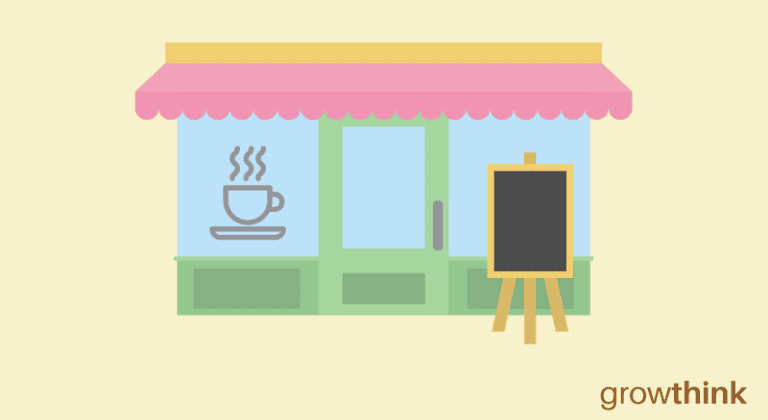
Table of Contents
Cafe business plan.
Over the past 20+ years, we have helped over 10,000 entrepreneurs and business owners create business plans to start and grow their cafes. On this page, we will first give you some background information with regards to the importance of business planning. We will then go through a cafe business plan template step-by-step so you can create your plan today.
Download our Ultimate Business Plan Template here >
What Is a Cafe Business Plan?
A business plan provides a snapshot of your cafe as it stands today, and lays out your growth plan for the next five years. It explains your business goals and your strategy for reaching them. It also includes market research to support your plans.
Why You Need a Cafe Business Plan
If you’re looking to start a cafe or grow your existing cafe you need a business plan. A business plan will help you raise funding, if needed, and plan out the growth of your cafe in order to improve your chances of success. Your cafe business plan is a living document that should be updated annually as your cafe grows and changes.
Sources of Funding for Cafes
With regards to funding, the main sources of funding for a cafe are bank loans and angel investors. With regards to bank loans, banks will want to review your business plan and gain confidence that you will be able to repay your loan and interest. To acquire this confidence, the loan officer will not only want to confirm that your financials are reasonable. But they will want to see a professional plan. Such a plan will give them the confidence that you can successfully and professionally operate a business.
The second most common form of funding for a cafe is angel investors. Angel investors are wealthy individuals who will write you a check. They will either take equity in return for their funding, or, like a bank, they will give you a loan.
Finish Your Business Plan Today!
Your cafe business plan should include 10 sections as follows:
Executive Summary
Your executive summary provides an introduction to your business plan, but it is normally the last section you write because it provides a summary of each key section of your plan.
The goal of your Executive Summary is to quickly engage the reader. Explain to them the type of cafe business you are operating and the status; for example, are you a startup, do you have a cafe that you would like to grow, or are you operating a chain of cafes.
Next, provide an overview of each of the subsequent sections of your plan. For example, give a brief overview of the cafe industry. Discuss the type of cafe you are operating. Detail your direct competitors. Give an overview of your target market. Provide a snapshot of your marketing plan. Identify the key members of your team. And offer an overview of your financial plan.
Company Analysis
In your company analysis, you will detail the type of cafe you are operating.
For example, you might operate one of the following types:
- Take-Out Cafe: this type of cafe doesn’t have seating (or has limited seating) and is mostly visited by customers looking to grab a coffee and/or bakery item on their way to work or elsewhere.
- Restaurant Cafe: this type of cafe is most similar to a restaurant and offers a full, sit-down menu in a nice atmosphere with a full wait staff.
- Casual cafe: also known as a corporate, student or co-working cafe, this type of cafe typically offers food and drinks from a counter with no waiters or waitresses. Patrons purchase items and consume them in the cafe, often while performing work on their laptops or conversing with friends or colleagues.
- Coffee Shop: This is a popular type of cafe. Coffee shops usually offer a selection of tea, coffee, pastries and other drinks
In addition to explaining the type of cafe you operate, the Company Analysis section of your business plan needs to provide background on the business.
Include answers to question such as:
- When and why did you start the business? What is your business concept? What is your unique selling proposition?
- What milestones have you achieved to date? Milestones could include sales goals you’ve reached, new store openings, etc.
- Your business structure. Are you incorporated as an S-Corp? An LLC? A sole proprietorship? Explain your legal structure here.
Industry Analysis
In your industry analysis, you need to provide an overview of the cafe business.
While this may seem unnecessary, it serves multiple purposes.
First, researching the cafe industry educates you. It helps you understand the market in which you are operating.
Secondly, market research can improve your strategy particularly if your research identifies market trends. For example, if there was a trend towards cafes with ultra high speed internet connections, it would be helpful to ensure your location could offer such a service.
The third reason for market research is to prove to readers that you are an expert in your industry. By conducting the research and presenting it in your plan, you achieve just that.
The following questions should be answered in the industry analysis section of your cafe business plan:
- How big is the cafe business (in dollars)?
- Is the market declining or increasing?
- Who are the key competitors in the market?
- Who are the key local suppliers in your market?
- What trends are affecting the industry?
- What is the industry’s growth forecast over the next 5 – 10 years?
- What is the relevant market size? That is, how big is the potential market for your cafe. You can extrapolate such as figure by assessing the size of the market in the entire country and then applying that figure to your local population.
Customer Analysis
The market analysis section of your cafe business plan must detail the customers you serve and/or expect to serve.
The following are examples of customer segments: local office workers, college students, sports enthusiasts, soccer moms, techies, teens, baby boomers, etc.
As you can imagine, the target audience you choose will have a great impact on the type of cafe you operate. Clearly baby boomers would want a different atmosphere, pricing and product options, and would respond to different marketing promotions than teens.
Try to break out your target customers in terms of their demographic and psychographic profiles. With regards to demographics, include a discussion of the ages, genders, locations and income levels of the customers you seek to serve. Because most cafes primarily serve customers living in their same city or town, such demographic information is easy to find on government websites.
Psychographic profiles explain the wants and needs of your target customers. The more you can understand and define these needs, the better you will do in attracting and retaining your customers.
With Growthink’s Ultimate Business Plan Template you can finish your plan in just 8 hours or less!
Competitive Analysis
Your competitive analysis should identify the indirect and direct competitors your business faces and then focus on the latter.
Direct competitors are other cafes (and restaurants and/or bakeries depending on the type of cafe you operate).
Indirect competitors are other options that customers have to purchase from you that aren’t direct competitors. This includes restaurants, supermarkets and customers making coffee and bakery items themselves at home. You need to mention such competition to show you understand that not everyone in your target market will visit a cafe each day.
With regards to direct competition, you want to detail the other cafes or coffee shops with which you compete. Most likely, your direct competitors will be cafes located very close to your location.
For each such competitor, provide an overview of their businesses and document their strengths and weaknesses. Unless you once worked at your competitors’ businesses, it will be impossible to know everything about them. But you should be able to find out key things about them such as:
- What types of customers do they serve?
- What products do they offer?
- What is their pricing (premium, low, etc.)?
- What are they good at?
- What are their weaknesses?
With regards to the last two questions, think about your answers from the customers’ perspective. And don’t be afraid to stand outside your competitors’ locations and ask customers as they leave what they like most and least about them.
The final part of your competitive analysis section is to document your areas of competitive advantage. For example:
- Will you provide superior cafe products?
- Will you provide cafe products that your competitors don’t offer?
- Will you make it easier or faster for customers to acquire your products?
- Will you provide better customer service?
- Will you offer better pricing?
Think about ways you will outperform your competition and document them in this section of your plan.
Marketing Plan
Traditionally, a marketing plan includes the four P’s: Product, Price, Place, and Promotion. For a cafe business plan, your marketing plan should include the following:
Product : in the product section you should reiterate the type of cafe that you documented in your Company Analysis. Then, detail the specific products you will be offering. For example, will you offer pastries, soups, items such as café latte, cappuccino, espresso or macchiato?
Price : Document the prices you will offer and how they compare to your competitors. Essentially in the product and price sub-sections of your marketing plan, you are presenting the menu items you offer and their prices.
Place : Place refers to the location of your cafe. Document your location and mention how the location will impact your success. For example, is your cafe located next to a heavily populated office building, or gym, etc. Discuss how your location might provide a steady stream of customers.
Promotions : the final part of your cafe marketing plan is the promotions section. Here you will document how you will drive customers to your location(s). The following are some promotional methods you might consider:
- Making your cafe’s front store extra appealing to attract passing customers
- Distributing samples outside the cafe
- Advertising in local papers and magazines
- Reaching out to local bloggers and websites
- Partnerships with local organizations (e.g., gym members get a free cup of cafe with each pastry they purchase)
- Local radio advertising
- Banner ads at local venues
Operations Plan
While the earlier sections of your business plan explained your goals, your operations plan describes how you will meet them. Your operations plan should have two distinct sections as follows.
Everyday short-term processes include all of the tasks involved in running your cafe such as serving customers, procuring supplies, keeping the cafe clean, etc.
Long-term goals are the milestones you hope to achieve. These could include the dates when you expect to serve your 10,000th customer, or when you hope to reach $X in sales. It could also be when you expect to hire your Xth employee or launch a new location.
Management Team
To demonstrate your cafe’s ability to succeed as a business, a strong management team is essential. Highlight your key players’ backgrounds, emphasizing those skills and experiences that prove their ability to grow a company.
Ideally you and/or your team members have direct experience in the cafe, coffee shop and/or restaurant business. If so, highlight this experience and expertise. But also highlight any experience that you think will help your business succeed.
If your team is lacking, consider assembling an advisory board. An advisory board would include 2 to 8 individuals who would act like mentors to your business. They would help answer questions and provide strategic guidance. If needed, look for advisory board members with experience in cafes and/or successfully running retail and small businesses.
Financial Plan
Your financial plan should include your 5-year financial statement broken out both monthly or quarterly for the first year and then annually. Your financial statements include your income statement, balance sheet and cash flow statements.
Income Statement : an income statement is more commonly called a Profit and Loss statement or P&L. It shows your revenues and then subtracts your costs to show whether you turned a profit or not.
In developing your income statement, you need to devise assumptions. For example, will you serve 100 customers per day or 200? And will sales grow by 2% or 10% per year? As you can imagine, your choice of assumptions will greatly impact the financial forecasts for your business. As much as possible, conduct research to try to root your assumptions in reality.
Balance Sheets : While balance sheets include much information, to simplify them to the key items you need to know about, balance sheets show your assets and liabilities. For instance, if you spend $100,000 on building out your cafe, that will not give you immediate profits. Rather it is an asset that will hopefully help you generate profits for years to come. Likewise, if a bank writes you a check for $100.000, you don’t need to pay it back immediately. Rather, that is a liability you will pay back over time.
Cash Flow Statement : Your cash flow statement will help determine how much money you need to start or grow your business, and make sure you never run out of money. What most entrepreneurs and business owners don’t realize is that you can turn a profit but run out of money and go bankrupt. For example, let’s say a company approached you with a massive $100,000 catering contract, that would cost you $50,000 to fulfill. Well, in most cases, you would have to pay that $50,000 now for supplies, equipment rentals, employee salaries, etc. But let’s say the company didn’t pay you for 180 days. During that 180 day period, you could run out of money.
In developing your Income Statement and Balance Sheets be sure to include several of the key costs needed in starting or growing a cafe:
- Location build-out including design fees, construction, etc.
- Cost of fixtures like chairs, tables, signage and cafe decor
- Cost of equipment like grinders, espresso machines, blenders, refrigerators
- Cost of ingredients and maintaining an adequate amount of supplies
- Payroll or salaries paid to staff
- Business insurance
- Taxes and permits
- Legal expenses
Attach your full financial projections in the appendix of your plan along with any supporting documents that make your plan more compelling. For example, you might include your store design blueprint or location lease.
Summary Putting together a business plan for your cafe is a worthwhile endeavor. If you follow the template above, you will be able to prepare a winning cafe business plan or a coffee shop business plan. You will really understand cafe business planning, business operations, your competition and your customers. You will have developed a marketing plan and will really understand what it takes to launch and grow a successful cafe.
Café Business Plan FAQs
What is the easiest way to complete my café business plan.
Growthink's Ultimate Business Plan Template allows you to quickly and easily complete your Café Business Plan.
What is the Goal of a Business Plan's Executive Summary?
OR, Let Us Develop Your Plan For You Since 1999, Growthink has developed business plans for thousands of companies who have gone on to achieve tremendous success.
Click here to see how our professional business plan writers can create your business plan for you. Other Helpful Business Plan Articles & Templates

Cafe business plan template + PDF
In this article, you will find an exemplary business plan for a cafe, offering a detailed framework to guide you through establishing and managing your own cafe. It's crucial to understand that while all names and numbers in this cafe business plan template are invented for illustrative purposes, they can be adjusted to suit the specific needs and realities of your cafe business.
Additionally, for ease of use and customization, a Cafe Business Plan PDF is available for download. This article serves as an invaluable tool for entrepreneurs who are keen on developing a robust and practical strategy for launching or growing their cafe, providing a clear roadmap and comprehensive insights into the industry.
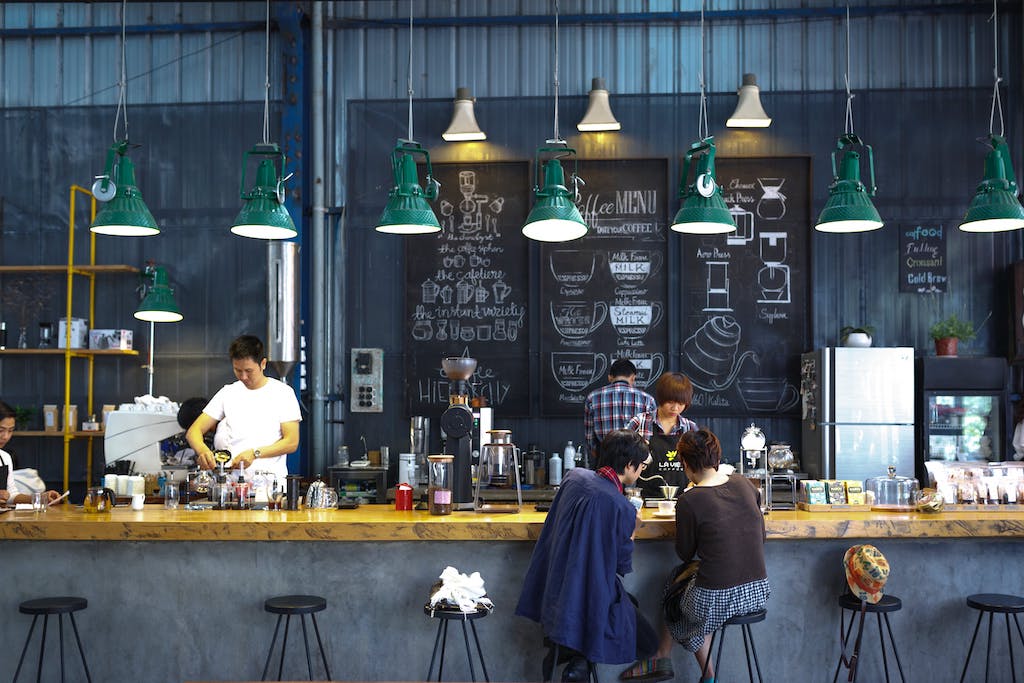
How this cafe business plan sample was created
To create a personalized business plan for your cafe, all you need to do is click on "Get your business plan" . You'll be prompted to answer a few questions about your cafe, providing essential details about your business. Our advanced AI system will then use this information to generate a comprehensive business plan tailored to your specific needs and goals. This process takes only 5-10 minutes, after which you receive a fully structured plan. The beauty of this system lies in its flexibility; you can edit and customize the plan to perfectly align with your vision. Once finalized, you have the option to save it to your computer, ensuring that your cafe/restaurant roadmap to success is just a few clicks away.

Generate your custom restaurant business plan in minutes!
Cafe business plan sample, executive summary, business description, market research and analysis.
- Organizational Structure and Management Team
Products or Services
Marketing and sales strategy, operations plan, financial projections, risk analysis.
In today’s bustling cafe industry, standing out entails more than a robust business model; it calls for a compelling executive summary that captures the essence and potential of the venture. BizCafe is built upon this very vision—a cutting-edge oasis for young professionals and students seeking a coffee experience that is both gourmet and homely, in addition to an efficient workspace. Positioned in the heart of New York, BizCafe is poised to challenge the conventional cafe atmosphere by combining specialty coffees, artisan teas, delectable pastries, satisfying light meals, and indispensable modern amenities like high-speed Wi-Fi and charging stations.
Despite challenging industry dynamics such as fierce competition, economic volatility, supply chain obstacles, and shifting consumer tastes, BizCafe’s strategic plan remains solid. It thoughtfully balances the appeal of our signature products and brand-building initiatives, employing distinctive branding and customized loyalty programs to build a devoted customer base. These offerings are intended to meld effortlessly into the lives of our target clientele, creating a sense of community and loyalty. In the event of heightened risks, our backup plans include diversified menus, local sourcing, and continued product development.
Within a varied competitive landscape that includes Java Junction, The Study Spot, Green Leaf Tea House, and Urban Grind, understanding different market positions is crucial for honing BizCafe’s competitive edge and creating a space that is both unique and adaptable.
Operations form BizCafe’s core, with exhaustive planning that ranges from securing key supplier partnerships to appointing trained baristas and support staff committed to unmatched customer service. Our operational strategies underscore regular quality control, smart inventory management, adhering to health and safety standards, and fiscal responsibility with recurrent assessments and careful budgeting.
Our financial projections suggest a positive outlook. We anticipate reaching a break-even point by the end of the first year and foresee a promising 20% revenue increase by the third year. With the projected growth, we aim to pursue expansion and diversification, setting a course towards a $1 million revenue milestone by the end of the fifth year.
Marketing and sales are integral to introducing and embedding the BizCafe brand in public discourse and consumer habits. An ingenious blend of social media activity, loyalty incentives, local events, and partnerships with nearby businesses is designed to uphold and celebrate the BizCafe ethos. This is supported by a robust digital foundation that ensures convenience through online ordering platforms and sustains community engagement with impactful email communication.
Driving this promising enterprise are seasoned leaders such as Co-Founders & CEOs Alex Taylor and Jordan Lee, who bring a wealth of experience in business management and finance. Operations Manager Riley Kim and Marketing Director Casey Morgan complete the leadership team, guaranteeing seamless operations and strong, consistent brand visibility.
As an LLC, BizCafe benefits from the agility needed to adeptly manage the unpredictable nature of the cafe industry, all while taking advantage of a tax structure that encourages growth.
In conclusion, this executive summary portrays BizCafe not just as another cafe in New York’s tapestry but as a beacon in its cafe culture—a sanctuary for today’s discerning, digitally connected patron and a strategic investment opportunity for tomorrow’s wise investor.
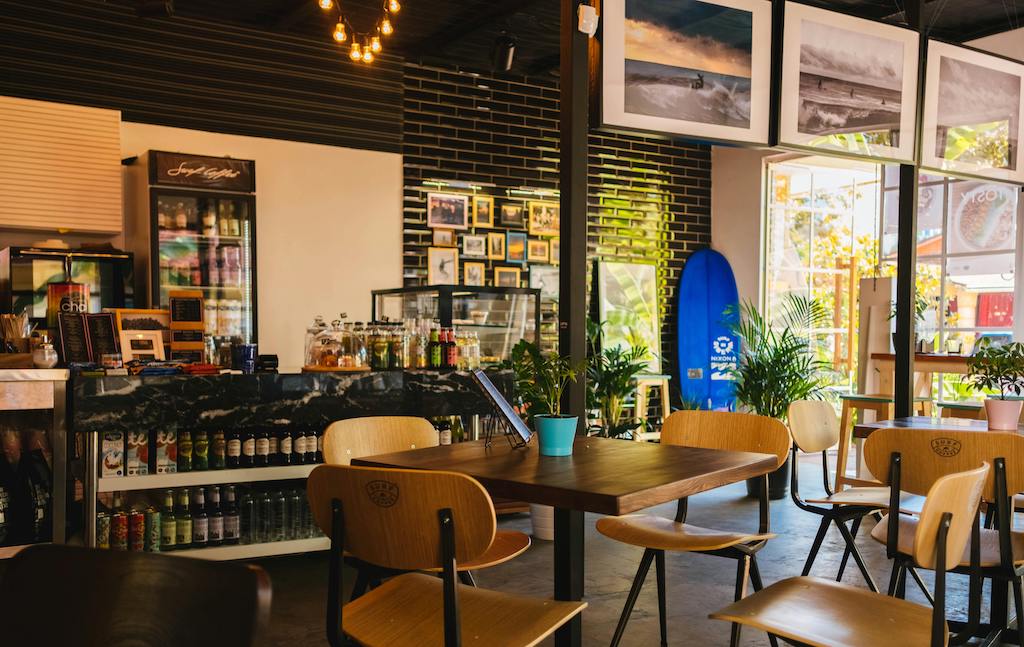
Located in the bustling heart of New York, BizCafe is primed to become the go-to destination for the city's energetic young professionals and the academically inclined student population. Designed as a Limited Liability Company, BizCafe harmoniously balances the vibrancy of an artisan coffee hub with the tranquility of a focused work sanctuary. This innovative cafe caters to the tastes and lifestyles of customers aged 20-35, offering an array of specialty coffees, artisan teas, as well as a handpicked selection of pastries and light meals.
Embraced by the convenience of high-speed Wi-Fi and charging stations, BizCafe is not just a place for savoring a cup of freshly brewed java but is also an inviting space for clients seeking a comfortable place to work, study, or unwind. With a central location, this cafe capitalizes on the fast pace of New York City, becoming a social landmark that facilitates productivity and leisure.
BizCafe prides itself on mitigating anticipated industry risks. Facing competition from establishments such as Java Junction, The Study Spot, Green Leaf Tea House, and Urban Grind, BizCafe differentiates itself through its unique branding and customer loyalty programs. In the event of increased rivalry, the management plans to diversify the menu and enhance loyalty incentives to retain customer fidelity. Economic fluctuations will be met with competitive pricing and value deals, while supply chain disruptions are countered with established relationships and buffer stock, complemented by local sourcing as a contingency measure.
Looking to the next 3-5 years, financial projections are optimistic. The first year is focused on reaching the break-even point, with a revenue aim of $500,000, setting the stage for profit as the brand gains recognition. Steadying itself for moderate growth, BizCafe expects to increase revenue by 20% annually in years 2 and 3 and is planning an expansion that may include a second location or enriched services by year 5, hoping to surpass the $1 million revenue mark.
Within the café, operations pivot around supreme supply chain management, premium staffing, unwavering quality control, and sophisticated inventory management. Staff are selected for their skills and commitment to customer service, with a rotational shift system ensuring comprehensive coverage. In-house financial and customer service processes are evaluated routinely to align with the cafe's high standards.
The marketing and sales strategy is equally robust with a dynamic approach to embrace digital platforms. Social media marketing, loyalty programs, community engagement, collaborations, and a formidable digital presence all form pillars of BizCafe's promotional endeavors. Customized email marketing further personalizes the brand experience, resonating with the targeted clientele.
Leadership is the backbone of BizCafe's operation. Co-Founders Alex Taylor and Jordan Lee embody the essence of keen business acumen and financial mastery, while the operational finesse of Riley Kim and Casey Morgan's marketing expertise provides the momentum behind customer-centric initiatives.
Together, the tapestry of a digital-friendly environment, savvy marketing, responsive risk management, and a crystalline growth trajectory present BizCafe as an enterprise that blends traditional café culture with the innovative spirit of modern entrepreneurship. With a client base that revels in quality and a company ethos grounded in adaptability, BizCafe is on the verge of becoming a cornerstone in the cafe industry, directing its compass towards success in the years to come.
In a city renowned for its perpetual motion and varied tastes, BizCafe emerges as an innovative player in the cafe industry. Market research indicates an uptick in demand for spaces that offer both premium refreshments and conducive environments for work and socialising. By focusing on the 20-35 age group, BizCafe taps into a market niche of young professionals and students who seek quality, convenience, and experience in their choice of hangout spots.
Competition within New York's café landscape is intense but distinct. Java Junction is a chain with a time-efficient service model that resonates with customers on-the-go. BizCafe's strategy of personalised service and loyalty programs sets it apart, fostering a unique community feel and customer retention. The Study Spot, with its quietude and scholastic environment, draws in a specific crowd; however, BizCafe's added value of specialty beverages and high-speed Wi-Fi conducts a broader appeal. Meanwhile, Green Leaf Tea House and Urban Grind border on niche appeals, the former stressing on health-centric offerings, the latter on aesthetic ambiance. BizCafe strategically positions itself as a service-centric and versatile establishment that can address the shifts in consumer patterns by adroitly adapting its menu and atmosphere.
Navigating potential risks necessitates diligent planning. BizCafe recognises the threat of economic downturns, intense competition, supply chain volatility, and fluctuating consumer tastes. Each risk is counterbalanced by a strategy designed to not only mitigate but also to create opportunity from adversity. Unique branding and diversified menus cater to competition risks, whereas competitive pricing and efficient operational adjustments safeguard against economic variance. A robust supply chain buffer and local sourcing answer the call of disruptive external factors.
Financial projections posit a promising horizon for BizCafe. Upon surpassing the break-even point in its inaugural year, a steady climb in revenue suggests sustainability and growth. By years 4-5, expansion plans are on the horizon, contemplating a secondary venue or enhancing service diversity, paving the path toward a revenue benchmark of approximately $1 million.
BizCafe's Operations Plan is a well-oiled machine, prioritising impeccable supply management, adept staffing and training, and rigorous quality control. Inventory is precisely managed with cutting-edge software, neatly dovetailing with meticulous facility maintenance and customer service excellence. Financial health is overseen by an experienced CFO whose oversight is crucial in navigating the fiscal waters and securing profitability.
The marketing and sales approach is multifaceted. From savvy social media campaigning to targeted loyalty programs and community engagement, BizCafe understands the value of creating a narrative that resonates with its clientele. Partnerships with local enterprises and colleges further entrench the café within its commune, while an efficient digital presence caters to the tech-savvy customer base.
Leadership is paramount in orchestrating this symphony of business components. A management team with a fusion of experience in business administration, operations management, finance, and marketing provides the tactical expertise necessary to propel BizCafe into a mainstay of New York cafe culture.
In summary, BizCafe is positioned to carve out its market share in the energetic New York cafe scene. Through strategic risk management, financial prudence, operational excellence, and innovative marketing, BizCafe is poised for growth and success in the ever-evolving café industry.
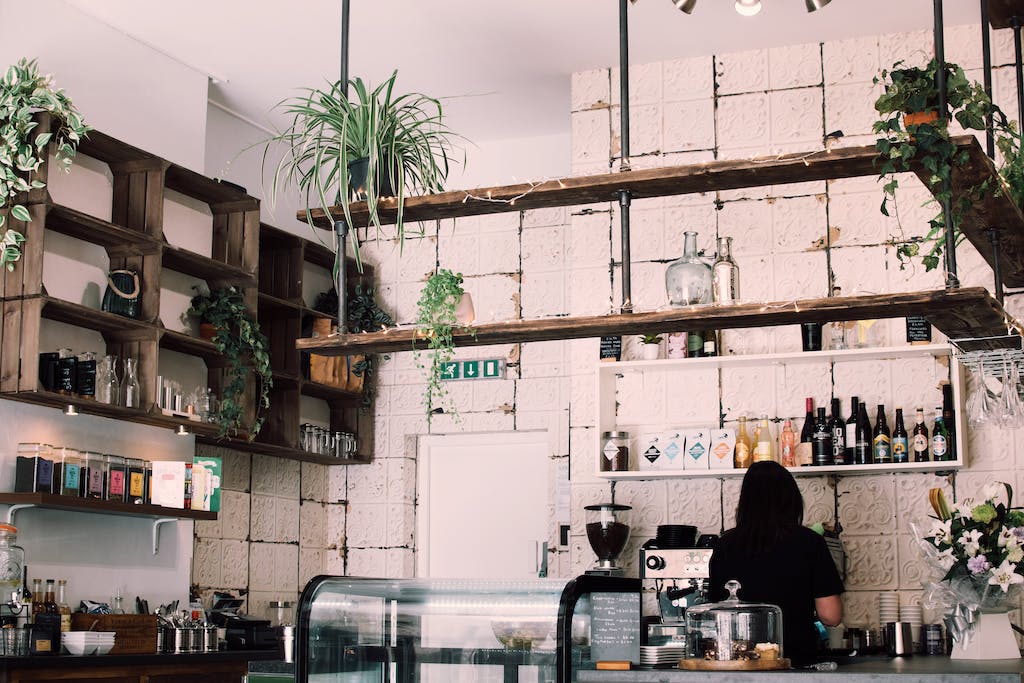
Organizational Structure and Management
At the heart of BizCafe’s operations is a meticulously designed organizational structure blended seamlessly with a strategic management approach that nurtures the establishment’s vision of providing premium refreshments in a conducive environment for work and relaxation. Responding to the needs of young professionals and students in New York, BizCafe emerges as a bastion of social interaction and productivity, coupled with the indulgence of gourmet coffees and teas.
The organizational design of BizCafe is anchored in clear-cut roles and responsibilities that promote a collaborative work culture while ensuring efficiency at every managerial and operational level. The leadership team is composed of seasoned professionals with complementary skills and expertise, shaping a cohesive unit that drives forward the company’s objectives.
Alex Taylor, the Co-Founder & CEO, brings a decade of hospitality industry experience and astute business management know-how. Alex’s insight into customer service excellence ensures that BizCafe not only meets but exceeds customer expectations. Jordan Lee, Co-Founder & CFO, with an MBA in finance, navigates the fiscal waters with precision, laying down a robust financial groundwork that underpins the projected growth of the venture.
Directing daily activities is Riley Kim, the Operations Manager, whose operational management prowess and in-depth knowledge of the food and beverage sector ensure that the café operates like a well-tuned engine. With a focus on implementing efficient operational workflows, monitoring inventory, and ensuring staff training is up to par, Riley forms the backbone of BizCafe’s organizational prowess.
Bringing the brand to life is Casey Morgan, the Marketing Director. With a rich background in brand development and digital marketing, Casey is instrumental in carving out BizCafe’s space in a crowded marketplace, pioneering innovative strategies that encapsulate the brand’s ethos and resonate with the target audience.
In confronting industry-specific challenges, BizCafe leverages a proactive risk mitigation framework. To counter fierce competition, the café distinguishes itself with unique branding and customer loyalty programs whilst remaining adaptable, with plans to diversify the menu and refine loyalty rewards should the need arise. Economic downturns are confronted with competitive pricing and keen value deals, backed by strategies to slash operational costs without compromising quality. The threat of supply chain disruption is addressed through multi-faceted supplier relationships and the maintenance of a buffer stock; contingency plans include procuring supplies from local purveyors. Changing consumer preferences are met with a continuously evolving menu informed by customer feedback, with rapid adjustments poised as a standby response to market trends. Regulatory changes are attentively monitored and promptly adhered to, with staff training ensuring compliance.
Projected financial targets are optimistic yet grounded, aiming for a break-even in the first year with subsequent annual growth. Strategic planning anticipates not just the upholding of a strong financial position but also the potential for expansion within the next five years, including the prospect of opening a second location or augmenting service offerings, buttressed by solid profitability and a well-entrenched brand reputation.
Marketing and sales imbue BizCafe with vibrancy, harnessing the power of social media marketing, community engagement, and digital outreach to create and nurture a loyal customer community. Loyalty programs incentivize repeat patronage, and partnerships with nearby businesses amplify the café’s presence and appeal.
In sum, BizCafe stands as a paradigm of a well-structured and astutely managed establishment, blending operational excellence and strategic acumen to deliver an unparalleled café experience and robust business performance. With an eye toward sustainability and another on innovative expansion, BizCafe is well-poised to become an emblematic landmark in New York’s coffee culture landscape.
BizCafe, endeavoring to become the favored haunt for the city's spirited young professionals and scholars, is a burgeoning sensation in the cafe industry. Our establishment seamlessly marries the artistry of specialty coffees and artisan teas with freshly crafted pastries and light meals that answer the call of diverse palates. BizCafe is more than just a retreat for coffee aficionados; it is also a nexus for connectivity, offering high-speed Wi-Fi and ample charging stations, crafted for those who yearn for a comfortable niche to work and study.
Our "Products and Services" section is designed to highlight the values and operational tenets that set BizCafe apart in an industry teeming with competition. We present an inviting atmosphere, friendly to both brisk morning commutes and leisurely afternoons. The sumptuous café offers an expanse where work, study, and informal meetings can unfold in comfort—a rarity in the frenetic pace of New York.
Economic downturns, competition, supply chain disruptions, and changing consumer preferences—the cafe industry is no stranger to these potential risks. To safeguard our venture and flourishing brand against these, we employ strategic forethought. Our robust branding and customer loyalty programs act as our shield against competition, with contingency plans to further diversify our menu and bolster those same loyalty offers if the market demands. We counter economic challenges with competitive pricing strategies complemented by precise operational cost management. We have fostered relationships with a broad network of suppliers and stock contingencies to ensure consistent provisions, with local sourcing as a standby plan against supply chain challenges. We keep our ears to the ground, adapting our menu to reflect market trends and customer feedback, always ready to implement rapid adjustments to meet evolving tastes.
Operational efficiency is the linchpin of our endeavor. With a keen eye on quality and customer satisfaction, we meticulously manage our supplier relationships, staff expertise, inventory, facility maintenance, and regulatory compliance. Our Operations Plan details the measures in place to maintain excellence all-round—from sustainably sourced coffee beans to the engaging customer service delivered by our handpicked team of baristas—all to orchestrate the perfect cafe experience.
BizCafe navigates the marketing arena with as much acumen as it brews espressos. Our Marketing and Sales Strategy is a keen fusion of online dazzle and offline substance. We utilize the sticky webs of social media to captivate our audience, forge loyalty through rewards programs, engage our community through vibrant events, and amplify our reach via collaborations with local businesses.
The coalescence of ambition and management comes into play when we shine a light on the key members of our team. Alex Taylor and Jordan Lee at the helm, their seasoned expertise in business management and financial acumen respectively, ensure that strategic direction and economic stability are a part of the company's bedrock. Bolstered by Riley Kim's operational oversight and Casey Morgan's dynamic marketing campaigns, BizCafe is a testament to exemplary leadership and team synergy.
Financial projections for BizCafe elucidate a narrative of growth and success. We anticipate a breakeven by year-end, which sets the pace for progressive revenue increases in the following years, ideally pivoting towards a significant milestone—potentially reaching a projected revenue of around $1 million by the fourth or fifth year.
Summarily, BizCafe is an enterprise that reverberates with the promise of quality, comfort, and connectivity, grounded firmly on the bedrocks of strategic risk management, operational integrity, and customer-centric growth plans. As we chart our course in New York's dense cafe sector, we remain dedicated to serving not just cups of specialty beverages but also fostering a dynamic hub of activity and relaxation that resonates with the city's beat.

In crafting the Marketing and Sales Strategy for BizCafe, we begin by addressing the fundamental attributes that set BizCafe apart. Our diverse offering of premium specialty coffees, artisan teas, savory pastries, and light meals is crafted to align with the tastes of our target demographic: young professionals and students who desire a blend of quality, convenience, and comfort. With facilities like high-speed Wi-Fi and readily available charging stations, we cater to the productivity and connectivity needs of our customers.
Our marketing framework is designed to communicate these core benefits effectively to our target market. Recognizing the inherent risks in a competitive industry, we've laid out strategies to mitigate these and developed contingency plans. Against competition, we counter with our boutique branding and tailored loyalty programs to foster a strong customer base. Should the competitive landscape intensify, we are prepared to diversify our menu and amplify our loyalty program benefits, further differentiating BizCafe.
In dealing with economic downturns, we focus on positioning our offerings as competitively priced without sacrificing quality. We also streamline operations and collaborate with cost-effective suppliers to maintain healthy margins. For supply chain disruptions, we've cultivated relationships with multiple vendors and maintain buffer stock levels. As an alternative if needed, we have contingencies to source locally.
To keep pace with evolving consumer preferences, we employ ongoing dialogue with our clientele, maintaining flexibility to adapt our offerings swiftly. To ensure readiness for any regulatory changes, we maintain an informed and proactive stance, with training programs to quickly bring staff up to speed on new requirements.
Our approach to market penetration and growth is multi-faceted. We blend organic and paid strategies, including:
- Social Media Marketing : We prioritize engagement on platforms like Instagram and Facebook, where our visual content can shine and resonate with the younger audience. We plan to utilize targeted ads, influencers, and content marketing to bolster our online presence and drive foot traffic.
- Loyalty Programs : We leverage loyalty programs to maintain high customer retention rates, offering rewards that incentivize repeat visits.
- Community Engagement : We understand the value of an integrated community; hence, we host events and workshops aimed at building relationships and encouraging networking within our space. These events range from coffee tastings to productivity workshops, appealing to our demographic of professionals and students.
- Collaborations with Local Businesses and Educational Institutions : Partnering with like-minded businesses and local colleges allows us to extend our reach through cross-promotion while also tapping into existing networks of potential loyal customers.
- Digital Presence and Online Ordering : Given the proclivity of our audience for digital convenience, we maintain a strong digital presence through a user-friendly website and online ordering capabilities for pickups and deliveries.
- Email Marketing : Through carefully curated newsletters, we share updates, promotions, and exclusive offers to maintain engagement with our existing customer base, ensuring that BizCafe remains top-of-mind.
In parallel with these efforts, we recognize the need for a firm foundation. The organizational structure of BizCafe, an LLC, offers flexibility in management with personal liability protection for the owners. Our key management team members, each expert in their field, ensure operations align with strategic goals.
In summary, the Marketing and Sales Strategy for BizCafe is robust, diversified, and perfectly tailored to our target customer's lifestyle. It intertwines BizCafe’s core service offerings with innovative promotional tactics that are set to carve out a significant market share, promising growth, and an irreplaceable spot in our community's daily routine.
BizCafe, nestled within the vibrant streets of New York, is set to reinvigorate the traditional café experience by aligning it with the contemporary lifestyle and preferences of our target market—students and young professionals aged 20-35. Our operations plan is conceived to underpin this dynamic business model by ensuring efficiency, quality, and customer satisfaction.
Our strategic location—a nexus of cultural diversity and a hub for millennial activity—provides BizCafe with the advantage of tapping into a rich customer base yearning for a unique café experience. The provision of high-speed Wi-Fi and charging stations distinguishes us from traditional coffee shops, catering to patrons who seek a conducive place to work or study while indulging in our specialty coffees, artisan teas, and an assortment of pastries and light meals.
Addressing the operational execution, BizCafe will adopt a meticulous approach towards supply management. We shall form strategic alliances with reputable local suppliers to ensure a consistent supply of premium-quality coffee beans, tea leaves, and fresh ingredients for our culinary offerings. These partnerships will enable us to maintain our commitment to quality and sustainability—a fundamental trait of the BizCafe brand.
We recognize that our staff are the ambassadors of our brand. Hence, we will employ skilled baristas and support staff who exhibit a combination of technical expertise in coffee-making and a passion for customer service. A rotating shift system will be implemented to optimize staff utilization across our business hours, ensuring that our service quality does not waver during peak times.
In our quest for excellence, quality control remains paramount. Routine training sessions will be conducted to educate our staff on food safety and the meticulous preparation of our beverages, thereby upholding our promise of consistently high-quality products. We shall leverage advanced inventory management software to monitor stock levels, minimize waste, and streamline the replenishment process.
Realizing the necessity of maintaining an inviting and operational facility, we commit to routine maintenance checks of our café space and the upkeep of our coffee-making equipment. This ensures a pleasurable ambience for our customers and uninterrupted service delivery.
Our financial management, spearheaded by our CFO, will involve regular reviews and proactive budgeting to keep our financial goals on track. This financial foresight, coupled with the implementation of a comprehensive customer feedback system, will enable us to respond adeptly to market demands and elevate our service offerings.
Health and safety compliance is non-negotiable. We pledge to adhere rigorously to local health and safety regulations, conducting regular staff training and audits to foster a safe environment for both our patrons and our team.
BizCafe’s operations plan is not merely a blueprint for daily management but a reflection of our commitment to excellence in providing a compelling café experience. With this at our core, we set forth on a path to build BizCafe into a revered brand synonymous with quality, innovation, and unmatched customer service.

The Financial Projections section provides a forecast that is essential for understanding BizCafe's potential for growth, profitability, and financial stability. This forecast is based on a comprehensive analysis of the current market, comparable business models, consumer behavior, and the broader economic climate. While projections inherently contain assumptions and estimations, they aim to present the most probable outcomes given the business environment and strategies in place.
BizCafe’s financial journey commences with the strategic objective of reaching its break-even point by the end of the first operational year, which aligns with projected revenues of approximately $500,000. Achieving this milestone will signify the successful penetration of BizCafe into the cafe industry and establish a strong foundation for subsequent growth. To facilitate this target, marketing efforts will be ramped up to raise brand awareness and drive traffic to the storefront. Cost management will also remain at the forefront, ensuring expenses are aligned with our growth strategy.
The following years, two and three, are projected to herald a period of steady growth. With established brand recognition and an expanding loyal customer base, we anticipate revenue growth of approximately 20% annually. This growth will be driven by a combination of factors, including an increased adoption of BizCafe's loyalty program, the introduction of new menu items in response to market trends, and strategic marketing campaigns designed to expand our reach. During this period, we anticipate revenues to reach approximately $720,000 by the end of year three, and we project improvement in profit margins due to enhanced operational efficiencies and economies of scale.
Years four and five mark the expansion phase for BizCafe. Fortified by a strong, loyal following and increased cash flows, this chapter will explore new avenues for expansion, which may include the opening of a second location or diversifying service offerings to cater to additional segments, like corporate catering or evening social events. These growth opportunities could further augment revenue, with a possibility of surpassing $1 million by the close of year five.
Throughout this five-year span, BizCafe will remain steadfast in executing our marketing and sales strategies to support these financial goals. Our multi-channel approach, which includes establishing a substantive digital presence, engaging with the community, partnering with local businesses, and consistent brand messaging, will be instrumental in driving sales and increasing profitability.
In preparing these financial projections, we also recognize and plan for potential risks and have formulated mitigation strategies. From the outset, BizCafe will establish a contingency reserve to safeguard against unexpected economic downturns, competitive pressures, or supply chain disruptions, ensuring operational stability and financial resilience.
The projected performance is reliant on the strategic execution by our experienced management team, who will maintain vigilant oversight of financial health. CEO Alex Taylor will lead the charge with a focus on cultivating a high-performing team and elevating the customer experience, while CFO Jordan Lee will enforce rigorous financial controls to safeguard against overspending and cash flow shortfalls.
In summary, BizCafe’s financial projections are rooted in a blend of conservative assumptions and strategic optimism. Our envisioned growth trajectory capitalizes on market opportunities and prudent financial management, positioning BizCafe as a compelling new entrant in the New York cafe sector with robust prospects for enduring success.
Risk management is a critical component for the success of any business, and BizCafe is no exception. Our risk analysis outlines potential challenges that BizCafe may face and establishes mitigation strategies and contingency plans to navigate these risks effectively.
Competition
The café sector in New York is highly competitive, with several key players such as Java Junction, The Study Spot, Green Leaf Tea House, and Urban Grind already established in the marketplace. Each competitor brings strengths to the table: Java Junction's wide variety of coffee blends appeals to busy professionals; The Study Spot attracts students and academics with a quiet atmosphere; Green Leaf Tea House draws in health-conscious clientele with organic offerings; and Urban Grind is favored for its trendy ambiance among young adults.
To mitigate this risk, BizCafe’s strategy hinges on unique branding and building a strong customer loyalty program that incentivizes repeat visits. Our contingency plan includes diversifying our menu options and enhancing loyalty programs to retain customers and attract new ones, even in a saturated market.
Economic Downturns
Providing luxury discretionary products such as specialty coffee, economic downturns could pose a significant risk to BizCafe’s profitability. Customers may cut back on non-essential spending during these periods.
Mitigation for this risk involves offering competitive pricing and creating value deals that are attractive to customers looking for affordable luxury. Our contingency includes reducing operational costs, such as renegotiating leases or finding cost-effective suppliers without compromising the quality of our products.
Supply Chain Disruption
Supply chain volatility can affect the availability of critical inputs like coffee beans, specialty teas, and baked goods. This risk could be caused by global events, natural disasters, or other unforeseen disruptions.
To counteract this, BizCafe will establish relationships with multiple suppliers and maintain a buffer stock to safeguard against short-term disruptions. The contingency plan focuses on developing local sourcing alternatives to reduce dependency on distant supply chains.
Changing Consumer Preferences
Consumer tastes in the food and beverage industry are constantly evolving. Failure to adapt to these changes can result in loss of market share.
Our approach includes staying abreast of industry trends and customer feedback to adapt our menu accordingly. As a contingency measure, BizCafe is prepared for rapid menu adjustments and the roll-out of new products, keeping our offerings fresh and aligned with customer preferences.
Regulatory Changes
Operating in the food and beverage industry, BizCafe must comply with numerous regulations concerning health and safety, labor laws, and food standards. Regulatory changes could impose additional costs or require operational adjustments.
Our mitigation strategy involves staying informed of regulatory changes and ensuring full compliance. Should significant regulatory changes be implemented, our contingency plan includes swiftly revising operational practices and investing in staff training to meet new requirements.
Financial Management
BizCafe’s financial health is paramount to its success. Poor financial management could lead to cost overruns, inadequate cash flow, and ultimately, business failure.
To mitigate this risk, regular financial reviews and strict budgeting practices will be instituted, overseen by our experienced CFO, Jordan Lee. Our risk-averse financial strategy involves conservative projections with room for agile adjustments to the market’s ebbs and flows.
In conclusion, BizCafe's risk analysis is comprehensive, taking into account a multitude of factors that could influence the café's success. By employing proactive mitigation strategies and having robust contingency plans, BizCafe is poised to address these risks effectively while remaining focused on delivering exceptional service to our target market.
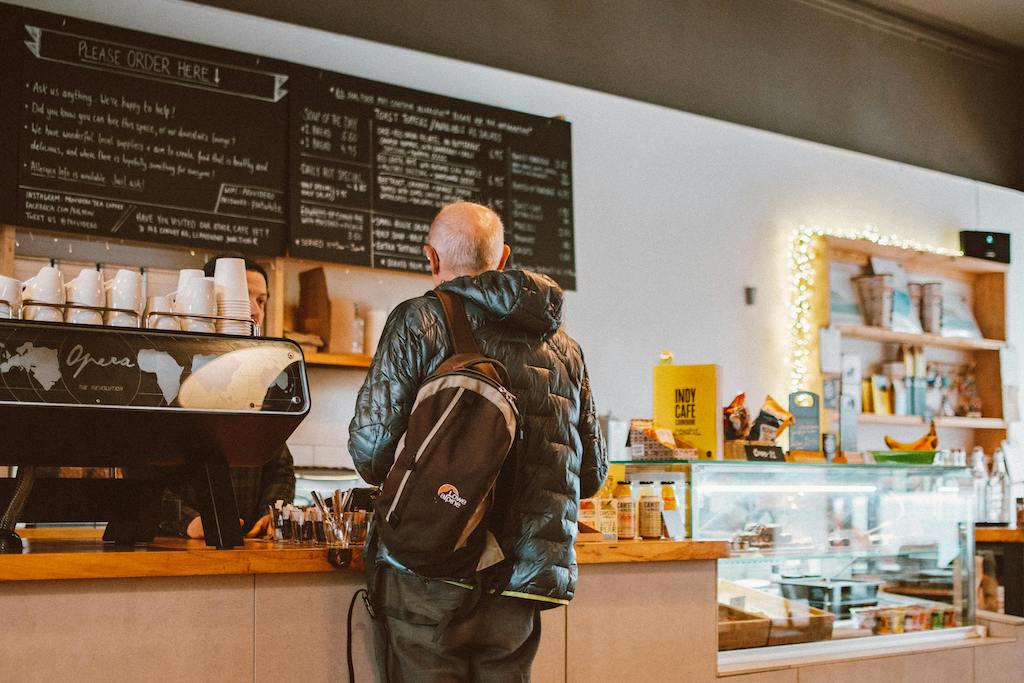
More business plan templates
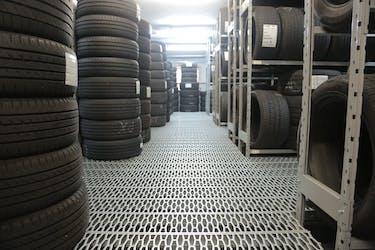
Tire shop business plan

Sandwich shop business plan

Laundromat business plan
BUSINESS STRATEGIES
How to write a coffee shop business plan
- Nirit Braun
- Oct 30, 2023
- 12 min read

A coffee shop business plan is a detailed and strategic document outlining the essential aspects of starting and operating a coffee-focused business. It encompasses a comprehensive analysis of the business's goals, target audience, competitive landscape, marketing strategies, financial projections, operational procedures and more. This plan acts as a roadmap that guides entrepreneurs through the various stages of establishing and running their coffee shop, providing clear direction and a solid foundation for success.
When starting a business, especially in the competitive and dynamic realm of the coffee industry, creating a comprehensive and clear business plan is of paramount importance.
Ready to get your business brewing? Take Wix’s website builder for a whirl.
Top benefits of creating a coffee shop business plan
A well-crafted business plan helps entrepreneurs articulate their business goals, whether it's about offering unique coffee blends, creating a cozy ambiance or supporting sustainable sourcing practices. At the same time, a business plan requires entrepreneurs to identify and understand their target audience. This insight helps tailor marketing strategies, menu offerings and the overall customer experience to meet the specific preferences and needs of the intended customers.
Here's an overview of some key advantages to creating a coffee shop business plan:
Attracting investors and funding: A well-structured business plan acts as a persuasive tool when seeking investors or raising money for your business . It showcases your thorough understanding of the coffee industry, market trends and your strategies for success. This level of preparedness increases your credibility and instills confidence in potential investors, making them more likely to support your coffee shop venture.
Clear resource requirements: Writing a business plan prompts you to identify the specific resources, supplies and staff necessary to launch and operate your coffee shop. This includes everything from coffee beans and brewing equipment to furniture and interior decor.
Strategic financial planning: A comprehensive business plan outlines your financial projections, startup costs, operating expenses and revenue forecasts. This level of financial planning helps you determine how much funding you need to start a business . It also guides you in setting prices, managing cash flow and assessing profitability.
Market understanding and differentiation: Through market research and analysis, a business plan allows you to understand your target audience's preferences, behaviors and expectations. This knowledge helps you tailor your coffee shop's offerings, ambiance and marketing strategies to effectively attract and retain customers.
Risk mitigation: The process of creating a business plan prompts you to identify potential risks and challenges that your coffee shop might face. By acknowledging and addressing these risks early on, you can develop contingency plans and strategies to mitigate their impact.
Operational efficiency: A business plan outlines the operational processes required to run your coffee shop smoothly. It includes staffing plans, inventory management strategies and quality control measures. By establishing efficient procedures from the outset, you can minimize wastage, optimize resource allocation and ensure consistent customer satisfaction.
Goal setting and tracking: Your business plan serves as a benchmark against which you can measure your coffee shop's performance over time. By setting clear goals and key performance indicators (KPIs), you can track your progress and make necessary adjustments to stay on course toward achieving your objectives.
How to create a coffee shop business plan in 6 steps
Now we’ll walk through the six essential steps for crafting a coffee shop business plan tailored to your company's unique needs.
Executive summary
Business and domain names
Market analysis and research
Operations plan
Marketing and advertising plan
Financial plan
01. Executive summary
Your executive summary is a concise and compelling overview of your coffee shop business plan. It encapsulates the key elements of your plan and provides a snapshot of your business concept, strategies and financial projections. While appearing at the start of the business plan, it's often written last, as it draws from the content of the entire document.
A clear executive summary for a coffee shop business should include:
The essence of your coffee shop: What makes it unique? What kind of experience will customers have when visiting your establishment?
Market potential and your target audience: Explain why your coffee shop is well-positioned to capture this opportunity.
Competitor landscape: Identify what sets your coffee shop apart from the competition. This could be your specialty coffee blends, unique ambiance, sustainable practices or exceptional customer service.
Example executive summary for a coffee shop: "Bean Haven Coffee is a meticulously crafted coffee shop that aims to provide not just beverages, but an immersive coffee experience. We pride ourselves on our curated selection of ethically sourced beans, offering customers the finest hand-crafted brews in a cozy, rustic ambiance. Our competitive edge lies in our commitment to sustainability, from our bean-sourcing practices to our eco-friendly packaging. With a strong emphasis on community engagement and partnerships with local artists, we are set to become a cultural hub that brings people together over a shared love for exceptional coffee. Through strategic marketing campaigns, leveraging social media and collaborating with nearby businesses, we aim to establish Bean Haven Coffee as the go-to destination for coffee enthusiasts and connoisseurs alike. Our projected financials indicate that we will reach profitability within the first 18 months of operation. We seek funding to cover initial startup costs and our business model is designed to achieve sustainable growth and profitability."
02. Company and domain names
Knowing how to name a business is crucial for a coffee shop venture and a key step before you register your business . A strong and memorable name can resonate with customers and differentiate your coffee shop from competitors. Use descriptive words that reflect your coffee shop's essence, whether it's about taste, ambiance or values.
Utilizing a business name generator like the one from Wix can provide inspiration and spark creativity. Play with different combinations of words and ideas until you find a name that feels right. Once you've settled on a name, check its availability for domain registration. A domain name that matches your company name is essential for an effective online presence.
When choosing a domain name consider the following best practices:
Ensure that the domain name reflects your coffee shop's identity and offerings
Choose a name that is easy to spell and remember
Opt for a timeless name that won't become outdated quickly
If possible, include relevant keywords in the domain to improve search engine visibility
Steer clear of names that are easily confused with competitors or other brands
03. Market analysis and research
With more than 38,000 coffee shops in the U.S. alone, there are plenty of competitors to analyze. Including a comprehensive market analysis in your business plan is essential for understanding the competitive landscape and formulating effective strategies. Research your local coffee market, identify existing competitors and analyze their strengths and weaknesses. Determine your target audience's preferences, behaviors and demographics to tailor your offerings and marketing campaigns accordingly.
A well-rounded market analysis can guide your business strategy, helping you position your coffee shop effectively, develop compelling value propositions and devise strategies to capture your desired market share.
04. Operations plan
The operations plan is a crucial section of your coffee shop business plan. It outlines the practical aspects of running your coffee shop. Use it to describe your chosen location and its significance for foot traffic, accessibility and target audience reach.
Then, take the opportunity to detail the interior design, layout and ambiance of your coffee shop to create a welcoming atmosphere. Next be sure to list the equipment needed for brewing, food preparation and service. Ensure it aligns with your menu and production capacity. Finally define the roles and responsibilities of your staff, from baristas to managers, and outline their qualifications and training needs.
05. Marketing and advertising strategies
The marketing and advertising portion of your business plan outlines your strategies for promoting your coffee shop and attracting customers. Depending on your target audience and brand positioning for this type of business , consider a mix of traditional and digital marketing methods. This means using social media platforms like Instagram, Facebook and Twitter to showcase your coffee creations, engage with customers and share your coffee shop's story. Collaborate with influencers, local organizations or other businesses to expand your reach and tap into new customer segments.
Additionally, you can choose to participate in community events, farmers' markets and collaborations with other local businesses to increase your visibility. Also consider implementing loyalty programs that reward repeat customers and incentivize them to visit regularly.
You’ll need to develop a suite of brand assets to use in your marketing as well, starting with a company logo. You can use a free logo maker to get a professional design in minutes.
Learn more: How to make a website
06. Financial plan
The cost to start a coffee shop business can range from $50,000 for a mobile operation to over $400,000 for a brick-and-mortar location with booth seating and a drive-thru. This hefty expense is just another reason why a financial plan is so important.
The financial plan is the backbone of your coffee shop business plan. It outlines your startup costs, operating expenses, revenue projections and funding strategy. Investors and lenders will closely scrutinize this section to assess the viability of your coffee shop venture, so remember to do the following:
Detail the initial investment required for equipment, interior design, licenses and permits
Estimate ongoing costs such as rent, utilities, supplies and salaries
Provide realistic revenue forecasts based on your expected capacity and customer traffic
Specify how you plan to secure funding
Highlight when you anticipate reaching profitability and generating positive cash flow
By meticulously planning your finances, you demonstrate a solid understanding of the financial aspects of your coffee shop business and showcase its potential for success.

Coffee shop business plan examples
Below we’ve put together business plan templates for two hypothetical coffee shop businesses, including all the sections discussed in our previous how-to steps.
Coffee shop business plan template 1: Coffee Haven Café
Coffee Haven Café is a charming coffee shop dedicated to delivering a premium coffee experience in a cozy and inviting setting. Our unique blends, ethically sourced beans and commitment to sustainability set us apart in a competitive market. By fostering community engagement and partnering with local artists, we aim to become a cultural hub that brings people together over exceptional coffee. Through strategic marketing efforts and a strong online presence, we project profitability within 18 months.
Company and domain name
Company name: Coffee Haven Café
Domain name: www.coffeehavencafe.com
Our marketing analysis revealed a growing demand for specialty coffee in our target location. We've identified key competitors and highlighted their strengths and weaknesses. Our target audience consists of young professionals and students who value quality and ambiance. By understanding these dynamics, we can tailor our offerings and marketing strategies effectively.
Location: Centrally located in a busy commercial area with high foot traffic
Premises: Rustic and inviting interior design that promotes relaxation and conversation
Equipment: High-quality espresso machines, grinders, brewing equipment and display cases for baked goods
Staffing: Experienced baristas, friendly waitstaff and a dedicated manager to oversee operations
Social media: Engage customers through Instagram, Facebook and X with enticing coffee shots and behind-the-scenes content
Local events: Participate in local festivals, art exhibitions and collaborate with nearby businesses for cross-promotions
Content marketing: Regular blog posts on coffee trends, brewing tips and spotlight features on local artists
Loyalty programs: Offer a loyalty card program with rewards for frequent visitors
Partnerships: Collaborate with nearby bookstores for reading sessions and local influencers for social media endorsements
Startup costs: $70,000 for equipment, furnishings, licenses and initial inventory
Operating expenses: Estimated monthly costs of $12,000 covering rent, utilities, supplies and staff salaries
Revenue projections: Projected revenue of $300,000 in the first year, growing to $450,000 in the second year
Funding strategy: Initial funding from personal savings and a small business loan from a local bank
Profitability timeline: Aim to achieve profitability within 18 months of operation
Coffee shop business plan template 2: Brew & Gather Coffee House
Brew & Gather Coffee House is a community-focused coffee shop aiming to create a warm and inclusive space for coffee enthusiasts. Our commitment to locally sourced ingredients and artisanal brewing techniques sets us apart. By fostering partnerships with neighboring businesses and hosting regular events, we aim to become a staple in the neighborhood. Our projected financials indicate profitability within the first two years.
Company name: Brew & Gather Coffee House
Domain name: www.brewandgathercoffee.com
Through extensive market research, we've identified an opportunity to serve a diverse community seeking an authentic and welcoming coffee experience. We've assessed competitors' offerings and identified an untapped niche. Understanding our target audience's preferences and values will guide our menu and marketing strategies.
Location: Situated near a local park, providing an oasis for relaxation and community gatherings
Premises: Modern yet cozy interior design with flexible seating arrangements to accommodate groups and individuals
Equipment: State-of-the-art espresso machines, pour-over stations and an open bakery display
Staffing: A blend of skilled baristas, friendly hosts and a community engagement coordinator
Social media: Utilize Instagram and TikTok to showcase brewing techniques, share customer stories and host virtual coffee-tasting sessions.
Local events: Host open mic nights, book clubs and workshops to engage the community.
Content marketing: Publish a monthly newsletter featuring coffee culture insights, staff spotlights and local partnerships.
Loyalty programs: Introduce a tiered membership program offering exclusive discounts and early access to events.
Partnerships: Collaborate with local farmers, artisans and musicians to create a truly immersive community experience.
Startup costs: $100,000 for leasehold improvements, equipment, permits and initial inventory
Operating expenses: Projected monthly expenses of $15,000, covering rent, utilities, wages and supplies
Revenue projections: Anticipate revenue of $350,000 in the first year, with a 15% increase in the second year
Funding strategy: Initial investment from personal savings and a crowdfunding campaign targeting the local community
Profitability timeline: Aim to reach profitability within the first two years of operation
How profitable is a coffee shop?
The profitability of a coffee shop can vary depending on a number of factors, including location, business model and marketing strategy. However, in general, coffee shops can be quite profitable.
According to a report by IBISWorld, the average profit margin for coffee shops is 8.33%. This means that for every $100 in revenue, coffee shops generate $8.33 in profit.
Some coffee shops are even more profitable. For example, coffee shops located in high-traffic areas, such as airports and office buildings, can generate profit margins of up to 15%. And coffee shops that sell specialty coffee drinks and food items can also generate higher profit margins.
Here are some tips for increasing the profitability of your coffee shop:
Choose a good location. A good location is essential for success. Look for a location that is convenient for potential customers and has high visibility.
Offer a unique selling proposition. What makes your coffee shop different from others? What can you offer that your competitors cannot?
Provide excellent customer service. This is essential for building a loyal customer base. Make sure your staff is friendly and knowledgeable, and that they are always willing to go the extra mile for your customers.
Market your coffee shop effectively. Let potential customers know about your coffee shop and the unique offerings you have. You can do this through online marketing, social media and word-of-mouth.
Control your costs. Coffee shops have high costs, so it's important to control your costs as much as possible. This means negotiating good deals with your suppliers, managing your inventory carefully and keeping your labor costs under control.
Why do coffee shops fail?
There are a number of reasons why coffee shops fail. Some of the most common reasons include:
Poor location: A coffee shop in a bad location won't attract enough customers to be successful. Coffee shops need to be located in areas with high foot traffic, such as near office buildings, universities and parks.
High overhead costs: Coffee shops have high overhead costs, such as rent, utilities and labor. If a coffee shop can't generate enough revenue to cover its overhead costs, it will eventually fail.
Poor management: Poor management can lead to a number of problems, such as low customer satisfaction, high employee turnover and financial difficulties. Coffee shop owners need to have a strong business plan and be able to manage their finances effectively.
Lack of marketing: Coffee shops need to market themselves effectively to attract new customers and keep existing customers coming back. Coffee shop owners need to develop a marketing plan and budget, and they need to track their results to see what is working and what is not.
Competition: The coffee shop industry is very competitive. Coffee shops need to offer something unique to stand out from the competition.
Coffee shop business plan FAQ
How do you start a coffee shop business plan.
To start a coffee shop business plan, you need to consider the following factors:
Location: Choose a location that is convenient for potential customers and has high visibility.
Target market: Identify your target market and tailor your business plan to their needs and preferences.
Menu: Develop a menu that includes a variety of coffee drinks and food items that will appeal to your target market.
Pricing: Set prices that are competitive and generate a sufficient profit margin.
Operating costs: Estimate your operating costs, such as rent, utilities, labor and inventory.
Marketing: Develop a marketing plan to reach your target market and generate awareness of your coffee shop.
How many cups of coffee does a coffee shop sell per day?
Is a small coffee shop profitable, what percentage of coffee shops are successful, want to cook up another business plan.
How to create a bakery business plan
How to create a bar business plan
How to create a virtual assistant business plan
How to create a cleaning business plan
How to create a plumbing business plan
How to create a trucking business plan
How to create a daycare business plan
How to create a food truck business plan
How to create a restaurant business plan
How to create a clothing line business plan
How to create a hair salon business plan
How to create a real estate business plan
How to create a contractor business plan
How to create a vending machine business plan
How to create a party planning business plan
Looking for another business idea?
How to start an online business
How to start a consulting business
How to start a fitness business
How to start a fitness clothing line
How to start a makeup line
How to start a candle business
How to start a clothing business
How to start an online boutique
How to start a T-shirt business
How to start a jewelry business
How to start a subscription box business
How to start a beauty business
How to start a flower business
How to start a car wash business
How to start a food prep business
How to start a DJ business
How to start a pool cleaning business
How to start a baking business
How to start a trucking business
How to start a construction business
How to start a landscaping business
How to start a food business
How to start a vending machine business
How to start a contractor business
How to start a coaching business
Coffee dropshipping

Looking to start a business in a specific state?
How to start a business in Arizona
How to start a business in South Carolina
How to start a business in Virginia
How to start a business in Michigan
How to start a business in California
How to start a business in Florida
How to start a business in Texas
How to start a business in Wisconsin
Related Posts
How to create a website from scratch in 11 steps (for beginners)
How to start a business in 14 steps: a guide for 2024
How to start a coffee shop
Was this article helpful?

- STARTUP COURSE AND DOCUMENTS
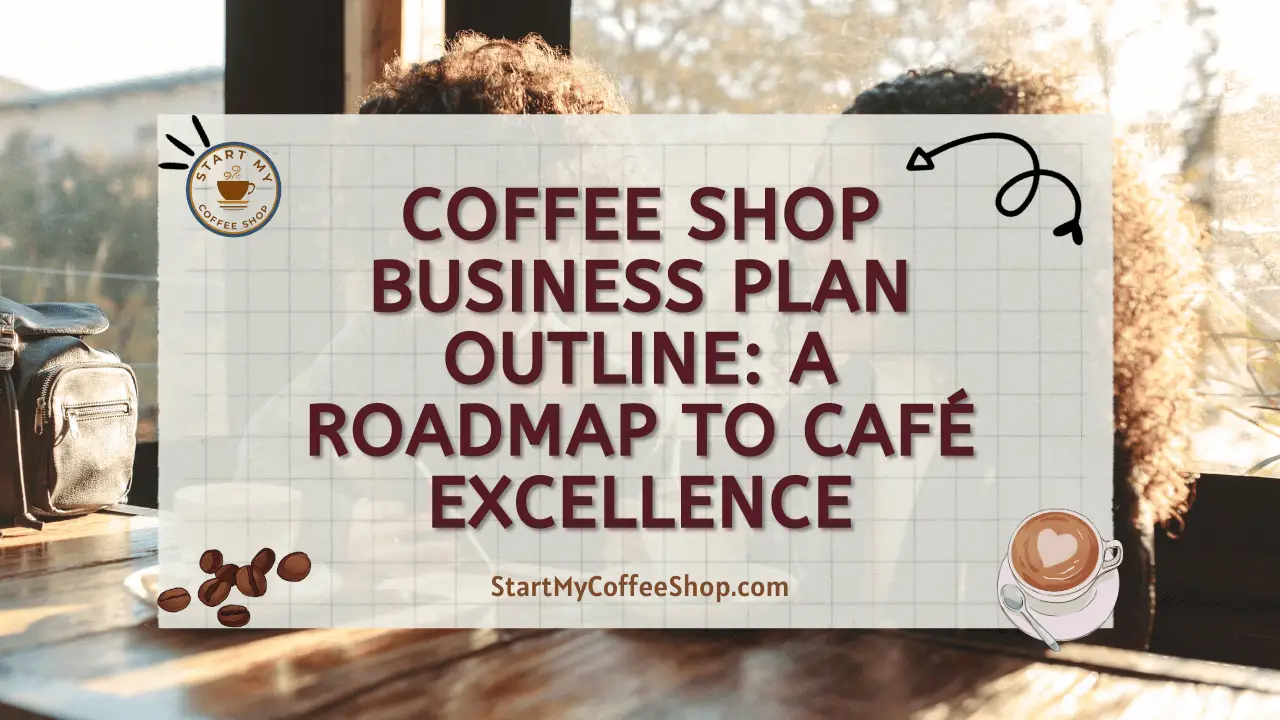
Coffee Shop Business Plan Outline: A Roadmap to Café Excellence
In today’s fast-paced world, coffee shops have become more than just places to grab a quick caffeine fix. They serve as community hubs, meeting places, and havens for individuals seeking a cozy ambiance and a delicious cup of coffee. If you’re considering starting your coffee shop, having a well-thought-out business plan must be the first thing you need to consider.
A coffee shop business plan should have an executive summary, company description, market analysis, product and services, marketing and sales strategies, organization and management structure, financial projections, operations and logistics, SWOT analysis, sustainability efforts, risk management, and an exit strategy.
In this article, I will provide you with an outline to help you kick-start your coffee shop venture.
Table of Contents
1. Executive Summary
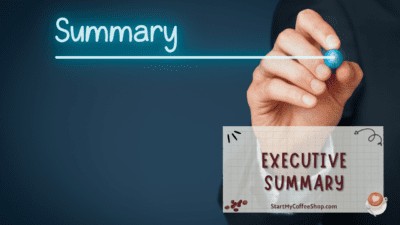
The executive summary is a vital section of your coffee shop business plan as it provides a concise overview of your venture. It serves as a snapshot of your entire plan, offering potential investors or partners a clear understanding of your business.
In this summary, you should outline your vision, target market, unique selling proposition, and financial goals succinctly. By encapsulating these key elements, the executive summary acts as a powerful tool to grab the attention of readers, enticing them to delve deeper into your comprehensive plan and consider the potential of your coffee shop business.
Read more about: Business Plan on Coffee Cafe: Coffee Dreams to Reality
2. Company Description
In the section dedicated to describing your coffee shop concept, it is important to provide a comprehensive overview. Start by sharing the name, location, and mission statement of your coffee shop. Dive deeper into the type of coffee shop you envision, whether it’s a welcoming neighborhood café, a specialty coffee roaster focusing on single-origin beans, or a trendy espresso bar serving innovative brews.
Emphasize what sets your coffee shop apart from competitors, such as your unique menu offerings, sustainable sourcing practices, or commitment to supporting local artisans. Additionally, discuss your strategies for delivering exceptional customer experiences, such as providing friendly and knowledgeable staff, creating an inviting ambiance, and offering personalized service that exceeds expectations.
By clearly communicating your vision and differentiation, you will pique the interest of potential investors and partners, showcasing the potential for success in the competitive coffee shop industry.
3. Market Analysis
Making a thorough market analysis is a crucial stage in creating your business plan for your coffee shop. It entails a thorough investigation of both the local coffee scene and your target demographic. You can learn a lot about the requirements, preferences, and behaviors of your customers by examining the demographic, psychographic, and geographic elements that affect their preferences.
Furthermore, assessing the competitive landscape allows you to understand existing coffee shops, their strengths, weaknesses, and market positioning. This analysis provides you with a clear understanding of the market opportunities and potential challenges you may encounter.
With this knowledge, you can make adjustments to your branding and marketing tactics to further distinguish your coffee shop and draw in your target demographic. You lay the groundwork for a successful coffee shop business that is in sync with the local coffee scene and ready for development by doing a thorough market analysis.
4. Products and Services

Describe the variety of coffee products and additional offerings you plan to provide. Discuss the sourcing of your coffee beans, whether you intend to partner with local roasters or establish direct trade relationships with coffee farmers. Highlight any unique or specialty beverages you plan to offer, such as cold brews, pour-overs, or signature blends. Additionally, outline any complementary products or services, such as pastries, sandwiches, or merchandise.
Read more about: Business Plan of Coffee Shop: Aroma and Ambition
5. Marketing and Sales Strategy
When describing the variety of coffee products and additional offerings in your coffee shop business plan, provide a comprehensive overview. Start by discussing the sourcing of your coffee beans, showcasing your commitment to quality and sustainability. You may highlight partnerships with local roasters, ensuring a focus on supporting the community and promoting local flavors. Alternatively, you might emphasize direct trade relationships with coffee farmers, emphasizing fair and ethical practices.
In addition to standard coffee options, mention any unique or specialty beverages that will set your coffee shop apart. These could include cold brews with innovative flavor profiles, meticulously brewed pour-overs showcasing the nuances of different coffee beans, or signature blends crafted exclusively for your shop.
Outline any complementary products or services that will enhance the customer experience. This may include a delectable selection of pastries made in-house or sourced from local bakeries, sandwiches crafted with fresh ingredients, or merchandise like branded mugs and apparel that customers can purchase as mementos of their visit.
6. Organization and Management
In outlining the structure of your coffee shop business, it is important to provide a clear understanding of the roles and responsibilities of key personnel. Discuss the qualifications and experience of your management team, underscoring their expertise in the café industry and their ability to drive your business forward. If you are a sole proprietor, detail your responsibilities and lay out your plans for hiring additional staff as your business grows.
Highlight the significance of training programs that will equip your team with the necessary skills to deliver exceptional service. Emphasize your commitment to fostering a positive work culture, where employees feel valued and motivated to provide outstanding customer experiences.
7. Financial Projections

When presenting your financial projections in the coffee shop business plan, it is crucial to provide a comprehensive overview of your financial expectations. Start by outlining the startup costs involved, including expenses for rent, renovation, equipment, furniture, permits, and licenses.
Next, detail your revenue forecasts based on your target market, pricing strategy, and projected sales volume. Consider factors such as seasonality and local economic conditions that may impact your revenue streams.
Include a detailed budget that encompasses all operating expenses, including costs for inventory, supplies, utilities, marketing and advertising, staff salaries, and insurance. This will demonstrate a clear understanding of the financial requirements of running the coffee shop on a day-to-day basis.
Consider creating a three-year projection that illustrates the growth potential of your coffee shop. This can include anticipated increases in revenue, expansion plans, and adjustments to expenses as your business matures.
Furthermore, discuss your funding requirements and potential sources of investment. If you plan to seek financing from banks or investors, highlight the expected return on investment and outline how the funds will be utilized to support the growth and success of your coffee shop.
Read more about: Business Plan of a Coffee Shop: Bean Business Blueprint
8. Operations and Logistics
When providing insights into the day-to-day operations of your coffee shop in the business plan, it is essential to cover key aspects. Begin by describing the layout and design of your space, considering factors such as seating capacity, restroom facilities, and strategic placement of equipment to optimize workflow.
Discuss your inventory management processes, highlighting how you will track stock levels, manage orders, and ensure a consistent supply of coffee beans, ingredients, and other necessary items. Mention your supplier relationships and any efforts to source high-quality products.
Outline your planned hours of operation, taking into account peak hours and potential variations based on customer demand. Address staffing requirements, detailing the number of employees needed to run your coffee shop effectively. Additionally, describe your employee scheduling approach to ensure smooth operations and adequate coverage during busy periods.
9. SWOT Analysis
Conducting a comprehensive SWOT (Strengths, Weaknesses, Opportunities, and Threats) analysis is crucial for evaluating both the internal and external factors that can impact your coffee shop business. Start by identifying your strengths, which could include aspects like a unique menu, exceptional customer service, a prime location, or a strong brand presence. These strengths differentiate your business from competitors and contribute to your competitive advantage.
Next, assess your weaknesses and areas that require improvement, such as limited parking space, lack of visibility, or a need for additional staff training. Addressing these weaknesses will help you enhance the overall efficiency and performance of your coffee shop.
Identify growth opportunities, such as expanding your product offerings, exploring new markets, or partnering with local businesses for cross-promotion. Capitalizing on these opportunities can lead to increased revenue and market share.
Finally, consider potential threats that may arise from competition, changing consumer preferences, or economic fluctuations. Analyze how these threats could impact your coffee shop and develop strategies to mitigate their impact.
10. Sustainability and Social Responsibility
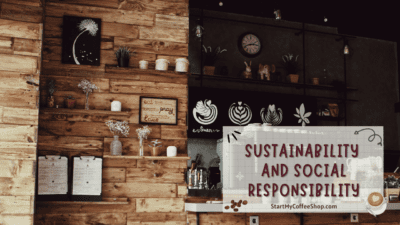
In today’s coffee industry, sustainability and social responsibility play an increasingly significant role. It is crucial to address this growing importance in your coffee shop business plan. Discuss your commitment to environmentally friendly practices, such as using biodegradable cups, implementing recycling programs, or sourcing and promoting fair trade coffee.
Highlight any partnerships with local organizations or initiatives that align with your values and contribute to a sustainable coffee supply chain. Communicate your dedication to giving back to the community and fostering a positive impact through initiatives like supporting local farmers, donating a portion of profits to charitable causes, or participating in community events.
Read more about: Business Plan Mobile Coffee Truck: The Roaming Baristas
11. Risk Management
When running a coffee shop, it is essential to outline the potential risks and challenges that may arise. These can include market saturation, where competition is intense, changing consumer trends that may impact demand, rising costs of ingredients affecting profitability, or unforeseen events like natural disasters disrupting operations.
To mitigate these risks, develop contingency plans that outline steps to be taken in response to each potential challenge, ensuring business continuity. Additionally, consider obtaining comprehensive insurance coverage to safeguard your assets and investments in case of unexpected circumstances.
12. Exit Strategy
While it may appear premature, including an exit strategy in your long-term planning is essential. Outline the various options for exiting your coffee shop business, such as selling it to a new owner, considering franchising opportunities, or passing it down to a family member as a generational business.
Discuss the factors that would trigger an exit, such as retirement, changes in personal circumstances, or the achievement of specific financial goals. Additionally, detail the steps you would take to ensure a smooth transition, such as documenting standard operating procedures, maintaining accurate financial records, and establishing relationships with potential buyers or successors.
By incorporating an exit strategy into your business plan, you demonstrate foresight and preparedness for the future, enabling you to navigate potential transitions effectively and maximize the value of your coffee shop business.
Crafting a detailed coffee shop business plan is crucial for launching a successful venture in the café industry. A well-executed business plan serves as a roadmap to guide your coffee shop’s growth and prosperity. With passion, dedication, and a solid plan, you’ll be well on your way to brewing success in the world of coffee. Good luck on your coffee shop journey!
Frequently Asked Questions
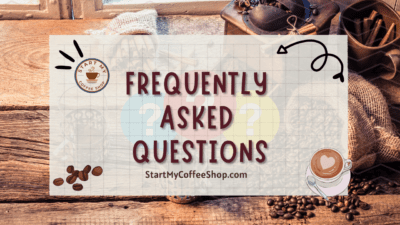
Questions: How can I identify my target market for a coffee shop?
Answer: Analyze demographics such as age, gender, income level, and location. Think on psychographic elements like values, interests, and way of life. Research local coffee consumption habits and preferences
Question: What are some effective marketing strategies for a coffee shop?
Answer: Effective marketing strategies for a coffee shop include social media engagement, creating an enticing online presence, hosting events or workshops, partnering with local businesses or influencers, offering loyalty programs, providing personalized customer experiences, and leveraging community involvement through sponsorships or charity initiatives.
Question: What are some common challenges in the coffee shop industry?
Answer: It include intense competition, changing consumer preferences, rising ingredient costs, staffing and training issues, maintaining consistent quality, managing inventory effectively, coping with seasonality, keeping up with industry trends and innovation, and adapting to evolving regulations and health standards.
To learn more on how to start your own coffee shop, check out my startup documents here.
Disclaimer: The information provided by StartMyCoffeeShop.com (“The Site”) is for general informational purposes only. All information on the Site is provided in good faith. However, we make no representation or warranty of any kind, express or implied, regarding the accuracy, adequacy, validity, reliability, availability, or completeness of any information on the Site. Under no circumstance shall we have any liability to you for any loss or damage of any kind incurred as a result of the use of the Site or Reliance on any information provided on the Site. Your use of the Site and reliance on any information on the Site is solely at your own risk. This blog post is for educational purposes only and does not constitute legal advice. Please consult a legal expert to address your specific needs. Terms and Conditions. ( https://startmycoffeeshop.com/terms-and-conditions/ )

Hi! I’m Shawn Chun
My adventure in coffee began when I first launched my first coffee shop back in the early 2000s. I had to figure out so many things on my own and to make it worse within 2 years of opening two large corporate coffee chains moved in just blocks away from me!
As I saw smaller and even some larger coffee shops in the neighborhood slowly lose customers to these giant coffee chains and slowly close up shop, I knew that I had to start getting creative…or go out of business.
I (like you may be) knew the coffee industry well. I could make the best latte art around and the foam on my caps was the fluffiest you have ever seen. I even had the best state-of-the-art 2 group digital Nuova Simonelli machine money could buy. But I knew that these things alone would not be enough to lure customers away from the name brand established coffee shops.
Eventually, through lots of trial and error as well as perseverance and creativity I did find a way to not only survive but also thrive in the coffee/espresso industry even while those corporate coffee chains stayed put. During those years I learned to adapt and always faced new challenges. It was not always easy, however, in the end, I was the sole survivor independent coffee shop within a 10-mile radius of my location. Just two corporate coffee chains and I were left after that year. All told the corporate coffee chains took down over 15 small independent coffee shops and kiosks and I was the last one standing and thriving.
Along the years I meet others with the same passion for coffee and I quickly learned that it is not only “how good a barista is” that makes a coffee shop successful, but the business side of coffee as well.
Hence why I started this website you are on now. To provide the tools and resources for up and coming coffee shop owners to gain that vital insight and knowledge on how to start a coffee shop successfully.
Stick around, browse through my helpful blog and resources and enjoy your stay! With lots of LATTE LOVE!
Share This Story, Choose Your Platform!
Related posts.

Infusing Style and Substance: A Blueprint for Coffee Shop Design

Infusing Comfort and Charm: Small Coffee Shop Design Concepts

Personal Touches: Decorating Your Cozy Coffee Bar

Perk Up Your Business: Starting a Coffee Stand the Right Way

Stand Out on the Street: Small Coffee Shop Exterior Ideas

Café eröffnen: Eiscafé, Coffeeshop oder Kaffee-Bike? Es gibt viel zu beachten!
Sie träumen schon lange davon, Ihr eigenes Café zu eröffnen? Sie haben ein Faible für Kaffee und Kuchen, sind kommunikativ und serviceorientiert und wollen den Schritt in die Selbstständigkeit nun endlich wagen? Wir zeigen Ihnen, worauf es dabei ankommt. Denn neben zu beachtenden Vorschriften und nötigen Behördengängen brauchen Sie vor allem ein überzeugendes Geschäftskonzept und einen tragfähigen Businessplan, wenn Sie Ihr Café eröffnen und erfolgreich führen wollen.
Lesen Sie, welche Voraussetzungen Sie erfüllen müssen, wenn Sie ein Café eröffnen wollen. Schritt für Schritt leiten wir Sie von Ihrer Geschäftsidee zum individuellen Konzept und unterstützen Sie mit praktischen Online-Tools bei der Erstellung von Business- und Finanzplan. Alle wichtigen Punkte der Existenzgründung behalten Sie mit unserer kostenfreien Checkliste im Blick.

Von René Klein Chefredakteur
René Klein verantwortet als Chefredakteur seit über 10 Jahren die Inhalte auf dem Portal und aller Publikationen von Für-Gründer.de. Er ist regelmäßig Gesprächspartner in anderen Medien und verfasst zahlreiche externe Fachbeiträge zu Gründungsthemen. Vor seiner Zeit als Chefredakteur und Mitgründer von Für-Gründer.de hat er börsennotierte Unternehmen im Bereich Finanzmarktkommunikation beraten.
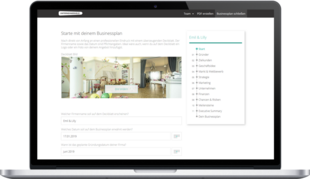
Einfach den Businessplan schreiben - Gliederung, Leitfragen und Beispiel inklusive.
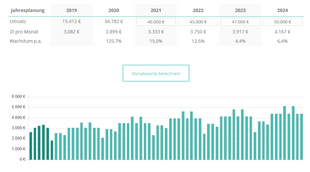
Der Finanzplan zeigt den Kapitalbedarf für die Bäckerei-Gründung auf.
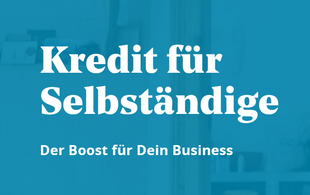
- Trotz Schufa-Eintrag möglich
- Einfacher Antrag ohne Businessplan
- Auszahlung innerhalb von 24h
Die Checkliste hilft Ihnen dabei, alle wichtigen Punkte auf dem Weg zur Gründung zu beachten.
| Kaffeevielfalt und Qualität: das eigene Café liegt im Trend
Backsendungen im Fernsehen zeigen, dass „Kuchen backen“ wieder voll im Trend ist. Dabei müssen es nicht unbedingt aufwändig gestalteten Motivtorten sein – auch der gute alte Pflaumenkuchen oder die Käse-Sahne-Torte nach Großmutters Rezept trifft noch immer die Geschmacksnerven zahlreicher Café-Gäste. Von der Vielzahl verschiedener Kaffeevariationen und -alternativen ganz zu schweigen! Laut dem Tchibo Kaffeereport 2018 trinken die Deutschen im Schnitt täglich 3,4 Tassen Kaffee. Mit 3,7 Tassen pro Tag sind die Altersgruppen der Generation X (40 bis 54 Jahre) und die Best Ager (55 bis 75 Jahre) die Spitzenreiter unter den Kaffeetrinkern. Der tägliche Genuss von Kaffee und Kuchen scheint besonders im Osten Deutschlands beliebt: In Thüringen kommen Kaffee und Kuchen bei 21 Prozent der Kaffeetrinker jeden Nachmittag auf den Tisch, in Nordrhein-Westfalen immerhin noch bei 7,7 Prozent. Potenzial ist also auch für Ihr Café da.
Ganz entscheidend ist es aber, ein konkurrenzfähiges Geschäftskonzept auszuarbeiten, bevor Sie Ihr Café eröffnen. Finden Sie Ihre Nische – z. B. mit einem trendigen Cup-Cake-Café, einer stylischen Kaffee-Lounge oder einem mobilen Coffee-Bike – und arbeiten Sie einen tragfähigen Businessplan aus, damit Ihr Traum vom eigenen Café nicht an der Finanzierung scheitert.
Der Traum von der Selbstständigkeit im eigenen Café
Eine besondere Berufsausbildung, z. B. als Barista oder Konditor, brauchen Sie für die Eröffnung eines Cafés nicht. Dennoch sollten Sie nicht blauäugig in die Selbstständigkeit starten. Fehleinschätzungen sowie mangelndes fachliches und kaufmännisches Wissen führen nicht selten zur Insolvenz. Eignen Sie sich fehlendes Wissen frühzeitig durch Fachliteratur und den Besuch von Existenzgründungsseminaren an. Entsprechende Kurse bieten u.a. die Industrie- und Handelskammern (IHK) sowie – speziell für das Gaststättengewerbe – der Deutsche Hotel- und Gaststättenverband (DEHOGA) an. Zudem müssen Sie sich mit den relevanten Vorschriften der Gastronomie, allen voran der Lebensmittelhygiene, auseinandersetzen.
| Eigenes Café mit eigenem Konzept oder Franchise?
Sie haben für Ihr Café kein individuelles Konzept, das Sie selbst so richtig überzeugt? Vielleicht ist dann Franchise die passende Alternative für Sie. Eiscafés, Coffee-Bikes, Waffel-Bikes und andere gastronomische Konzepte können Sie mit Franchisesystemen eröffnen. Als Franchisenehmer setzen Sie auf ein erprobtes und bereits am Markt etabliertes Geschäftsmodell. Die Vorteile der Franchisegründung sind klar: Gegen eine Gebühr können Sie als Franchisenehmer auf bewährte Strategien, Know-how und die Marketingkonzepte des Franchisegebers zurückgreifen. So können Sie zügig Ihr Café eröffnen und müssen sich nicht um den Aufbau von Markenbekanntheit und Image kümmern.
Nutzen Sie unsere kostenfreie Franchisebörse! Bestimmt ist hier schon ein passendes Geschäftskonzept für Sie dabei.
| Sind Sie ein Unternehmertyp? Identifizieren Sie Ihre Stärken und Schwächen!
Welche Voraussetzungen bringen Sie für eine erfolgreiche Existenzgründung im Gastronomie-Bereich mit? Bevor Sie mit den Planungen Ihrer Café-Eröffnung starten, analysieren Sie Ihre eigenen Stärken und Schwächen: Finden Sie heraus, wo Ihre Potenziale und wo Risiken liegen! So können Sie schon vor der Eröffnung Ihres Cafés gezielt Schwerpunkte setzen, erfolgskritische Aspekte im Auge behalten und ggf. passende Unterstützung durch Partner, Mitarbeiter oder Berater an Bord holen.
Mit unserem kostenfreien Gründer-Test analysieren Sie anhand von 30 Fragen Ihre Stärken und Schwächen und erkennen Chancen und Risiken. Nachfolgend zeigen wir Ihnen zentrale Aspekte aus dem Gründer-Test, die Sie berücksichtigen sollten, bevor Sie Ihr Café eröffnen:
Persönlichkeit: Als künftiger Gastronom sollten Sie kommunikativ, verantwortungsbewusst, kontaktfreudig, serviceorientiert und freundlich sein. Zudem helfen Ihnen Persönlichkeitsmerkmale wie Leistungsbereitschaft, Belastbarkeit, Selbstvertrauen, die Fähigkeit zur Selbstmotivation, eine gewisse Risikotoleranz und der souveräne Umgang mit Stress und Rückschlägen, Ihr Café erfolgreich zu führen.
Motivation: Horchen Sie einmal tief in sich hinein und machen Sie sich bewusst, warum Sie sich selbstständig machen und ein Café eröffnen wollen:
- Träumen Sie schon lange von Ihrem eigenen Café oder ist es nur eine spontane Idee?
- Wollen Sie sich mit Ihrem eigenen Café selbst verwirklichen?
- Sind Sie auf der Suche nach einer beruflichen Veränderung oder ist die Existenzgründung in der Gastronomie ein Ausweg aus der Arbeitslosigkeit?
- Wünschen Sie sich ein höheres Einkommen oder wollen Sie sich mit dem eigenen Café nebenberuflich ein zweites Standbein aufbauen?
- Hoffen Sie, Familie und Beruf als Unternehmer besser unter einen Hut zu bekommen?
Machen Sie sich auch deutlich, dass die Selbstständigkeit finanzielle, persönliche und zeitliche Einschränkungen mit sich bringt:
- Haben Sie genügend finanzielle Rücklagen, um Ihr Café zu eröffnen und ggf. auch längere Zeit mit geringen Einnahmen zu überstehen?
- Sind Sie motiviert, überdurchschnittlich viel Zeit und Arbeit in Ihr Café zu investieren?
- Geben Ihnen Partner und/oder Familie Rückhalt?
Qualifikation: Eine bestimmte berufliche Qualifikation – beispielsweise eine Ausbildung als Konditor oder Barista – brauchen Sie nicht, wenn Sie ein Café eröffnen wollen. Ganz ohne Erfahrungen in der Gastronomie, kaufmännische und betriebswirtschaftliche Kenntnisse sollten Sie aber nicht in die Selbstständigkeit starten. Lesen Sie Fachliteratur, besuchen Sie Kurse und Existenzgründerseminare! Und ergänzen Sie fehlende eigene Kompetenzen mit qualifiziertem Personal und/oder erfahrenen Partnern, mit denen Sie gemeinsam Ihr Café eröffnen.
| Welche Vorschriften sind bei der Cafégründung zu beachten?
Vorschriften und Genehmigungen sind ein weites Feld in der Gastronomie. Haben Sie sich schon mit der Gaststättenerlaubnis und den Hygienevorschriften befasst? Um diese Themen kommen Sie nicht herum, wenn Sie ein Café eröffnen wollen:
Gaststättenkonzession: Kaffee mit Amaretto? Heißer Kakao mit Rum oder ein Schlückchen Cognac im Latte Macchiato? Schenken Sie Alkohol aus, brauchen Sie gemäß Gaststättengesetz (§2 GaststättenG) in den meisten Bundesländern für Ihr Café eine Gaststättenkonzession. Um diese zu erhalten, müssen Sie beim Ordnungsamt Ihre persönliche Zuverlässigkeit und Ihre fachliche Eignung nachweisen. Dazu brauchen Sie ein polizeiliches Führungszeugnis, einen Auszug aus dem Gewerbezentralregister, eine Unbedenklichkeitsbescheinigung des Finanzamts und eine Bescheinigung über die Erstbelehrung durch das Gesundheitsamt (§ 43 Abs. 1 Nr. 1 Infektionsschutzgesetz).
Zudem müssen Sie an einer Gaststättenunterrichtung der Industrie- und Handelskammer (IHK) teilnehmen, sofern Sie nicht durch Ihre Ausbildung (z. B. als Koch) bereits mit lebensmittelrechtlichen Vorschriften vertraut sind. Für die Gaststättenerlaubnis brauchen Sie außerdem den Miet-, Pacht- oder Kaufvertrag der künftig als Café genutzten Räumlichkeiten. Diese müssen den landesrechtlichen Vorschriften für das Hotel- und Gaststättengewerbe entsprechen.
Toilettenpflicht: Sobald Sie alkoholische Getränke ausschenken, müssen Sie Ihren Gästen auch Toiletten anbieten. Ansonsten ist die Toilettenpflicht in den jeweiligen Bundesländern unterschiedlich geregelt. Sind Sie von der Toilettenpflicht befreit, müssen Sie Ihre Kunden am Eingang des Cafés darauf aufmerksam machen, dass Sie keine Kundentoiletten haben. Gibt es aber Toiletten, müssen diese für Männer und Frauen getrennt sein und über Vorräume mit Waschbecken verfügen.
Unser Tipp: Auch wenn Sie nicht dazu verpflichtet sind, sollten Sie in Ihrer Wunsch-Immobilie Platz für Kundentoiletten – möglichst sogar barrierefreie – einplanen. Schließlich möchten Sie ja allen Gästen den Aufenthalt in Ihrem Café so angenehm wie möglich machen. Prüfen Sie vor dem Abschluss des Kauf-, Miet- oder Pachtvertrags nicht nur die räumlichen Gegebenheiten, sondern auch die Bau- und Brandschutzvorschriften.
Außengastronomie: Wollen Sie Ihre Gäste auch draußen bewirten? Dann brauchen Sie eine erweiterte Gaststättenerlaubnis und eine Sondernutzungserlaubnis für die Außengastronomie Ihres Cafés. Je nachdem wie viele Sitzplätze Sie in der Außengastronomie anbieten, benötigen Sie zusätzlich eine Genehmigung des Bauaufsichtsamts .
Hygiene: Als Gastronom sind Sie zur Eigenkontrolle der Lebensmittelhygiene verpflichtet. Darunter fallen Maßnahmen zur Küchenhygiene und Schädlingskontrollen ebenso wie die Personalhygiene – vom regelmäßigen Händewaschen bis zur Meldung von Durchfallerkrankungen. Zudem müssen Sie Ihr Personal zu den Hygienevorschriften schulen. Entsprechende Lebensmittelhygiene-Schulungen können in der Regel beim Gesundheitsamt absolviert werden.
Nicht vergessen: Denken Sie auch daran, dass sowohl Sie als auch Ihre Mitarbeiter Gesundheitszeugnisse brauchen. Diese erhalten Sie beim Gesundheitsamt .
| Entwickeln Sie ein erfolgreiches Geschäftsmodell für Ihr Café!
Ein individuelles Geschäftskonzept, mit dem sich Ihr Café von der Konkurrenz abhebt, ist ein wichtiger Erfolgsfaktor. Befassen Sie sich daher sorgfältig mit den folgenden Punkten, wenn Sie Ihr Geschäftsmodell prüfen :
Welche Qualifikationen, Kenntnisse und Kompetenzen bringen Sie als Gründer mit? Haben Sie Erfahrung in der Gastronomie? Wo liegen Ihre persönlichen Stärken und Schwächen?
#2 Geschäftsidee
Gemütliches Straßencafé, trendige Kaffee-Lounge, Coffee-Shop, Confiserie, Teehaus, Internet-Café, klassisches Eiscafé oder das Stehkaffee für den schnellen Kaffee zwischendurch? Oder vielleicht lieber mobile Varianten wie Coffee-Bike oder Pop-Cake-Truck? – Seien Sie kreativ, wenn Sie sich mit einem eigenen Café selbstständig machen wollen. Entwerfen Sie ein einzigartiges Konzept für ein Café, das durch überzeugende Alleinstellungsmerkmale seine eigene Nische findet.
Das können Besonderheiten wie die samtpfotigen „Mitarbeiter“ eines Cats-Cafés oder die Spezialisierung auf bestimmte Produkte (z. B. Fairtrade-Kaffee, Kaffeealternativen auf Matchabasis oder Tee aus zertifiziertem Anbau) und Rezepte (z. B. „Omas Apfelstrudel“, „Belgische Waffeln in allen Variationen“ oder „Heikes vegane Kuchen“) sein. Auch das Ambiente Ihres Cafés kann zum entscheidenden Alleinstellungsmerkmal werden.
Stimmen Sie Stil, Einrichtung und den Namen Ihres Cafés auf Ihr Konzept ab! Überlegen Sie sich, welche Getränke Sie anbieten wollen und ob es ausschließlich Kuchen und Torten oder auch herzhafte Snacks und warme Speisen geben soll. Auch besondere Angebote wie Frühstücksbuffet, Kaffee-Flatrate, Bergische Kaffeetafel, Kaffeerösterei oder Barista-Workshops können wichtige Differenzierungsmerkmale Ihres Cafés sein.
#3 Zielgruppen
Wer sind Ihre Kunden? Wollen Sie junge Leute aus der nahe gelegenen Uni in Ihr Café locken oder lieber älteres, zahlungskräftiges Publikum anziehen? Analysieren Sie zentrale demografische Eigenschaften inklusive des Freizeitverhaltens Ihrer Zielgruppe! Was mag die Zielgruppe ? Welchen Kundennutzen hat das Angebotspaket Ihres Cafés?
#4 Markt & Wettbewerb
Suchen Sie die Cafés Ihrer lokalen Mitbewerber auf und testen Sie deren Angebot, bevor Sie Ihr eigenes Café eröffnen. Wie groß ist der Markt und wie viele Mitbewerber gibt es? Google Maps liefert Ihnen für die erste Wettbewerbsanalyse in Ihrem bevorzugten Gebiet sicherlich gute Ergebnisse. Neben der Anzahl sind auch die Konzepte der Wettbewerber wichtig.
Unser Tool zur Konkurrenzanalyse hilft Ihnen, die Konzepte Ihre Mitbewerber zu beurteilen und Stärken und Schwächen zu erfassen.
#5 Preis & Strategie
Die Preiskalkulation ist für viele Gründer ein schwieriges Thema. Um realistische Preise kalkulieren zu können , müssen Sie zunächst Ihre Ausgaben analysieren. Gründungs- und Anschaffungskosten (u.a. für Genehmigungen, Corporate Design und die Einrichtung Ihres Cafés) und laufende Kosten (wie Pacht und Gehälter) müssen Sie bei der Preisfindung berücksichtigen, damit Ihr Café kostendeckend arbeitet, Sie Ihre Angestellten bezahlen und sich selbst einen Unternehmerlohn auszahlen können, für den sich die Selbstständigkeit lohnt. Darüber hinaus sollten Sie die Preise Ihrer Mitbewerber und Branchenkennzahlen kennen und in Ihrer Preisstrategie berücksichtigen.
#6 Marketing & Vertrieb
Werbung, Kundenakquise und Kundenbindung sind weitere zentrale Erfolgsfaktoren für Ihr Café. Machen Sie sich bei der Geschäftsmodellentwicklung bereits Gedanken, welche Marketingkanäle Sie nutzen wollen und wie Sie aus einmaligen Kunden Stammgäste machen. Beginnen Sie mit der Werbung schon bevor Sie Ihr Café eröffnen – beispielsweise mit Eröffnungsangeboten oder Gutscheinen für einen Gratis-Kaffee.
#7 Einnahmen
Definieren Sie Ihre unterschiedlichen Einnahmequellen nach einzelnen Angeboten (alle Posten Ihrer Speisekarte). Schätzen Sie die Anzahl Ihrer potenziellen Kunden (z. B. anhand von Branchenkennzahlen), deren Besuchsfrequenz und die Summe, die sie im Durchschnitt in Ihrem Café ausgeben werden, realistisch ein. Vergessen Sie nicht ihren Gewinn und die Mehrwertsteuer im Endpreis zu berücksichtigen! Wir bieten Ihnen ein spezielles Tools für die Preiskalkulation in der Gastronomie .
#8 Laufende Betriebskosten - operative Kosten
Bedenken Sie in der Konzeption, welche laufenden Kosten ein Café verursacht. Dabei sind die wichtigsten Kostenarten:
- Wareneinsatz: Einkauf von Lebensmitteln, Kaffee, Tee, Softdrinks, Zutaten und Getränken
- Miete und Pacht, was von Größe und Standort Ihres Cafés abhängt.
- Personalkosten: Löhne und Gehälter für Mitarbeiter in Küche, Theke und Service
Diese Kosten müssen durch die Preise Ihrer Speisen und Getränke gedeckt werden.
#9 Ressourcen
Wie viel Kapital brauchen Sie für die Eröffnung Ihres Cafés? Wie viel Eigenkapital haben Sie? Denken Sie aber auch an weitere Ressourcen wie Lieferanten und vor allem Personal, denn was wäre ihr Café ohne Ihre Mitarbeiter? Sie sorgen dafür, dass sich Ihre Gäste wohlfühlen. Schenken Sie der Personalauswahl daher große Aufmerksamkeit.
Die optimale Kasse optimiert die Abläufe in Ihrem Café. Informieren Sie sich über Kassensysteme für Gastronomen.
Gründertest und Geschäftsmodell ganz einfach online
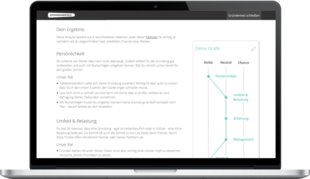
Wer noch ganz am Anfang der Existenzgründung steht, sollte zunächst die eigenen Stärken und Schwächen kennen. Dabei hilft die der Gründer-Test.
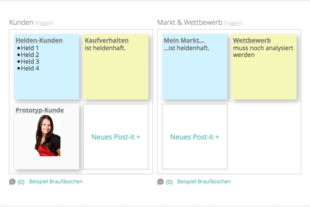
Ist meine Idee auch wirklich gut und habe ich an alles gedacht? Prüfen Sie Ihr Geschäftsmodell anhand der kritischen Faktoren ganz einfach online.
| Business- und Finanzplan: Die Detailplanung für Ihr Café
Im Businessplan arbeiten Sie Ihr Geschäftsmodell nun als nächstes detailliert aus. Hier konkretisieren Sie Ihre Idee und unterziehen sie einer ersten kritischen Prüfung. Dazu gehört auch das Zahlenwerk, das Sie im Finanzplan festhalten . Nehmen Sie sich hierzu ausreichend Zeit, denn Business- und Finanzplan sind die entscheidenden Planungsinstrumente, die Sie brauchen, um Banken und Investoren von Ihrem Konzept zu überzeugen. Ohne Business- und Finanzplan werden Sie keinen Kredit erhalten. Ihnen selbst helfen die Dokumente, Finanzen und weitere erfolgskritische Faktoren wie Werbung und Personal Ihres Cafés im Auge zu behalten.
Mit unserer kostenfreien Businessplansoftware geht das ganz einfach! Diese führt Sie Schritt für Schritt durch alle Kapitel und unterstützt Sie mit Leitfragen zum Inhalt: Businessplansoftware jetzt nutzen !
Schauen wir uns nun einige der zentralen Inhalte des Businessplans an! Hier können Sie bereits viele Punkte aus dem zuvor entwickelten Geschäftskonzept übernehmen und konkretisieren.
#1 Rechtsform
Einzelunternehmen, GbR oder GmbH – in welcher Rechtsform wollen Sie Ihr Café gründen? Hier spielen Startkapital, Haftung und steuerliche Aspekte zentrale Rollen bei der Entscheidung. Verschaffen Sie sich einen Überblick und finden Sie passendes Gründungspaket für Ihr Café!
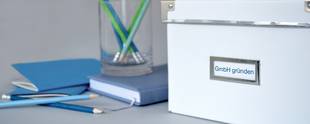
Egal ob als Einzelunternehmer, GbR, UG oder GmbH. Wenn Sie Ihr Café eröffnen wollen, bieten die Gründungspakte Unterstützung bei den formalen Fragen.

Sie sind noch unsicher bei der Wahl der passenden Rechtsform für Ihr Café? Dann nutzen Sie unseren kostenfreien Rechtsformtest.
#2 Standort: Eröffnen Sie Ihr Café dort, wo Ihre Kundschaft ist!
Für ein lokales Unternehmen wie Ihr Café ist die Auswahl des richtigen Standorts entscheidend. Wo halten sich Ihre Kunden auf? Ist die Lage gut frequentiert und ideal für Laufkundschaft? Gibt es (kostenfreie) Parkmöglichkeiten und ist der Standort gut mit öffentlichen Verkehrsmitteln zu erreichen? Prüfen Sie im Vorfeld auch, ob an Ihrem bevorzugten Standort die Möglichkeit besteht, Außengastronomie zu betreiben. Wenn Sie keine Möglichkeit haben, Tische und Stühle draußen vor Ihr Café zu stellen, werden Sie an warmen Tagen Einnahmeneinbußen einkalkulieren müssen. Wägen Sie Lage und Mietpreise gegeneinander ab und klären Sie baurechtliche Fragen zu Ihrer Wunschimmobilie, bevor Sie den Miet- oder Pachtvertrag unterschreiben oder die Immobilie vielleicht sogar kaufen. Haben Sie die passende Immobilie für Ihr Café gefunden, brauchen Sie vom Bauamt eine Genehmigung für etwaige Umbaumaßnahmen.
Den richtigen Standort für Ihr Café finden? Unser Tool zur Standortanalyse hilft Ihnen dabei.
#3 Personalgewinnung: Holen Sie zuverlässiges Personal in Ihr Café!
Freundliche, sympathische, zuverlässige und serviceorientierte Mitarbeiter, denen Sie vertrauen können, sind das A und O Ihres Cafés. Kommen Sie und Ihre Gäste gut mit der Bedienung aus, sind nachweisliche Erfahrungen in der Gastronomie zweitrangig. Aushänge in Universitäten und Geschäften können Ihnen dann helfen, kurzfristig Aushilfen zu finden. Sind Sie jedoch selbst noch unerfahren, wenn Sie Ihr Café eröffnen, ist erfahrenes, qualifiziertes Personal für Sie als Unternehmer eine wichtige Stütze. Nutzen Sie für das Personal-Recruiting Anzeigen in den örtlichen Printmedien, sozialen Netzen und Job-Portalen! Ganz gezielt finden Sie Fachkräfte aus dem Gastgewerbe auf Online-Portalen wie hogastjob.com oder kellnerkartei.de.
#4 Finanzplan: Behalten Sie den Überblick über Ihren Kapitalbedarf!
Gründungs-, Start- und Anschaffungskosten verschlingen einen Großteil Ihres Kapitals noch bevor Sie überhaupt Ihr Café eröffnet und erste Einnahmen verbucht haben. Je nach Einrichtung und Konzept kommt hier schon einiges zusammen. Welche Kosten Sie einmalig vor der Café-Eröffnung einkalkulieren müssen und welche im späteren Betrieb Ihres Cafés regelmäßig anfallen, haben wir in der folgenden Tabelle für Sie zusammengefasst.
#5 Finanzierung sichern
Dank des Finanzierungsplans sehen Sie nun genau, wie viel Geld Sie brauchen, um Ihr eigenes Café zu eröffnen, wie viel Sie davon als Eigenkapital einbringen und wie viel Sie fremdfinanzieren müssen. Für letzteres gilt es nun, passende Finanzierungsmöglichkeiten zu finden. Vor der Aufnahme von Krediten sollten Sie sich über mögliche Zuschüsse und Fördermittel informieren. Und für günstige Förderkredite ist bspw. die KfW eine gute Anlaufstelle.
Der Businessplan ist Ihr Plan fürs Business. Und mit unserer Lösung können Sie einfach und schnell loslegen - Gliederung, Leitfragen und Beispiel inklusive.
Bisher wurden Finanzpläne meist mühsam mit Excel erstellt. Der digitale Finanzplan führt Sie hingegen Schritt für Schritt durch alle Bereiche.
Unkomplizierte Finanzierung
#6 Werbung: Machen Sie Ihr neues Café bekannt!
Stellen Sie schon vor der Eröffnung Ihres Cafés die Weichen auf Erfolg, indem Sie mit Eröffnungsangeboten auf die das gastronomische Angebot hinweisen. Verteilen Sie Flyer, schalten Sie Anzeigen und senden Sie Pressemitteilungen an die lokalen Redaktionen! Vielleicht sind auch Rabattaktionen auf groupon.de oder gutscheinbuch.de interessant, um Ihre neue Location bekannt zu machen. Nutzen Sie die sozialen Netzwerke, Ihre eigene Website und Bewertungsportale wie Ihre Google My Business Seite zum Aufbau von Image und Bekanntheit! Und sorgen Sie durch Ihr Angebot und besten Service für gute Mundpropaganda und Empfehlungen!
| Die Gründung Ihres Cafés – praktisch und formal
Konzept, Business- und Finanzplan sind in trockenen Tüchern? Prima, dann kommen Sie so langsam auf die Zielgerade Ihrer Existenzgründung. Doch bevor Sie wirklich Ihr Café eröffnen können, stehen noch einige Behördengänge und viel Papierkram auf der To-Do-Liste. Planen Sie dafür ausreichend Zeit ein, denn allein die Erteilung der Gaststättenkonzession kann mitunter lange dauern. Neben all den nötigen bürokratischen Schritten müssen Sie sich auch noch um wichtige Versicherungen kümmern und ein Geschäftskonto eröffnen. Damit Sie nichts vergessen, haben wir alle wichtigen Schritte und Behördengänge in einer übersichtlichen Checkliste für Sie zusammengefasst.
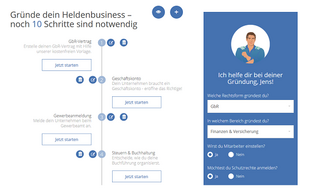
Welche Gründungsschritte sind konkret nötig? Welche Ämter spielen eine Rolle? Wo muss ich mich anmelden? Der Gründungsassistent hilft weiter.
Sie wollen ein Café eröffnen? Unsere Checkliste führt Sie durch die praktischen Gründungsschritte. Sie können diese einfach herunterladen.
| Fazit – Café eröffnen: Erfolgreich in die Selbstständigkeit
Der Weg in die Selbstständigkeit ist immer mit einigen Hürden und Stolpersteinen versehen. Wollen Sie ein Café eröffnen, müssen Sie zahlreiche Vorschriften – beispielsweise zur Lebensmittelhygiene – beachten und wissen, ob und wann Sie eine Gaststättenerlaubnis brauchen und Kundentoiletten zur Verfügung stellen müssen. Sich im Paragrafen-Dschungel zurechtzufinden, ist jedoch nur die halbe Miete.
Wer ein Café eröffnen will, braucht vor allem ein überzeugendes Geschäftskonzept : Konkretisieren Sie Ihre Geschäftsidee in einem einzigartigen Konzept, das Ihr Café von denen der Konkurrenz abhebt, analysieren Sie Markt und Mitbewerber und suchen Sie einen Standort, an dem Sie Ihre Zielgruppe bestmöglich erreichen. Und: Schätzen Sie Einnahmen und Ausgaben realistisch ein, um sich mit konkurrenzfähigen Preisen langfristig gewinnbringend in der örtlichen Gastroszene etablieren zu können. So vorbereitet können Sie einen tragfähigen Businessplan und einen schlüssigen Finanzplan entwerfen, der Ihnen hilft, selbst den Überblick über Ihre Finanzen zu bewahren und mögliche Kreditgeber von Ihrem Geschäftskonzept zu überzeugen.
Unsere kostenlose Checkliste gibt Ihnen einen detaillierten Überblick über alle notwendigen formalen Gründungsschritte. Arbeiten Sie diese Schritt für Schritt ab. Stehen Konzept und Finanzierung, sind alle Formalitäten erledigt? Dann steht der Eröffnung Ihres Cafés und der erfolgreichen Existenzgründung nichts mehr im Wege.
frage[at]fuer-gruender.de
- QR Code Menu
Table of Contents
Dreaming of opening a coffee shop? You’re not alone. The coffee industry is bustling with passionate business owners eager to make their mark. However, becoming successful coffee shop owners requires more than just a love for the brew. It demands a clear vision that differentiates your coffee house in a saturated market. A well-crafted business plan not only gives life to your idea but also sets your business on a path to thrive. Whether you’re a newbie or a seasoned entrepreneur, this guide, complete with a free template, will help you craft a business plan that markets and propels your coffee venture to success.
What is A Coffee Shop Business Plan?
A coffee shop business plan is a comprehensive document that explains what your business idea is, how you intend to penetrate the coffee market, and the strategies you’ll employ to run your coffee shop successfully. When opening a cafe, many aspiring cafe or coffee shop owners underestimate the value of a structured plan. However, this document does more than just outline the needs to open a coffee shop; it gives a detailed roadmap for your new business, offering clarity on every aspect of its operation.
More than that, presenting a well-structured business plan to potential investors is essential. It not only showcases your commitment but also your understanding of the industry, making it a vital tool for securing funding. While crafting a business plan can seem daunting initially, it’s the foundation that both clarifies your idea and sets your business on the trajectory for growth and success in the competitive world of cafes and coffee shops.
Why A Business Plan Is Important For A Successful Coffee Shop Business?
1. Clear Vision and Objectives
When you set up your coffee shop, having a business plan establishes a clear vision and defines your objectives. It is the backbone that steers every decision you’ll make. Without a clear outline, you may find yourself swaying from one idea to the next. With a detailed business plan, you can present a clear business proposal to stakeholders, ensuring them and yourself of the path you plan to tread.
2. Financial Planning
A comprehensive business plan is imperative for accurate financial planning. It will include information on how much capital is required to start, what your ongoing costs will be, and the revenues you plan to generate. If you’re seeking external funding, investors will want to see how you plan to use their money, and most importantly, how you plan to make a return on that investment. If you plan to sell specialty blends or unique treats, the financial section can also help you plan a strategy for pricing, promotion, and sales forecasts.
3. Operational Efficiency
Operational efficiency is the linchpin that holds all business operations together. A business plan will map out every detail, from supplier agreements to employee schedules. You may want to create special events or loyalty programs for regular customers, and this is where a business plan can help you plan a strategy for success. It becomes the reference point, ensuring that daily tasks align with the broader objectives, guaranteeing that resources, time, and efforts are used optimally.
Step-by-step Guide To Write A Coffee Shop Business Plan
1. Executive Summary
The Executive Summary is like the introduction of a novel – it provides a snapshot of what is to come. Typically, you write the executive summary last, even though it appears first in your business plan. It encapsulates the essence of your coffee shop’s mission, objectives, and financial overview, succinctly explaining what your business concept is about. This section is crucial because many coffee shops fail to engage potential investors right off the bat. Ideally, it should be concise – a page or two.
What should you cover in an Executive Summary?
- Introduce Your Coffee Shop or Cafe: Provide a company overview, giving readers insight into what makes your coffee shop unique from the myriad of coffee bars in the market.
- State Your Mission and Vision: Describe what drives your coffee business and where you see it in the future.
- Outline Your Objective: Define clear, measurable goals that you aim to achieve.
- Provide a Financial Overview: Highlight projected profit margins, a brief balance sheet, and other pertinent financial data.
2. Coffee Shop Business Description
This section paints a picture of your coffee shop. It’s where you elaborate on how you plan to infuse the local coffee market with your unique brews and pastries.
What should you cover in the Coffee Shop Description section?
- Coffee Shop Concept: Dive into the types of coffee drinks you plan to offer, whether it’s a rich espresso or a classic brewed coffee.
- Unique Selling Proposition: Discuss what makes your coffee shop stand out, be it a special blend of coffee beans, a unique roasting method using a specific coffee roaster, or artisanal pastry offerings.
- Operational Plan: Briefly touch upon how you’ll manage your coffee shop, from sourcing beans to serving cups of coffee.
3. Market Analysis
Before pouring your first espresso, performing market research before starting your coffee business is essential. This section dives deep into understanding your potential customer base and the coffee industry landscape in your area.
What should you cover in this section?
- Target Market: Describe your ideal customer. Are they local residents, office workers, or students?
- Location: Discuss the significance of your chosen location. Are there many coffee shops in the area? How does your location cater to your target market?
- Competition: Analyze existing coffee shops. What coffee and food products do they offer? What pricing strategy do they employ? How will your coffee shop compete or complement them?
4. Organization and Management
Behind every successful coffee shop is a robust organizational structure and a competent management team.
What should you cover in the Organization and Management Plan?
- Coffee Shop Ownership Information: Highlight the business’s legal structure.
- Profiles of Your Coffee Shop Management Team: Include details about your baristas, perhaps a part-time accountant, and someone to manage marketing. It can be helpful to create profiles for each role, detailing responsibilities and expertise.
5. Sample Menu
Your menu is the heart of your coffee shop. It’s more than just a list of coffee and tea; it’s an expression of your brand.
What should you consider when creating a Sample Menu?
- Menu Items: Detail the types of coffee, espresso drinks, and pastries you plan to offer. Maybe consider including non-coffee items like teas or specialty drinks.
- Unique Selling Proposition: Reiterate what makes your coffee or food items different from other coffee shops in the area.
- Menu Pricing : Discuss your pricing strategy, keeping in mind profit margin, competitors’ prices, and your target customer base.
6. Marketing Plan
To brew success, it’s not enough to have a fantastic coffee product; you must effectively market it.
What should you cover in a Marketing Strategy for your Coffee Shop Business?
- Define Your Brand: What voice, theme, or emotion do you want your coffee shop to evoke?
- Lay out your plans for social media campaigns, local partnerships, loyalty programs, SEO for website, and other promotional strategies.
- Considering using an online food ordering system in your food truck
- Create a digital menu with QR code to make your menu easy for your customers to access online
7. Operations Plan
Efficiency is key to the daily grind of running a cafe. The operations section provides a detailed look at the day-to-day operations of your coffee shop business.
What Operational Issues should you address in your Business Plan?
- Supply Chain: Where will you buy your coffee beans? Who will be your coffee roaster?
- Operating Hours: Consider the best times to cater to your target market.
- Staffing: Detail roles, such as barista, manager, and part-time support.
- Equipment: List down essential equipment, from espresso machines to ovens.
8. Financial Plan
In this crucial section of your business plan, delving into the financial specifics is paramount to lay out a concrete roadmap for the fiscal aspects of your coffee shop.
How Much Does It Cost to Start a Coffee Shop?
Starting a coffee shop is not just about brewing the perfect espresso; it’s also a substantial financial commitment. The cost for opening a coffee shop can range from $80,000 to $250,000. These costs can vary widely based on factors such as location, size of the establishment, equipment quality, and inventory requirements. Moreover, the process of opening a coffee shop might also involve unexpected expenditures, so it’s essential to account for some buffer in your budget.
How Many Ways to Fund Your Coffee Shop?
There are multiple avenues for funding your coffee venture. Traditional bank loans, personal savings, angel investors, crowdfunding campaigns, and partnerships are just a few options. It’s crucial to assess which option aligns best with your business vision and financial situation.
Important Questions to Consider When You Create Your Funding Request If you’re seeking funding, there are several questions you’ll need to answer in your business plan:
- How much money do you need to start and maintain your coffee shop until it becomes profitable?
- What will the funds be used for specifically?
- How do you plan to handle financial challenges that might arise?
- How do you plan to repay any loans or provide a return on investment?
9. Financial Projections
The financial projections section of your business plan forces you to translate your coffee shop vision into numbers, ensuring you’ve accounted for all key metrics that can make or break your venture.
Break-even analysis:
This is the point where your coffee shop’s total revenues equal its total costs. Simply put, it’s when you neither make a profit nor a loss from selling coffee.
Use this formula: Fixed Costs / (Price – Variable Costs) = Break Even Point
Projected profit and loss statement:
This will provide a forecast of your expected income and expenses, giving a clear view of your venture’s profitability.
Cash flow analysis:
Essential for understanding the liquidity of your business, this tool is especially crucial for coffee shops, considering the fluctuating expenses and incomes coffee shops offer. When drafting this, consider who will read it, as stakeholders like investors or lenders might have specific expectations.
Coffee Shop Business Plan Template
- Mission: To offer the community high-quality coffee in a comfortable and vibrant environment.
- Vision: To become the go-to local coffee spot that fosters community connections and coffee appreciation.
- Coffee Shop Description: “Java Junction” will be a modern coffee hub that emphasizes direct-trade coffee beans and a relaxed, inclusive atmosphere.
- Costs: Estimated initial costs are $125,000.
- Profits: Projected annual profit by year two is $75,000.
2. Description of the Coffee Shop
- Coffee Shop Concept: A community-focused café emphasizing artisanal methods.
- Coffee Shop Name: Java Junction
- Coffee Shop Type: Sit-down café with an adjacent mini-library.
- Location: Main Street, Downtown Area – chosen for its high foot traffic.
- Order Fulfillment: Orders taken at the counter with table service for food.
- Working Hours: Mon-Fri (7 am – 9 pm), Sat-Sun (8 am – 10 pm).
3. Menu Offer
- Type of Food and Drink: Coffee, teas, pastries, and sandwiches.
- Offer: From classic espresso shots to unique blends like “Lavender Latte”.
- Unique Selling Point: Every coffee product uses direct-trade beans, ensuring farmer fairness.
4. Market and Competition Analysis
- Market Analysis: The local population includes a mix of professionals, students, and tourists. Many search for quiet spots to work or relax.
- Target Customer: Professionals aged 25-40 and students.
- Size of the Target Customer: Approximately 15,000 individuals.
- Competition Analysis: Three established coffee shops within a mile.
- Size of the Competition: Ranging from small boutique coffee shops to a larger chain.
- Competitors’ Offer: Basic coffee drinks, with limited specialty items.
- Competitors’ Prices: Average of $4 for a coffee drink.
5. Investment Plan (Detailed Cost Analysis)
Investment Cost (One-off): $75,000
- Equipment: $30,000
- Renovations: $20,000
- Initial Stock: $10,000
- Licenses: $5,000
- Miscellaneous: $10,000
Operating Costs (Monthly): $17,000
- Rent: $3,000
- Salaries: $10,000
- Utilities: $1,000
- Stock: $2,000
- Marketing: $1,000
6. Financial Forecast
Year one is projected to break even, with a profit of $50,000 expected in year two, and $75,000 in year three, considering growth and expanding customer base.
- Owner: Jamie Smith, a coffee enthusiast with a business degree.
- Manager: Alex Brown, previously managed a successful coffee chain for five years.
- Baristas: A team of 4 skilled individuals passionate about coffee.
8. Marketing Plan
Java Junction will use a mix of social media marketing, local print advertising, and loyalty programs to attract and retain customers. Regular events, such as “Buy Our Coffee Day” and collaboration with local businesses, will drive foot traffic and community engagement, integral components for starting your coffee shop and making it successful.
This coffee shop business plan sample is hypothetical and serves as a template. Tailoring specifics to your local market, vision, and unique aspects will be necessary. Every coffee shop has nuances that can make them successful, whether it be the coffee products they sell, the environment they cultivate, or the events they host. Focus on what will make your coffee shop stand out and be sure to engage your community.
Tips For Writing a Business Plan For a Coffee Shop
Your business plan becomes the blueprint of your vision. Here are essential tips to consider:
Comprehensiveness is Key: Ensure your plan encompasses all sections you should include, such as marketing, financial projections, and operations. A well-rounded plan provides a holistic view of your business.
Tailor to Your Audience: If you’re presenting to potential investors, focus on profitability and growth projections. For a landlord, emphasize the benefits your coffee shop will bring to their property.
Specialize in Marketing: Given the competitiveness in the coffee industry, it’s crucial to have a solid marketing plan. If marketing isn’t your strength, consider hiring someone to do marketing for your venture. A strong online presence, loyalty programs, and community engagement can set you apart.
Research Your Market: Understand what nearby coffee shops include in their offerings. Identify gaps in the market and strategize on how your shop can fill them.
Stay Flexible: While a business plan provides direction, remain adaptable. The coffee industry is dynamic, and your ability to pivot can prove invaluable.
Separate Sections for Clarity: If your plan becomes too dense, you might want to create a separate document for specific sections like a detailed marketing strategy or an in-depth market analysis. This makes your primary business plan concise and more readable.
Frequently Asked Questions
1. how profitable is owning a coffee shop.
Owning a coffee shop can be profitable, depending on factors like location, quality of products, and management. On average, after expenses, many coffee shops report a profit margin of around 3% to 5%, with some successful ones achieving even higher. However, it’s essential to factor in initial setup costs, ongoing expenses, and market competition.
2. How do I start a coffee shop business plan?
Starting a coffee shop business plan involves multiple steps. Begin by defining your coffee shop’s mission and vision. Conduct market research to understand your target audience and competitors. Then, detail out sections like your product offerings, pricing strategy, marketing plan, financial projections, and operational procedures. If you’re thinking of opening a coffee shop, a well-thought-out business plan is indispensable.
3. What is a business plan for a coffee shop?
A coffee shop business plan is a detailed document that outlines your coffee shop’s objectives, strategies, and operational procedures. It acts as a roadmap, guiding you from the startup phase to establishing a thriving business. Moreover, if you need a coffee shop business loan or investment, this plan becomes crucial in convincing stakeholders of your venture’s viability.
4. What are the 4Ps in a coffee shop business plan?
The 4Ps stand for Product, Price, Place, and Promotion. In the context of a coffee shop:
- Product: What type of coffee and related products will you offer?
- Price: How will you price your coffee? Will it be premium or competitive?
- Place: Where will your coffee shop be located? Is it accessible to your target audience?
- Promotion: How will you market your coffee shop? Will you offer promotions or loyalty programs?
These elements help in creating a marketing strategy tailored to your coffee shop’s unique needs and market position.
Launching a coffee shop is not just about brewing the perfect cup but weaving a narrative that resonates with your community, fostering an ambiance that people gravitate towards, and maintaining a seamless operation that drives profitability. The meticulous creation of a business plan is a pivotal step in this endeavor. It’s the beacon that guides budding entrepreneurs through the complexities of the coffee industry. In such a competitive marketplace, a well-structured, comprehensive business plan can make the difference between a fleeting venture and a thriving institution. To potential coffee shop owners, embrace the process, let your passion shine through in your plan, and remember that every great coffee shop started with a simple idea, much like a single coffee bean ready to brew greatness.

Related articles

QR Code on Table Tents for Restaurants and Bars

How much does it cost to open a small restaurant

How much does it cost to open a bakery
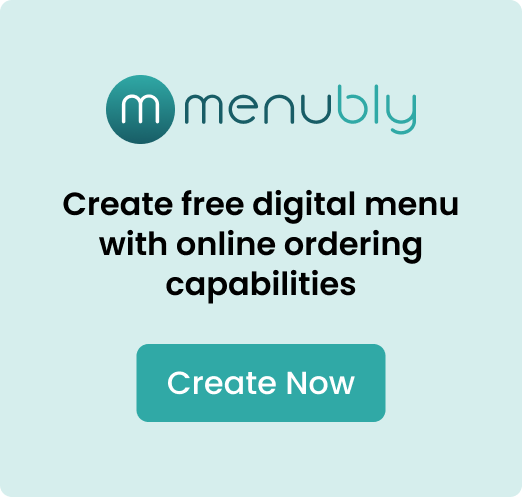
Menubly LLC 8 The Green Suite R, Dover, Delaware 19901
Privacy Policy
Terms of service
Cookie Policy

Researched by Consultants from Top-Tier Management Companies

Powerpoint Templates
Icon Bundle
Kpi Dashboard
Professional
Business Plans
Swot Analysis
Gantt Chart
Business Proposal
Marketing Plan
Project Management
Business Case
Business Model
Cyber Security
Business PPT
Digital Marketing
Digital Transformation
Human Resources
Product Management
Artificial Intelligence
Company Profile
Acknowledgement PPT
PPT Presentation
Reports Brochures
One Page Pitch
Interview PPT
All Categories
Starting a Restaurant, Cafe, or Coffee Shop? Here Are 18 Best Business Plan Templates for You
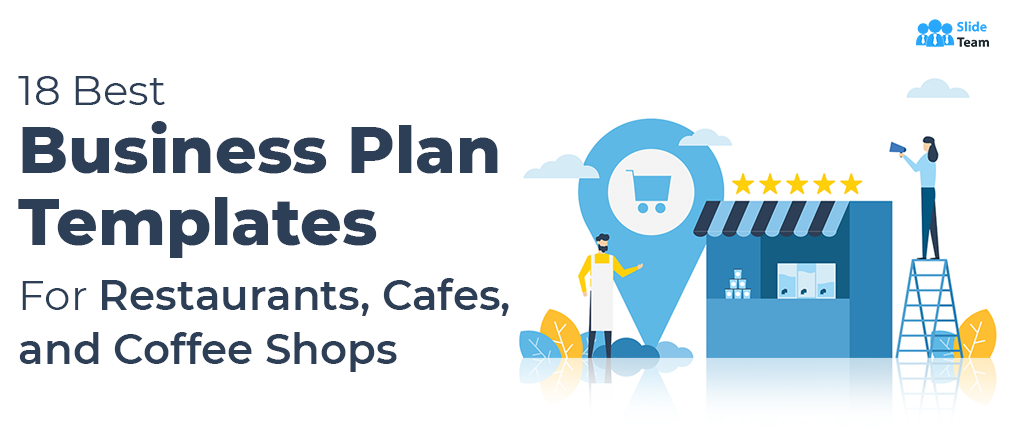
It isn’t every day you find out that SlideTeam’s marketing director actually bakes cakes worthy of a Masterchef episode. But when one fine day the topic sprang into our professional tete-a-tete, the rebound conversation was something we all might be too familiar with.
“Wow! These look scrumptious. You should totally open your own restaurant.”
“Nah! Food business is a lot of work. I’ll stick to marketing for now.”
And that is how culinary genius never really takes shape in the first place.
The prospect of starting a restaurant, cafe, or coffee shop is exciting and yet extremely challenging. The multi-billion-dollar F&B industry is united by food but divided by brutal competition. This leads to a peculiar bifurcation — one, our marketing director, sticking to making delectable penne alfredo on rainy Sunday evenings; and two, those fueled by their passion for food but losing valuable time in figuring out the mechanics of getting started.
But passion should be an enabler and not limited by semantics and specifics. If one begins on the right note and with a well-devised business plan, their restaurant or cafe venture can pick up momentum in no time. Therefore, in this blog, we shall explore SlideTeam’s top business plan templates that will help you realize your culinary passion and turn it into a successful venture. Read on.
Business plan templates to get your restaurant off the ground
Food entrepreneurs have an obvious challenge to face before they take their first step — how will they do it? Which customers and locations should they target? What will the menu look like? What will it include? How will people get to know about them? Who will manage operations? Are they going to be a dine-in or a takeaway service?
All these questions can certainly bog you down.
But the key to learning how to write a restaurant business plan lies in the answers to these questions only. A comprehensive business plan is instrumental to the success of your restaurant. It not only gives you direction and purpose but also serves as a handy document to present before potential investors to seek funding.
Once you have cleared your head and jotted the answers to pressing questions on a paper, it is time to get it all onto a presentation. The following restaurant business plan templates will save you a lot of hassle and time, and set the ball rolling quickly.
Give your restaurant a genius start with this comprehensive content-ready business plan PowerPoint template. The template has adequate space replete with catchy graphics and images to help you dispense quality information regarding the F&B industry and how your business model fits into it. The template is fully editable, so feel free to personalize it with your final touch.
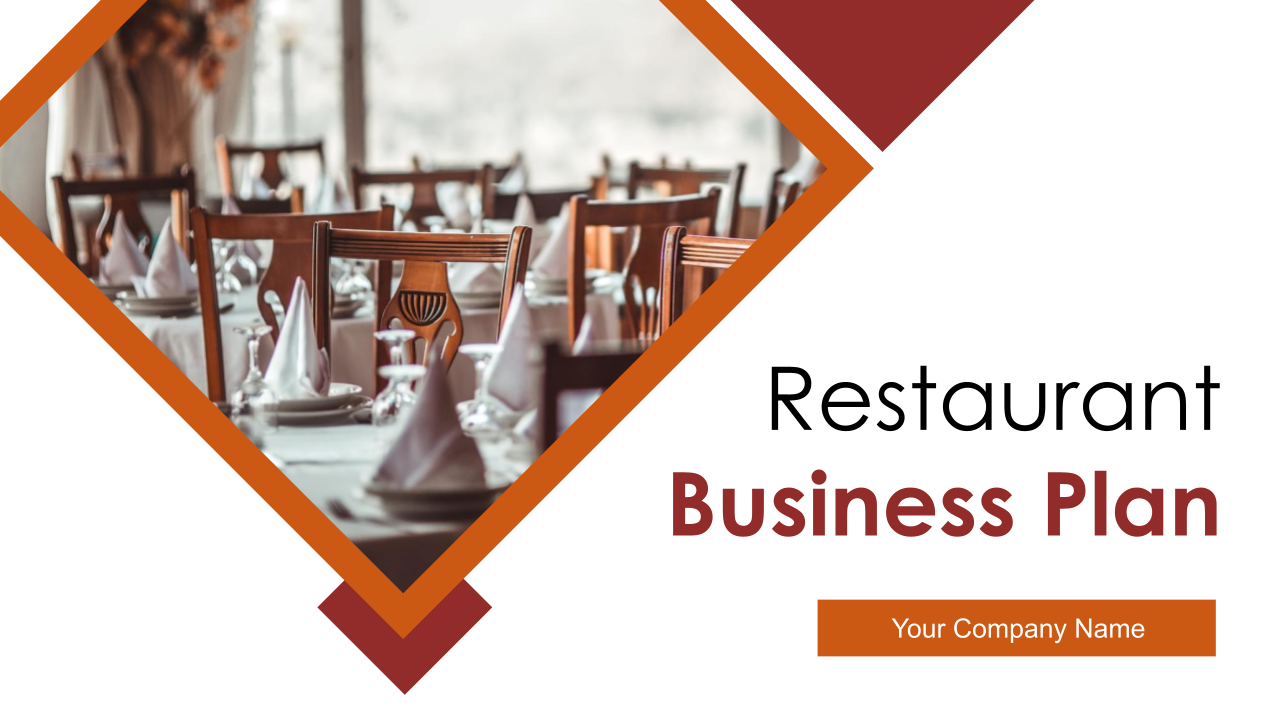
Download this template
Prepare all the ingredients for success with the help of this appealing business plan template. The extensive PowerPoint presentation will help you charm the investors to give you the funding you desire. The template also targets relevant components related to starting a restaurant. Just select this template and script a delicious success story instantly.
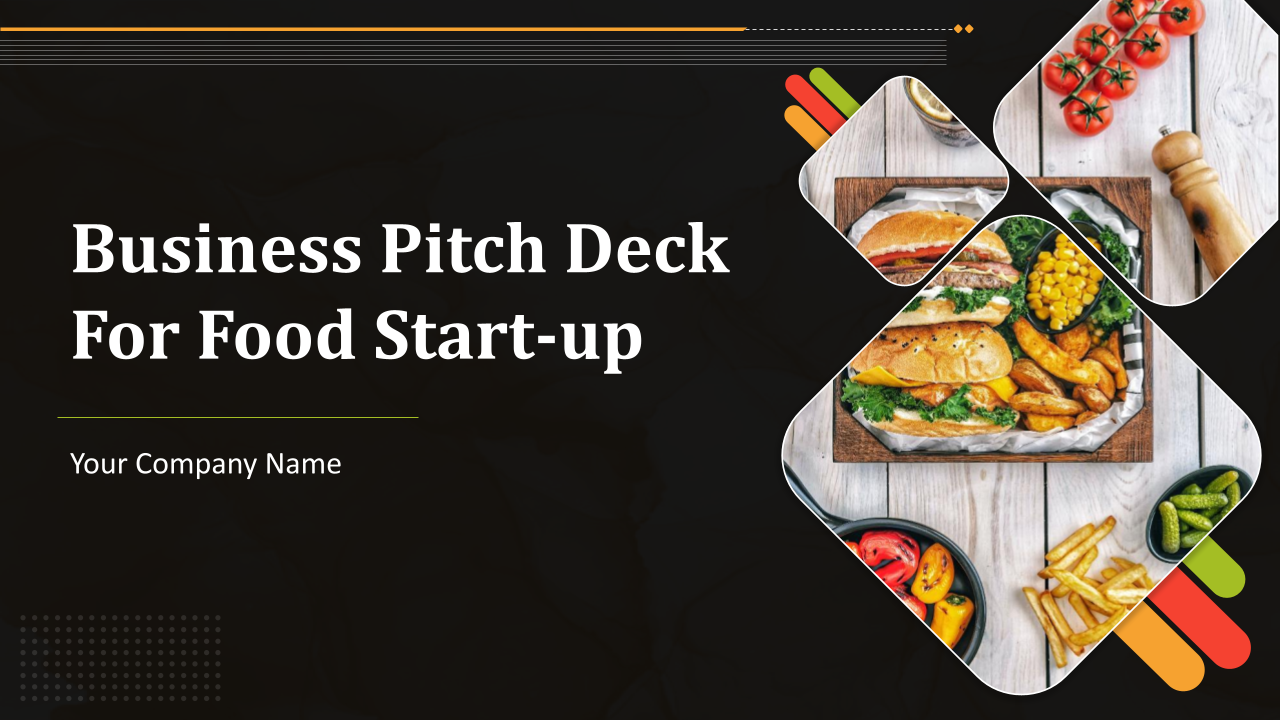
Grab this template
Plan everything related to your food startup using this illustrative PowerPoint template. If burgers and sandwiches are your choice for the new business, then this template will get you ready for any challenge in no time. The template also accommodates information about your business, the menu, the costs, and the operational checklists. Take this template and bring your business to the top.
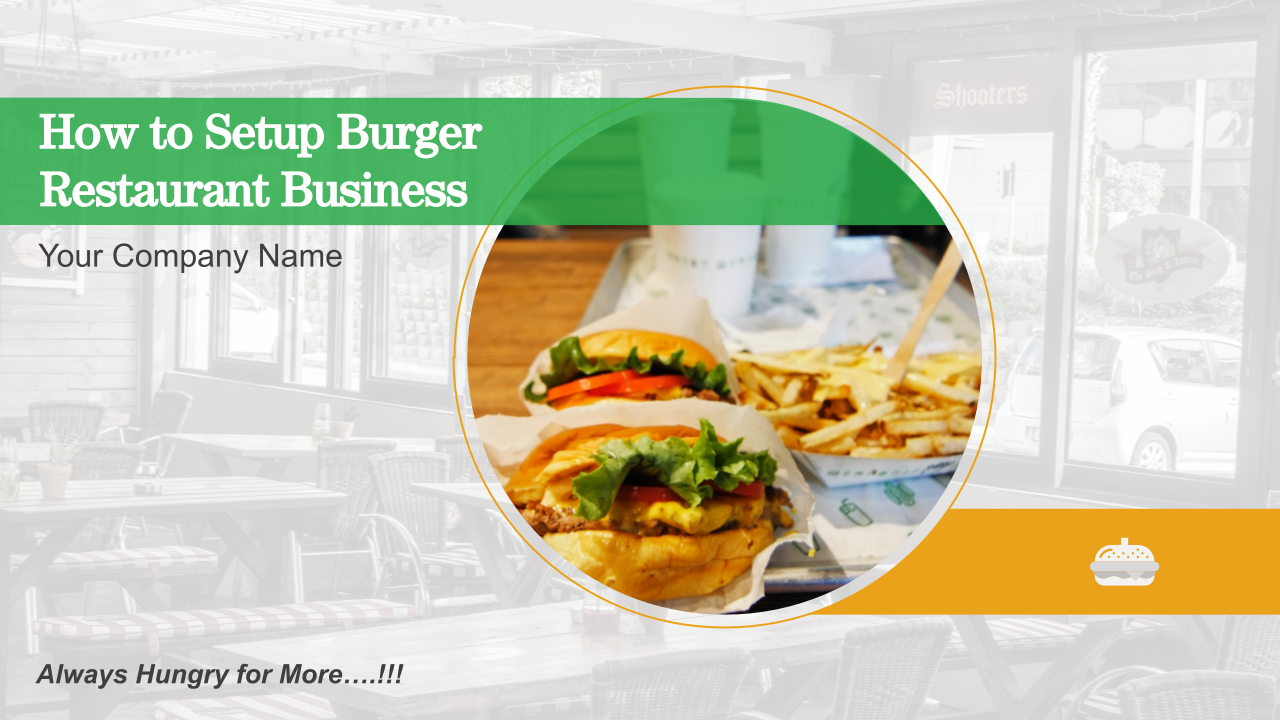
A burger joint is a universal hangout spot. The menu is crisp and the purpose is simple, get on the taste buds of the customers who are looking for a quick snack. Leverage this appeal and start your burger and snack startup by planning with the help of this PowerPoint template. The template covers A to Z of starting a burger outlet and then turning it into a global brand. Click on the link and make it yours.
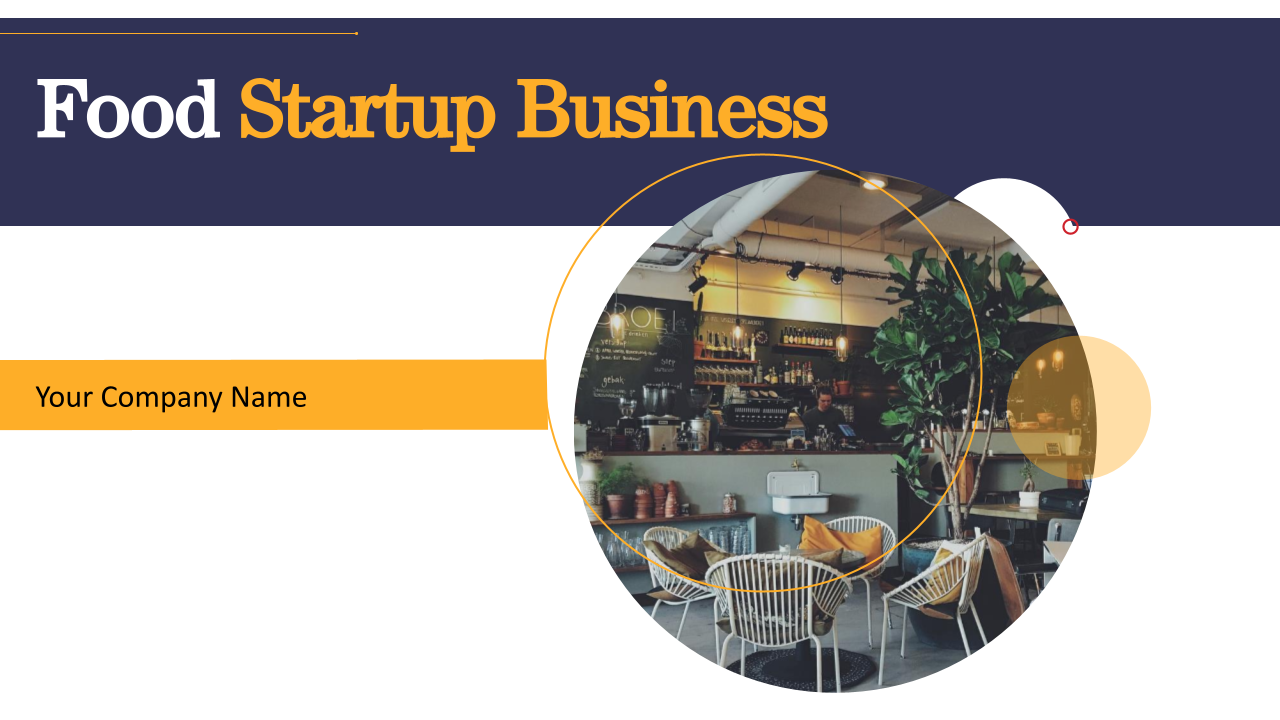
Inventory, financials, and choice of service are often a challenge for food startups. Prepare for such challenges well in advance with the help of this comprehensive business plan presentation template. You can illustrate various factors like ownership, operations, and key product offerings by employing this flexible template. Just download, edit, and present.
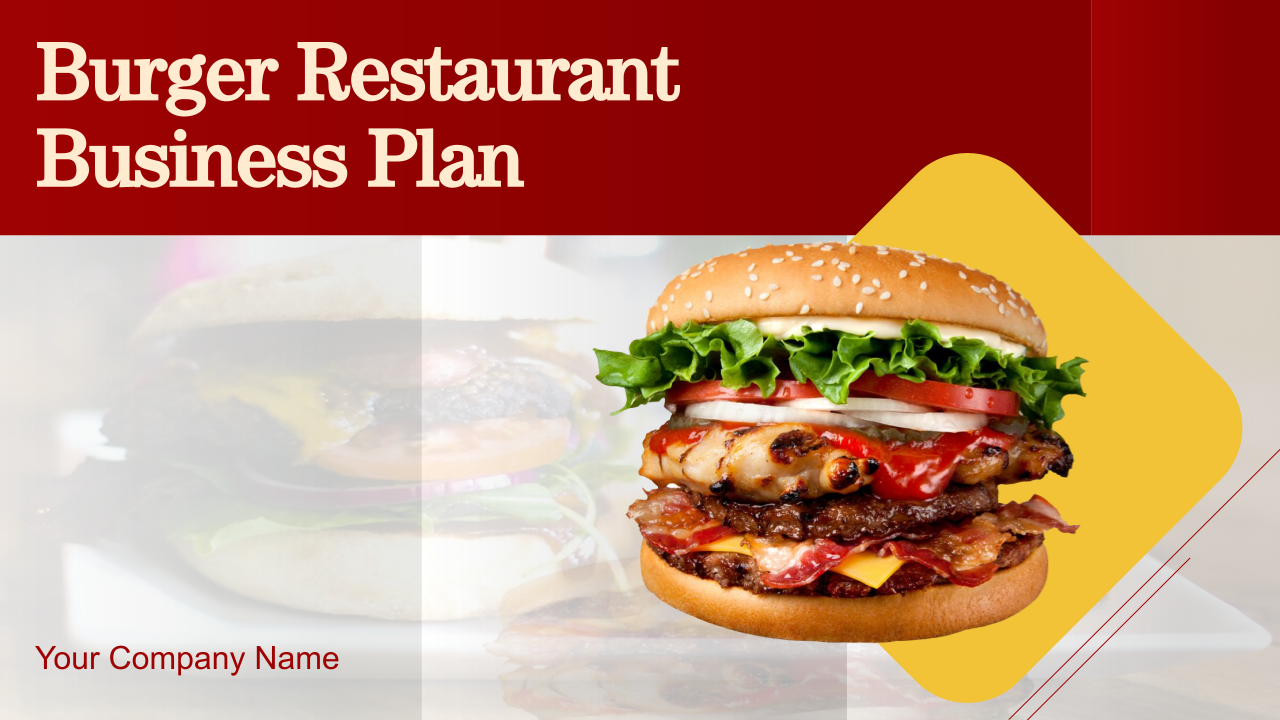
Introduce a unique fast food concept in the market by planning with the help of this content-ready restaurant presentation. The template has dedicated sections for you to jot down your goals, objectives, financials, and operational specifics. You can also use this presentation in your regular meetings or investor pitches to get the best of both worlds. Plan right and succeed!
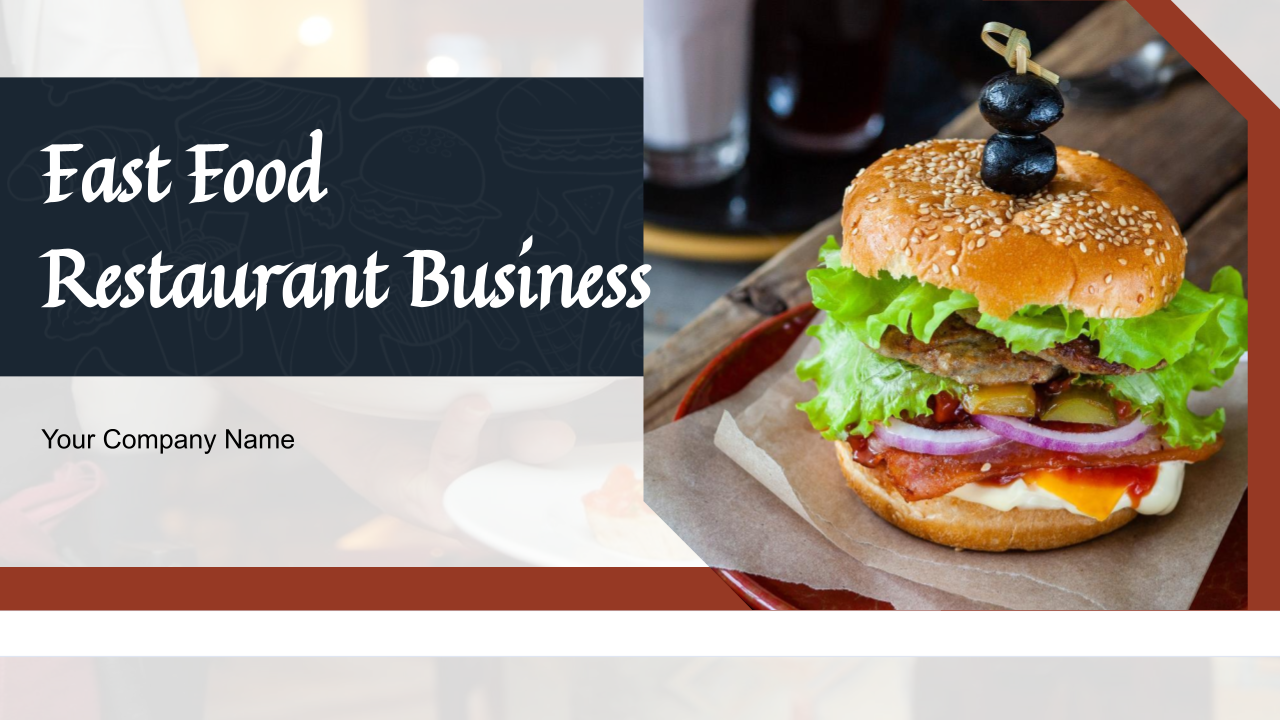
Business plan templates to get your cafe sizzling
Sometimes, you may not need a full-fledged presentation to put your food business on the map. It is best to leave slides with extensive information to do the talking on a larger scale. But if you want to serve personalized experiences and cuisine to your customers in a cozy cafe, a short format is best suited while planning your business.
Related read: 7 Approaches to Creating a One-Page Business Plan That Will Make Any Company a Winner
The reason for that is simple. Your cafe might not be sourcing inventory from a national provider, nor is it going to need huge rounds of funding early on (if it does, then congratulations! You’ve got a unicorn on your hands!). If things are starting small, then the business plan also needs to be compact and crisp. Therefore, here are a few concise cafe business plan templates to build an intimate brand.
Put your best ideas on the table with this bi-fold cafe bistro business plan template. You can give a crisp overview of your business and its requirements by utilizing this super-flexible template. Alternatively, this bi-fold document template can also serve as a mini-brochure to apprise the audience of your strategies and intended milestones. Populate this template with your content and let your ideas come to life.
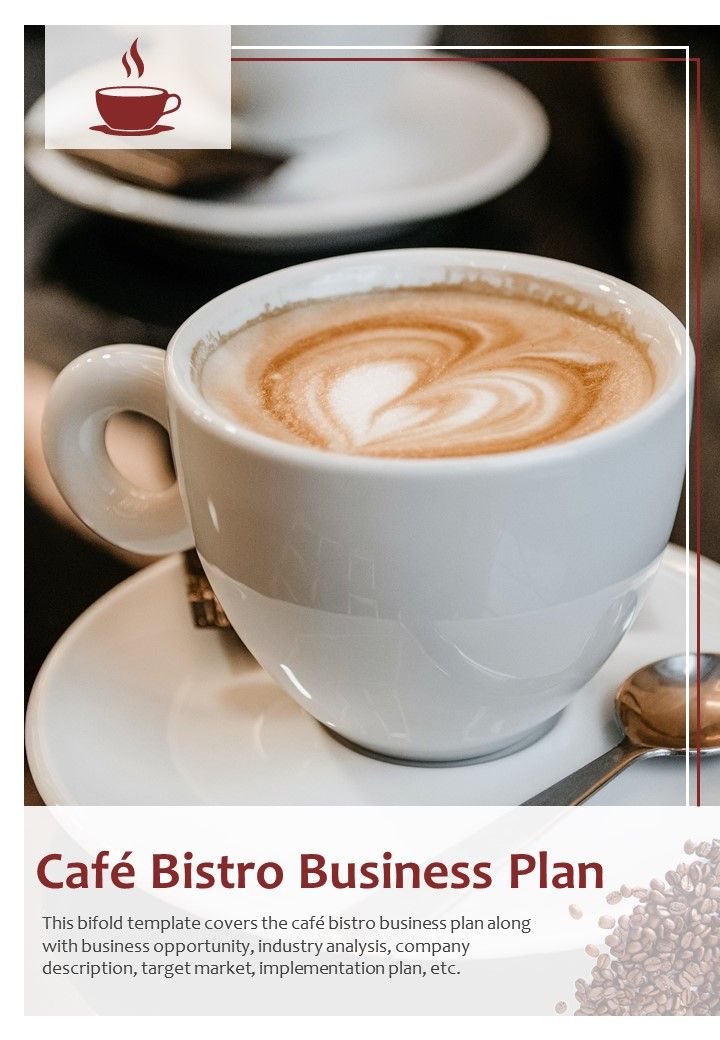
This bi-fold cafe bistro business plan template is the perfect instrument for startup success. The template has a soothing color scheme that beckons your audience towards your business idea. It also clarifies the mission, vision, objectives, strategies, and action plans of the business. So choose this creative set and prepare the ultimate communication tool.
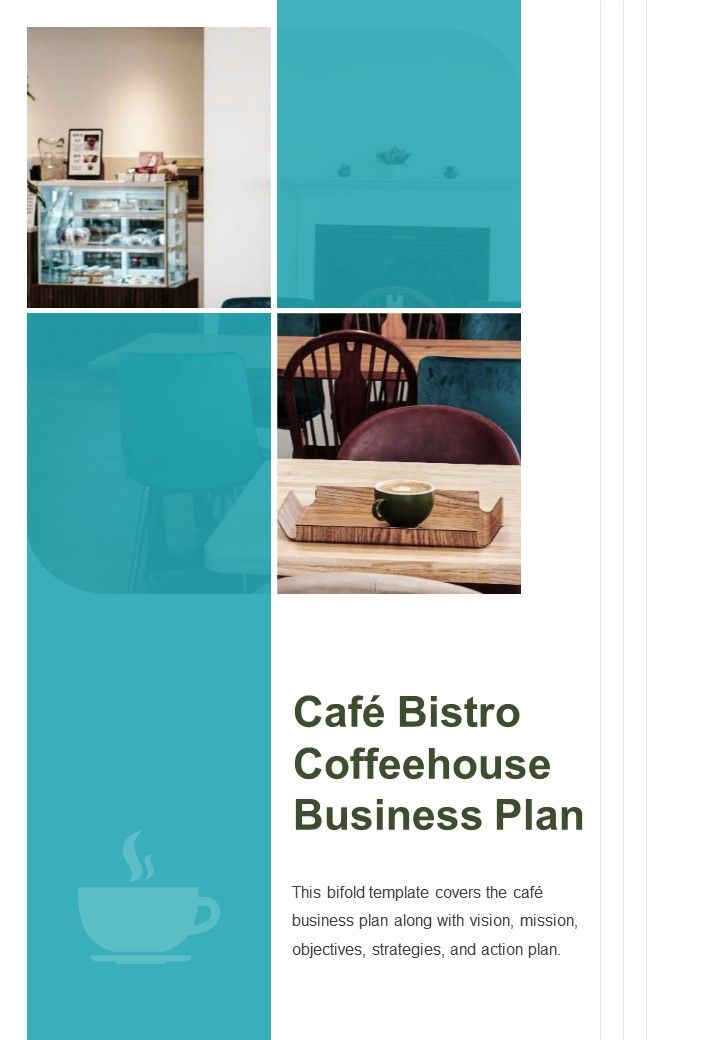
Leverage the compact design of this bi-fold business plan template to set your cafe in motion. The template lets you brief your audience about your choice of location, menu items, marketing strategy, and service approach. You can also reproduce this template into printed collateral and use it for reference along the way. The template is fully editable. So feel free to update it as you grow your business.
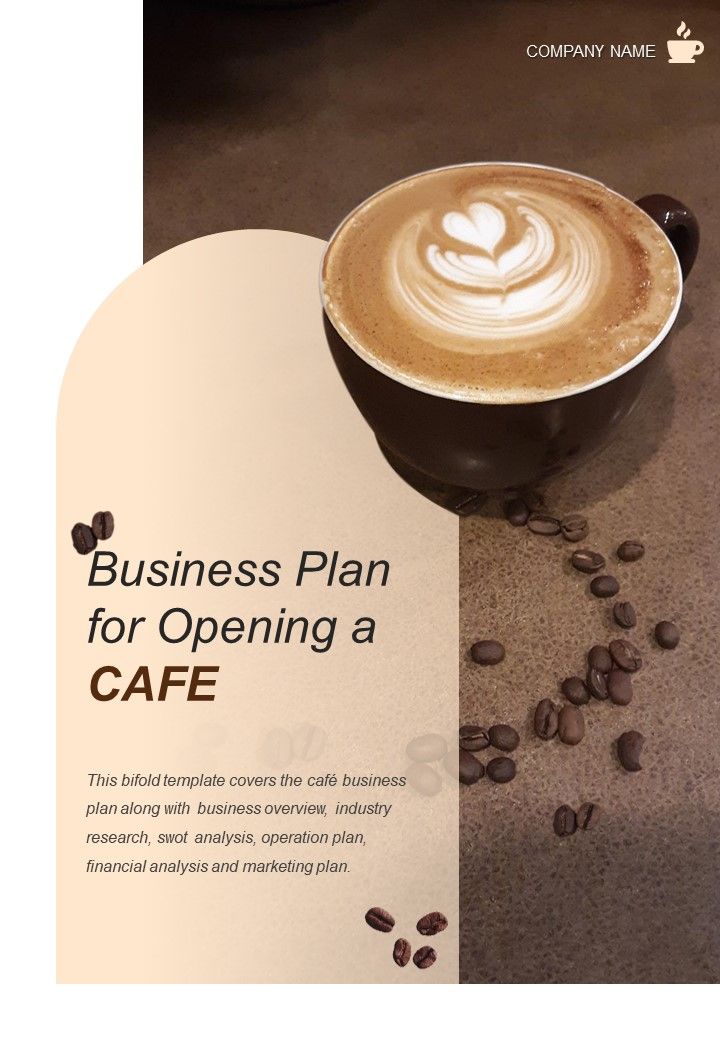
Want your cafe business plan to say a lot more with a lot fewer words? Here’s the perfectly crafted bi-fold business plan document that you can easily bring up in professional conversations around your startup idea. The template helps you set strategies according to pre-defined priorities. A tabulated representation of this scheme makes for a convenient addition to your business plan. So choose the template and get going.
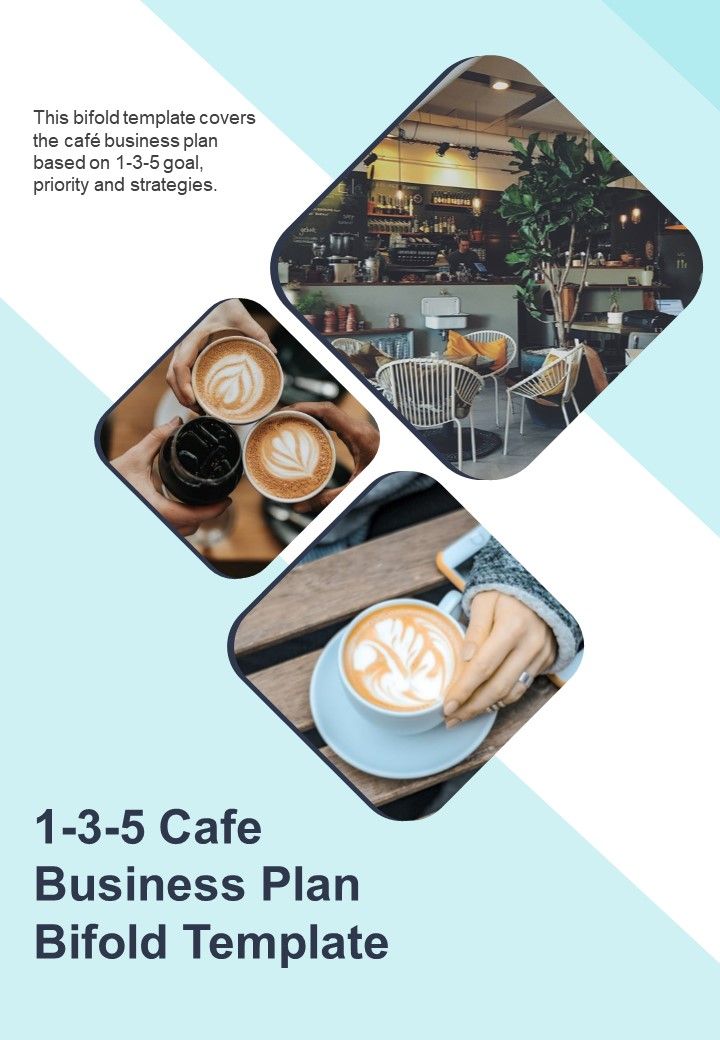
Put together the building blocks of your cafe business idea with the help of this completely editable template. This bi-fold document condenses a restaurant PPT template into an appealing format that grabs attention immediately. You can populate this template with content about your customer segments, value proposition, marketing strategies, revenue streams, and resources. Feel free to align this template with your brand as you like.
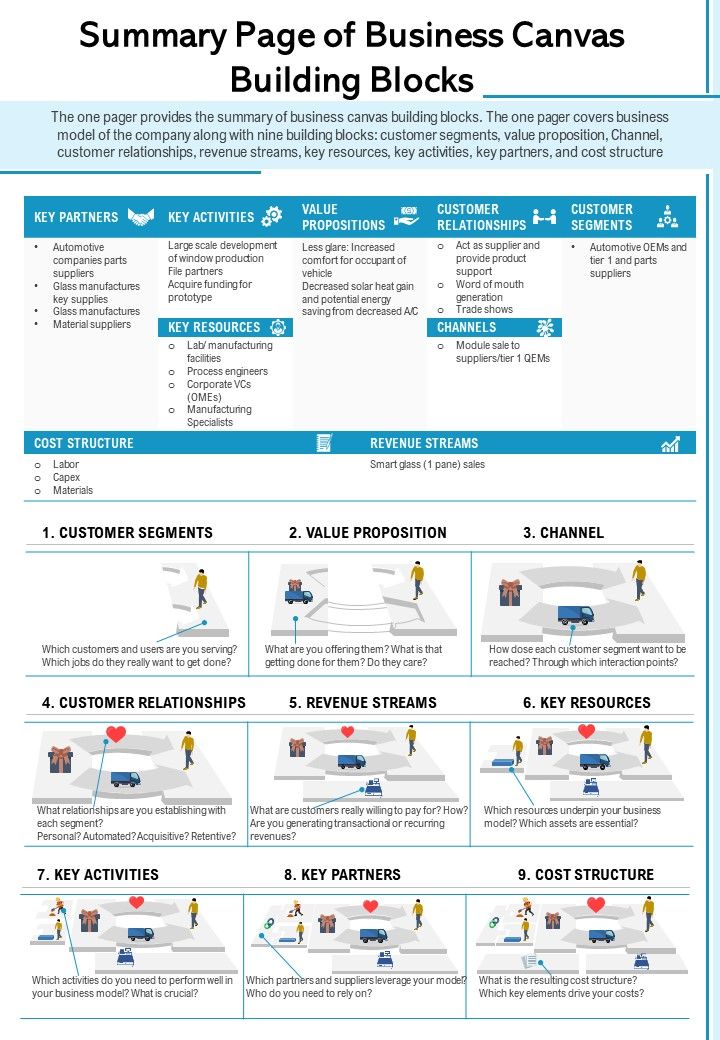
You can have several ideas about how your coffee shop will look like and what it is going to serve. Collect all those ideas onto this coffee shop business plan template , and you are ready to set up your store in no time. Moreover, the template has suitable graphics and icons that you can modify according to your needs. So don’t forget to personalize and deploy it for a successful enterprise.
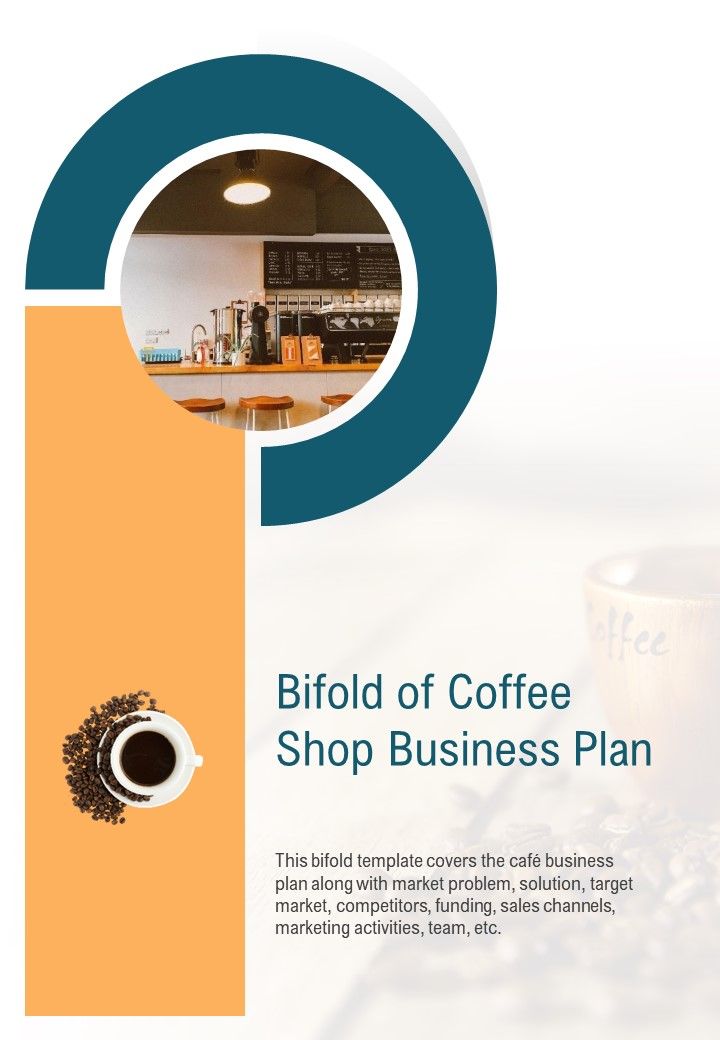
Business plan templates for coffee shops to brew excellence
A lot can start over a cuppa, even a business. Often coffee shops become the preferred choice of local food entrepreneurs. The purpose is similar to opening a bistro — serving a fresh cup with a side of a memorable experience. It will take a fair mix of strategy and innovation to bring your coffeehouse into the lives of your customers. The following flexible coffee shop business plan templates can make that challenge an opportunity to showcase your USPs. Just download and make a mark.
A coffee shop is an establishment that radiates good vibes, comfort, and, of course, sweet and savory delicacies. To ensure that your customers get this experience and more, you must be clear about how your business will cater to them. This PowerPoint template is the one-stop solution that will get you and your business partners on the same page in a matter of seconds. So select this template, get set, and go!
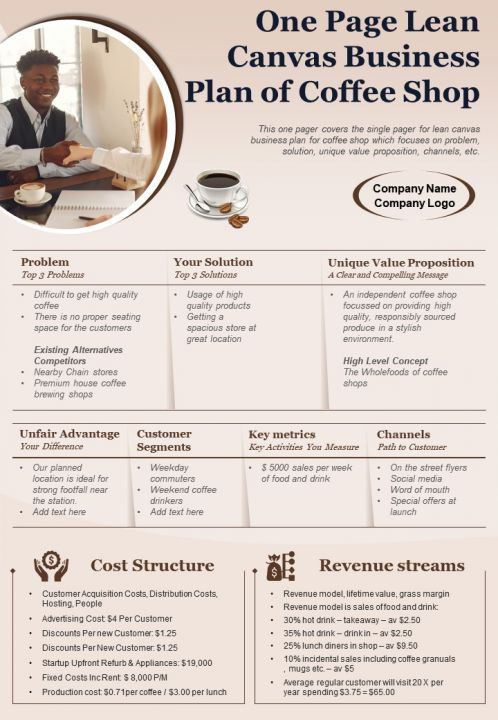
One-pagers are often the preferred communication tool for those dealing with something as lightweight as a coffee shop. Therefore, you can use this PowerPoint template to create a simple business plan for your coffee shop. Once you substitute the dummy text with your research and content, you can present the document to your investors and secure funding to get off the ground.
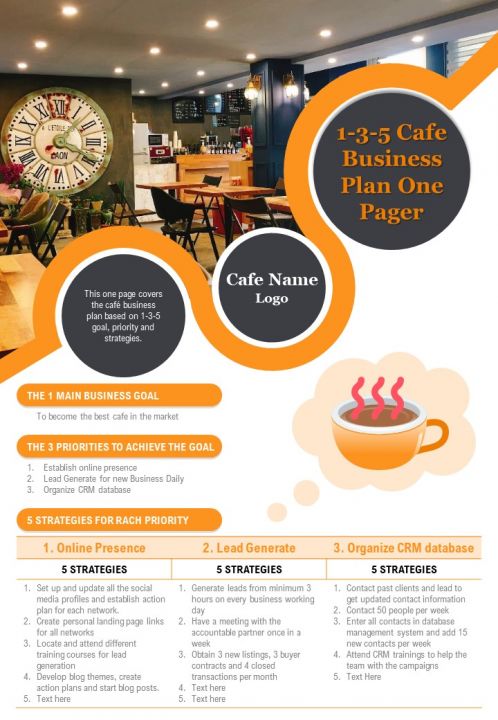
Here’s another template to keep your cafe business in line with the changing preferences of the customers. This dynamic business plan presentation preset will give your audience an overview of what your marketing and sales strategies are going to be. The template makes it possible to visualize the future of your business with due consideration for risks and incidents. So click and gain instant access to this creative set now!
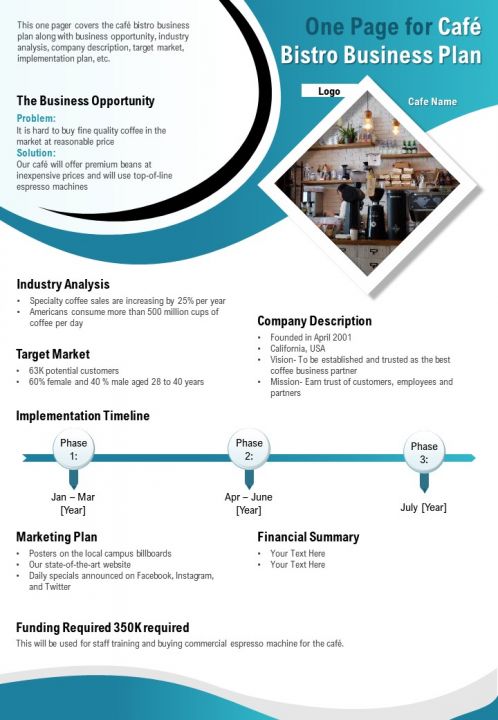
When you need the perfect starting point, the following content-ready template will guide you in the right direction. You can lay a strong foundation for your business with the help of this readily available PPT template. And you don’t have to limit its use to a cafe. You can also employ this stunning piece of visual content for your ideas for an eatery or a bakery. Just change the pictures to suit the theme, and you are good to launch a successful business.
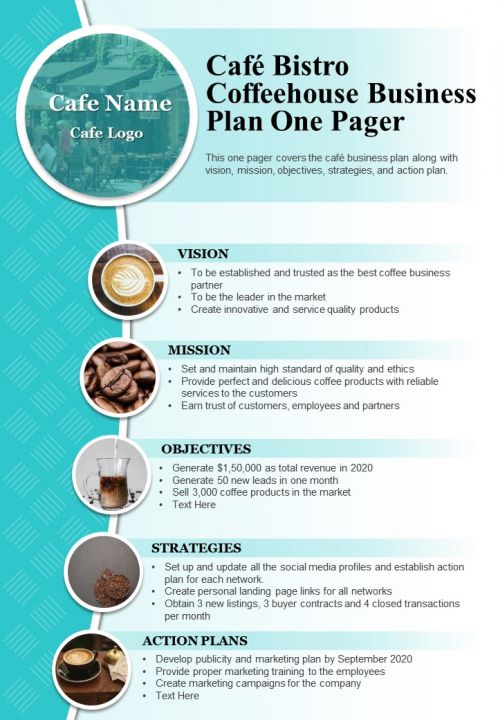
As much as you want to start a coffee shop as an after-thought of a Sunday brunch, the idea won’t materialize well if you do not plan for it. So to get you out of whimsical mode and into the practical mode, here’s a comprehensive one-page business plan template. The highlight of this template is that it comes pre-populated with thematic icons and graphics. So you do not have to worry about how your business plan design might turn out.
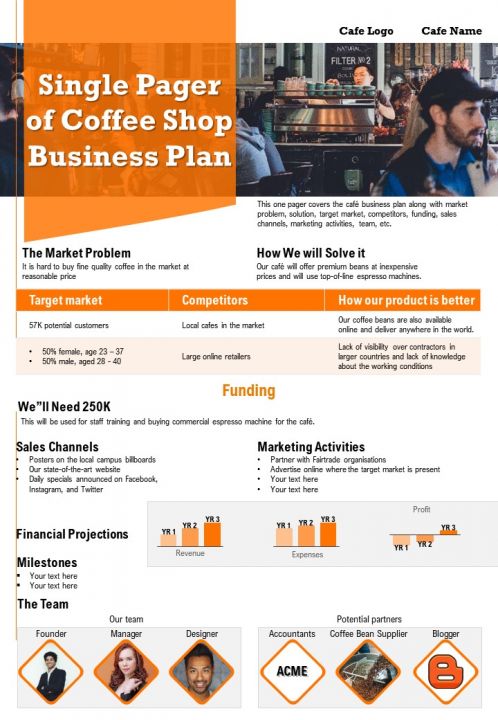
Highlight the problem statement, target market, funding requirement, and sales channels for your coffee shop brand with this handy PPT template. You can also showcase the financial projections and marketing outline for the business with this content-ready template. The template has editable graphics and Excel-linked charts. So type in your numbers, and your plan is ready.
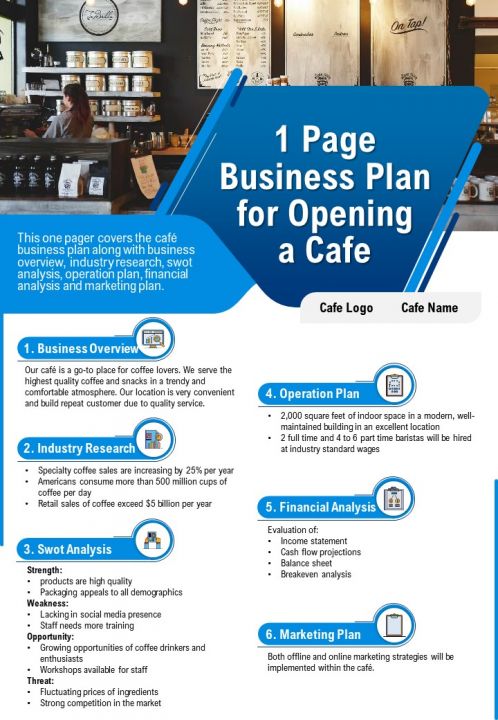
Your success recipe is ready!
Translating your passion for food into a functional business may take more than just knowledge about various types of cheese. Your choice of footing and product can make or break your business. Therefore, you must prepare for the big step with ample research and competitor analysis.
Once you have collected the required data, the next step is buttery smooth – put your ideas onto our business plan ppt templates. And when one fine day you become the owner of a restaurant, cafe, or coffee shop buzzing with customers, success will smell minty fresh and taste al dente.
Related posts:
- Top 10 Must-Have Food Startup Pitch Decks to Get Investors’ Attention
- How to Craft a Perfect Coffee Shop Business Plan? Access the Best PDF Word Document
- Coffee Shop Business Plan Templates: A Pathway to Profitable Brews
- Top 10 Food Plan Templates with Samples and Examples
Liked this blog? Please recommend us

100+ One Page Business Plans, Proposals, and Executive Summaries For Every Industry

Top 10 One-Page Food Fact Sheet Templates to Help Your Customers Make a Healthy Choice
This form is protected by reCAPTCHA - the Google Privacy Policy and Terms of Service apply.

Digital revolution powerpoint presentation slides

Sales funnel results presentation layouts
3d men joinning circular jigsaw puzzles ppt graphics icons

Business Strategic Planning Template For Organizations Powerpoint Presentation Slides

Future plan powerpoint template slide

Project Management Team Powerpoint Presentation Slides

Brand marketing powerpoint presentation slides

Launching a new service powerpoint presentation with slides go to market

Agenda powerpoint slide show

Four key metrics donut chart with percentage

Engineering and technology ppt inspiration example introduction continuous process improvement

Meet our team representing in circular format

Upmetrics AI Assistant: Simplifying Business Planning through AI-Powered Insights. Learn How
Entrepreneurs & Small Business
Accelerators & Incubators
Business Consultants & Advisors
Educators & Business Schools
Students & Scholars
AI Business Plan Generator
Financial Forecasting
AI Assistance
Ai pitch deck generator
Strategic Planning
See How Upmetrics Works →
- Sample Plans
- WHY UPMETRICS?
Customers Success Stories
Business Plan Course
Small Business Tools
Strategic Canvas Templates
E-books, Guides & More
- Sample Business Plans
- Food, Beverage & Restaurant
How to Write a Play Cafe Business Plan + Free Template

Free Business Plan Template
Download our free business plan template now and pave the way to success. Let’s turn your vision into an actionable strategy!
- Fill in the blanks – Outline
- Financial Tables
How to Write a Play Cafe Business Plan?
Writing a Play Cafe business plan is a crucial step toward the success of your business. Here are the key steps to consider when writing a business plan:
1. Executive Summary
An executive summary is the first section planned to offer an overview of the entire business plan. However, it is written after the entire business plan is ready and summarizes each section of your plan.
Here are a few key components to include in your executive summary:
Introduce your Business
Start your executive summary by briefly introducing your business to your readers.
This section may include the name of your play cafe business, its location when it was founded, etc.
Market Opportunity
Summarize your market research, including market size, growth potential, and marketing trends. Highlight the opportunities in the market and how your business will fit in the industry.
Play Cafe Facilities
Highlight the play cafe facilities you offer your clients. The USPs and differentiators you offer are always a plus.
Marketing & Sales Strategies
Outline your sales and marketing strategies—what marketing platforms you use, how you plan on attracting potential customers, etc.
Financial Highlights
Briefly summarize your financial projections for the initial years of business operations. Include capital or investment requirements, associated startup costs, projected revenues, and profit forecasts.
Call to Action
Summarize your executive summary section with a clear CTA, for example, inviting potential partners or investors to show any interest in your business idea.
Ensure your executive summary is clear, concise, easy to understand, and jargon-free.
Say goodbye to boring templates
Build your business plan faster and easier with AI
Plans starting from $7/month

2. Business Overview
The business overview section of your business plan offers detailed information about your business. The details you add will depend on how important they are to your business. Yet, business name, location, business history, and future goals are some of the foundational elements you must consider adding to this section:
Business Description
Describe what kind of play cafe business you run and the name of it. You may specialize in one of the following play cafe businesses:
- Traditional play cafe
- EduPlay cafe
- Culinary play cafe
- Artistic play cafe
- Sports-driven play cafe
- Tech play cafe
- Indoor Adventure Play cafe
Describe the legal structure of your play cafe business, whether it is a sole proprietorship, LLC, partnership, or others. Also, explain where your business is located and why you selected the place.
List the names of your play cafe business’s founders or owners. Describe what shares they own and their responsibilities for efficiently managing the business.
Mission Statement
Summarize your business’ objective, core principles, and values in your mission statement. This statement needs to be memorable, clear, and brief. For example,
Mission statement for FunFiesta
Our mission at FunFiesta is to create an inclusive and joyous environment where families can come together to relax, play, and build lasting memories. We aim to provide a unique fusion of quality café offerings and a meticulously designed play area that caters to the diverse needs of both parents and children.
Business History
If you’re an established play cafe, briefly describe your business history, like—when it was founded, how it evolved, etc.
Additionally, If you have received any awards or recognition for excellent work, describe them.
Future Goals
It’s crucial to convey your aspirations and vision. Mention your short-term and long-term goals; they can be specific targets for revenue, market share, or expanding your services.
This section should provide a thorough understanding of your business, its history, and its plans. Keep this section engaging, precise, and to the point.
3. Market Analysis
The market analysis section of your business plan should offer a thorough understanding of the industry with the target market, competitors, and growth opportunities. You should include the following components in this section.
Target market
Start this section by describing your target market. Define your ideal customer and explain what types of services they prefer. Creating a buyer persona will help you easily define your target market to your readers. For example,

Market size and growth potential
Describe your market size and growth potential and whether you will target a niche or a much broader market.
For example, the revenue for the indoor play center industry in 2022 was $714.9 million .
Competitive Analysis
Identify and analyze your direct and indirect competitors. Identify their strengths and weaknesses, and describe what differentiates your play cafe from them. Point out how you have a competitive edge in the market.
Regulatory Environment
List regulations and licensing requirements that may affect your play cafe business, such as licensing & permits, safety standards, health & sanitation, employee background checks, data protection, etc.
Here are a few tips for writing the market analysis section of your play cafe business plan:
- Conduct market research, industry reports, and surveys to gather data.
- Provide specific and detailed information whenever possible.
- Illustrate your points with charts and graphs.
- Write your business plan keeping your target audience in mind.
4. Cafe Facilities
The cafe facilities section should describe the specific services & facilities that will be offered to customers. Mention the play cafe facilities your business will offer. This list may include:
- Indoor play structures
- Creative play zones
- Cafe facilities
- Birthday party packages
- Special events
- Membership programs
- Themed decor and ambiance
Consider adding your menu in this section to provide an overview of what you provide and what are the options. For example,

In short, this section of your play cafe plan must be informative, precise, and client-focused. By providing a clear and compelling description of your offerings, you can help potential investors and readers understand the value of your business.
5. Sales And Marketing Strategies
Writing the sales and marketing strategies section means a list of strategies you will use to attract and retain your clients. Here are some key elements to include in your sales & marketing plan:
Unique Selling Proposition (USP)
Define your business’s USPs depending on the market you serve, the equipment you use, and your unique services. Identifying USPs will help you plan your marketing strategies. For example,
Unique selling propositions of FunFiesta
FunFiesta, a standout player in the play cafe industry, distinguishes itself through a blend of immersive features and customer-centric offerings. The establishment prioritizes the safety of children, adhering to stringent safety standards while providing a visually captivating thematic experience.
With versatile and age-appropriate play structures, FunFiesta caters to a broad spectrum of developmental stages. The commitment to educational enrichment is evident through engaging programs, fostering early childhood development.
Flexible membership options and customizable birthday packages enhance accessibility and convenience for families. FunFiesta’s family-friendly cafe, interactive events, and workshops contribute to a dynamic experience.
The incorporation of customer loyalty rewards, online booking systems, and a retail merchandise corner underscores a commitment to customer satisfaction.
Pricing Strategy
Describe your pricing strategy—how you plan to price your services and stay competitive in the local market. You can mention any discounts you plan on offering to attract new customers to your play cafe.
Marketing & Sales strategies
Discuss your marketing and sales strategies to spread your reach and grow your regular customers. Some of the strategies that you may use are:
- Social media marketing
- Targeted online advertising
- Partnership with schools & daycares
- Loyalty program & referral discounts
- Email marketing campaigns
- Influencer collaboration
- Local press and media coverage
Overall, this section of your play cafe business plan should focus on customer acquisition and retention.
Have a specific, realistic, and data-driven approach while planning sales and marketing strategies for your play cafe business, and be prepared to adapt or make strategic changes in your strategies based on feedback and results.
6. Operations Plan
The operations plan section of your business plan should outline the processes and procedures involved in your business operations, such as staffing requirements and operational processes. Here are a few components to add to your operations plan:
Staffing & Training
Mention your business’s staffing requirements, including the number of employees or other staff needed. Include their qualifications, the training required, and the duties they will perform.
Operational Process
Outline the processes and procedures you will use to run your play cafe business. Your operational processes may include customer check-in, play area supervision, cafe operations, event coordination, educational programs, etc.
Include the list of equipment required for the play cafe, such as play structures, cafe furniture & setups, kitchen appliances, audio-visual equipment, etc.
Adding these components to your operations plan will help you lay out your business operations, which will eventually help you manage your business effectively.
7. Management Team
The management team section provides an overview of your play cafe business’s management team. This section should provide a detailed description of each manager’s experience and qualifications, as well as their responsibilities and roles.
Founders/CEO
Mention the founders and CEO of your play cafe business, and describe their roles and responsibilities in successfully running the business.
Key managers
Introduce your management and key members of your team, and explain their roles and responsibilities.
Management team of FunFiesta
Emma Rodriguez – General Manager
Emma oversees the overall operations of FunFiesta. With a background in child development and business management, she ensures that the play cafe provides a safe and engaging environment for children. Emma also manages strategic partnerships and community engagement.
Jason Turner – Cafe Manager
As the Cafe Manager, Jason takes care of the food and beverage section of FunFiesta. With experience in hospitality management, he curates a menu suitable for children and adults alike. Jason ensures that the cafe runs smoothly, maintaining high standards of hygiene and customer service.
Carlos Mendez – Play Area Supervisor:
Carlos manages the play structures and ensures a safe and enjoyable play environment. With expertise in recreational facilities management, he conducts regular inspections, oversees maintenance, and trains staff to prioritize safety. Carlos is passionate about creating a fun and secure space for children.
Dr. Alex Turner – Child Development Specialist:
Dr. Turner, with a Ph.D. in Child Psychology, serves as the Child Development Specialist at FunFiesta. He provides insights into creating play experiences that contribute to children’s cognitive and social development. Dr. Turner also conducts workshops for parents on the importance of play.
Organizational structure
Explain the organizational structure of your management team. Include the reporting line and decision-making hierarchy.
Compensation Plan
Describe your compensation plan for the management and staff. Include their salaries, incentives, and other benefits.
Advisors/Consultants
Mentioning advisors or consultants in your business plans adds credibility to your business idea.
So, if you have any advisors or consultants, include them with their names and brief information consisting of roles and years of experience.
This section should describe the key personnel for your play cafe business, highlighting how you have the perfect team to succeed.
8. Financial Plan
Your financial plan section should provide a summary of your business’s financial projections for the first few years. Here are some key elements to include in your financial plan:
Profit & loss statement
Describe details such as projected revenue, operational costs, and service costs in your projected profit and loss statement. Make sure to include your business’s expected net profit or loss.
Cash flow statement
The cash flow for the first few years of your operation should be estimated and described in this section. This may include billing invoices, payment receipts, loan payments, and any other cash flow statements.
Balance Sheet
Create a projected balance sheet documenting your Play Cafe business’s assets, liabilities, and equity.
Break-even point
Determine and mention your business’s break-even point—the point at which your business costs and revenue will be equal.
This exercise will help you understand how much revenue you need to generate to sustain or be profitable.
Financing Needs
Calculate costs associated with starting a play cafe business, and estimate your financing needs and how much capital you need to raise to operate your business. Be specific about your short-term and long-term financing requirements, such as investment capital or loans.
Be realistic with your financial projections, and make sure you offer relevant information and evidence to support your estimates.
9. Appendix
The appendix section of your plan should include any additional information supporting your business plan’s main content, such as market research, legal documentation, financial statements, and other relevant information.
- Add a table of contents for the appendix section to help readers easily find specific information or sections.
- In addition to your financial statements, provide additional financial documents like tax returns, a list of assets within the business, credit history, and more. These statements must be the latest and offer financial projections for at least the first three or five years of business operations.
- Provide data derived from market research, including stats about the industry, user demographics, and industry trends.
- Include any legal documents such as permits, licenses, and contracts.
- Include any additional documentation related to your business plan, such as product brochures, marketing materials, operational procedures, etc.
Use clear headings and labels for each section of the appendix so that readers can easily find the necessary information.
Remember, the appendix section of your play cafe business plan should only include relevant and important information supporting your plan’s main content.
The Quickest Way to turn a Business Idea into a Business Plan
Fill-in-the-blanks and automatic financials make it easy.

This sample play cafe business plan will provide an idea for writing a successful play cafe plan, including all the essential components of your business.
After this, if you still need clarification about writing an investment-ready business plan to impress your audience, download our Play Cafe business plan pdf .
Frequently Asked Questions
Why do you need a play cafe business plan.
A business plan is an essential tool for anyone looking to start or run a successful play cafe business. It helps to get clarity in your business, secures funding, and identifies potential challenges while starting and growing your business.
Overall, a well-written plan can help you make informed decisions, which can contribute to the long-term success of your play cafe business.
How to get funding for your play cafe business?
There are several ways to get funding for your play cafe business, but self-funding is one of the most efficient and speedy funding options. Other options for funding are:
- Bank loan – You may apply for a loan in government or private banks.
- Small Business Administration (SBA) loan – SBA loans and schemes are available at affordable interest rates, so check the eligibility criteria before applying for it.
- Crowdfunding – The process of supporting a project or business by getting a lot of people to invest in your business, usually online.
- Angel investors – Getting funds from angel investors is one of the most sought-after startup options.
Apart from all these options, there are small business grants available, check for the same in your location and you can apply for it.
What is the easiest way to write your play cafe business plan?
A lot of research is necessary for writing a business plan, but you can write your plan most efficiently with the help of any play cafe business plan example and edit it as per your need. You can also quickly finish your plan in just a few hours or less with the help of our amazing business plan software .
Should I have someone review my play cafe business plan?
Yes, ask your family, friends, or partners to review it first, before you go to your audience with any requirement. You might overlook certain points while writing a business plan, which your family or friends might catch, so do not risk it.
What are the financing and funding requirements that should be detailed in the play cafe plan?
The play cafe business plan should detail startup costs, operational expenses, equipment and inventory needs, marketing budget, working capital, contingency fund, funding sources, financial projections, expected return on investment (ROI), and potential exit strategies for investors.
About the Author
Upmetrics Team
Upmetrics is the #1 business planning software that helps entrepreneurs and business owners create investment-ready business plans using AI. We regularly share business planning insights on our blog. Check out the Upmetrics blog for such interesting reads. Read more
Plan your business in the shortest time possible
No Risk – Cancel at Any Time – 15 Day Money Back Guarantee
Popular Templates

Create a great Business Plan with great price.
- 400+ Business plan templates & examples
- AI Assistance & step by step guidance
- 4.8 Star rating on Trustpilot
Streamline your business planning process with Upmetrics .

- Vacation Rentals
- Restaurants
- Things to do
- Moscow Tourism
- Moscow Hotels
- Moscow Bed and Breakfast
- Moscow Vacation Rentals
- Flights to Moscow
- Moscow Restaurants
- Things to Do in Moscow
- Moscow Travel Forum
- Moscow Photos
- All Moscow Hotels
- Moscow Hotel Deals
- Moscow Motels
- Moscow Hostels
- Moscow Campgrounds
- Moscow Business Hotels
- Moscow Spa Resorts
- Moscow Family Hotels
- Moscow Luxury Hotels
- Romantic Hotels in Moscow
- Moscow Green Hotels
- Moscow Ski-In / Ski-Out Hotels
- Moscow Resorts
- 5-stars Hotels in Moscow
- 4-stars Hotels in Moscow
- 3-stars Hotels in Moscow
- Marriott Hotels in Moscow
- Novotel Hotels in Moscow
- Crowne Plaza Hotels in Moscow
- Rotana Hotels in Moscow
- Accor Hotels in Moscow
- InterContinental (IHG) Hotels in Moscow
- Radisson Hotels in Moscow
- Hilton Hotels in Moscow
- Holiday Inns in Moscow
- ibis Hotels in Moscow
- Radisson Blu Hotels in Moscow
- Hampton by Hilton Hotels in Moscow
- Moscow Hotels with Pools
- Pet Friendly Hotels in Moscow
- Moscow Hotels with Free Parking
- 3rd Transport Ring (TTK) Hotels
- District Central (TsAO) Hotels
- Garden Ring Hotels
- Boulevard Ring Hotels
- Tverskoy Hotels
- Red Square & Kitay-gorod Hotels
- Zamoskvorechye Hotels
- Meshchanskiy Hotels
- Presnensky Hotels
- District Eastern (VAO) Hotels
- Moscow Affordable Hotels
- Boutique Hotels in Moscow
- Moscow Heritage Hotels
- Hotels with Nightclubs in Moscow
- Moscow City Center Hotels
- Moscow Hotels with Concierge
- Moscow Accessible Hotels
- Moscow Hotels with Outdoor Pool
- Moscow Hotels with a View
- Moscow Non-Smoking Hotels
- Hotels near Red Square
- Hotels near Moscow Metro
- Hotels near Saint Basil's Cathedral
- Hotels near Moscow Kremlin
- Hotels near High-Speed Train Sapsan
- Hotels near GUM
- Hotels near State Tretyakov Gallery
- Hotels near Tsaritsyno Museum-Reserve
- Hotels near Armoury Chamber
- Hotels near Bolshoi Theatre
- Hotels near Kremlin Walls and Towers
- Hotels near Gorky Central Park of Culture and Leisure
- Hotels near Kolomenskoye Historical and Architectural Museum and Reserve
- Hotels near PANORAMA360
- Hotels near (ZIA) Zhukovsky International Airport
- Hotels near (VKO) Vnukovo Airport
- Hotels near (DME) Domodedovo Airport
- Rio Hotel & Casino
- Excellence Playa Mujeres
- Excalibur Hotel & Casino
- Secrets Akumal Riviera Maya
- Resorts Hedonism (Hedonism II Resort)
- Secrets Cap Cana Resort & Spa
- Disney's All-Star Movies Resort
- Dreams Royal Beach Punta Cana
- Mandalay Bay Resort & Casino
- The Westin Reserva Conchal, an All-Inclusive Golf Resort & Spa
- Secrets The Vine Cancun
- The Venetian Resort
- Excellence Punta Cana
- Giraffe Manor
- Renaissance Wind Creek Aruba Resort
- Popular All-Inclusive Resorts
- Popular Beach Resorts
- Popular Family Resorts
- Popular All-Inclusive Hotels
- Popular Hotels With Waterparks
- Popular Honeymoon Resorts
- Popular Luxury Resorts
- Popular All-Inclusive Family Resorts
- Popular Golf Resorts
- Popular Spa Resorts
- Popular Cheap Resorts
- All Moscow Restaurants
- Cafés in Moscow
- Fast Food Restaurants in Moscow
- Fusion Restaurants with Outdoor Seating in Moscow
- Italian Restaurants in Moscow
- Japanese Restaurants in Moscow
- Late Night Middle Eastern Restaurants in Moscow
- Mediterranean Restaurants for Lunch in Moscow
- Mediterranean Restaurants in Moscow
- Pizza in Moscow
- Russian Restaurants in Moscow
- Seafood Restaurants in Moscow
- Vegan Restaurants in Moscow
- Vegetarian Restaurants in Moscow
- Best Meatballs in Moscow
- Best Falafel in Moscow
- Best Baguettes in Moscow
- Best Pretzels in Moscow
- Best Lasagne in Moscow
- Best Udon & Soba (Wheat & Buckwheat Noodle) in Moscow
- Best Ramen in Moscow
- Best Clam Chowder in Moscow
- Best Waffles & Crepes in Moscow
- Best Macaroons in Moscow
- Best Pad Thai in Moscow
- Best Hot Dogs in Moscow
- Best Cod in Moscow
- Best Crab in Moscow
- Best Tapas in Moscow
- Breakfast Restaurants in Moscow
- Lunch Restaurants in Moscow
- Dinner Restaurants in Moscow
- Bakeries in Moscow
- Buffet Restaurants in Moscow
- Coffee & Tea in Moscow
- Desserts in Moscow
- Food Delivery Restaurants in Moscow
- Kid Friendly Restaurants in Moscow
- Late Night Restaurants in Moscow
- Restaurants for Special Occasions in Moscow
- Restaurants with Outdoor Seating in Moscow
- Romantic Restaurants in Moscow
- Arbat Restaurants
- Basmanny Restaurants
- Coffee & Tea in Red Square & Kitay-gorod
- Dinner Restaurants in Tverskaya
- Dumplings in Tverskaya
- German Restaurants in Tverskaya
- Japanese Restaurants for Lunch in Tverskaya
- Khamovniki Restaurants
- Maryina Roshcha (Jewish Quarter) Restaurants
- Patriarch Ponds Restaurants
- Presnensky Restaurants
- Red Square & Kitay-gorod Restaurants
- Tverskaya Restaurants
- Yakimanka Restaurants
- Zamoskvorechye Restaurants
- GreenLeaders
- Things to Do
- Travel Stories
- Rental Cars
- Add a Place
- Travel Forum
- Travelers' Choice
- Help Center
- Europe
- Russia
- Central Russia
- Moscow
- Moscow Restaurants
Business-Cafe
Ratings and reviews, food and ambience, location and contact.

BUSINESS-CAFE, Moscow - Cheremushki - Restaurant Reviews & Photos - Tripadvisor
- Elektrostal, Moscow Oblast /
The attentive barista welcomes guests all year round.
Similar restaurants nearby
Tasty dishes in elektrostal.

Restaurant features in Elektrostal


IMAGES
VIDEO
COMMENTS
Der Businessplan zum Café gründen beinhaltet über das Konzept hinaus auch noch finanzielle Kennzahlen, Ziele, Risiken, Marktinformationen und Gewinnprognosen. Der Businessplan ist insbesondere dafür gedacht, Investoren von Deiner Café Idee zu überzeugen. Ganz simpel der Plan für Dein Café Business.
Aus den vielen Businessplan Beispielen können Sie sich händig einen Businessplan für Ihr Café erstellen. Noch einfacher geht es über unser Businessplan Tool. Darin finden Sie zahlreiche Textbausteine, die schon fertig sind und nur darauf warten, individuell auf Ihr Konzept angepasst zu werden.
The projected P&L statement for a café shows how much revenue and profit your business is expected to make in the future. A healthy café's P&L statement should show: Sales growing at (minimum) or above (better) inflation. Stable (minimum) or expanding (better) profit margins. A healthy level of net profitability.
Section 5: Tell us what you'll sell and how you'll sell it. Now that you know what the competition charges, it's time to create a pricing strategy for your cafe. When creating your menu and prices, be smart. You'll be buying ingredients in bulk, so try to use the same ingredients in many different dishes.
Businessplan Café eröffnen: Süß & Sündig. Erfülle dir deinen Traum vom eigenen Café, einer Eisdiele oder als Barista mit mobilem Coffee-Bike! Im Businessplan Muster erfährst du alles Wichtige für deine Gründung rund um das beliebte Heißgetränk.
Milestones: Countryside Cafe will have the following milestones completed in the next six months. 5/1/202X - Finalize contract to lease restaurant space. 5/15/202X - Finalize personnel and staff employment contracts for the Countryside Cafe. 6/1/202X - Finalize contracts for Countryside Cafe vendors and wholesale accounts.
Sie können mehrere Ideen haben, wie Ihr Café aussehen und was es servieren soll. Sammeln Sie all diese Ideen in dieser Businessplan-Vorlage für Cafés, und Sie können Ihr Geschäft im Handumdrehen einrichten. Darüber hinaus verfügt die Vorlage über geeignete Grafiken und Symbole, die Sie nach Ihren Wünschen ändern können.
Marketing Plan. Traditionally, a marketing plan includes the four P's: Product, Price, Place, and Promotion. For a cafe business plan, your marketing plan should include the following: Product: in the product section you should reiterate the type of cafe that you documented in your Company Analysis.
Additionally, for ease of use and customization, a Cafe Business Plan PDF is available for download. This article serves as an invaluable tool for entrepreneurs who are keen on developing a robust and practical strategy for launching or growing their cafe, providing a clear roadmap and comprehensive insights into the industry.
Section 3: Study Your Competition. The next part of your business plan is usually referred to as the Competitive Analysis. It explains how your cafe will compete with similar food and beverage businesses—including big coffee chains like Starbucks and fast food giants like McDonald's.
Es enthält Beispiele und Muster zum Verfassen Ihres ersten Café-Geschäftsplans. Verwenden Sie die Top 10 Café-Businessplan-Vorlagen von SlideTeam , um einen strategischen Plan zu entwickeln, den Sie potenziellen Unterstützern, Partnern und Investoren präsentieren können. Diese Vorlagen bieten eine Beschreibung des Konzepts und der ...
Coffee shop business plan template 1: Coffee Haven Café. Executive summary. Coffee Haven Café is a charming coffee shop dedicated to delivering a premium coffee experience in a cozy and inviting setting. Our unique blends, ethically sourced beans and commitment to sustainability set us apart in a competitive market.
Key assumptions. We anticipate a steady sales growth, from $380,000 in Year 1 to $460,000 by Year 3. Effective management of Cost of Goods Sold (COGS) and operating expenses. There is continued demand for quality coffee and a serene environment in New York City.
Summary. Crafting a detailed coffee shop business plan is crucial for launching a successful venture in the café industry. A well-executed business plan serves as a roadmap to guide your coffee shop's growth and prosperity. With passion, dedication, and a solid plan, you'll be well on your way to brewing success in the world of coffee.
Elements of a Cafe Business Plan. Executive Summary. The first section of your business plan is your primary opportunity to catch the attention of potential investors and partners. Keep your audience in mind while providing a concise summary of your vision and motivations for opening a cafe.
Wer ein Café eröffnen will, braucht vor allem ein überzeugendes Geschäftskonzept: Konkretisieren Sie Ihre Geschäftsidee in einem einzigartigen Konzept, das Ihr Café von denen der Konkurrenz abhebt, analysieren Sie Markt und Mitbewerber und suchen Sie einen Standort, an dem Sie Ihre Zielgruppe bestmöglich erreichen.
Conduct market research to understand your target audience and competitors. Then, detail out sections like your product offerings, pricing strategy, marketing plan, financial projections, and operational procedures. If you're thinking of opening a coffee shop, a well-thought-out business plan is indispensable. 3.
Template 2. This bi-fold cafe bistro business plan template is the perfect instrument for startup success. The template has a soothing color scheme that beckons your audience towards your business idea. It also clarifies the mission, vision, objectives, strategies, and action plans of the business.
Here are a few tips for writing the market analysis section of your play cafe business plan: Conduct market research, industry reports, and surveys to gather data. Provide specific and detailed information whenever possible. Illustrate your points with charts and graphs. Write your business plan keeping your target audience in mind. 4.
Business-Cafe, Moscow: See 5 unbiased reviews of Business-Cafe, rated 4.5 of 5 on Tripadvisor and ranked #4,973 of 15,953 restaurants in Moscow.
Updated on: Mar 08, 2024. Bez filtra #77 among Elektrostal restaurants: 64 reviews by visitors and 15 detailed photos. Find on the map and call to book a table.
We're the first Moscow cat cafe. We give warmth and relax to our guests. They can friend and love... Гиляровского, 17, Moscow, Russia, 129090
ONE CAFE, Moscow, Russia. 81 likes · 92 were here. Ресторан